Photos: War in the Gaza Strip
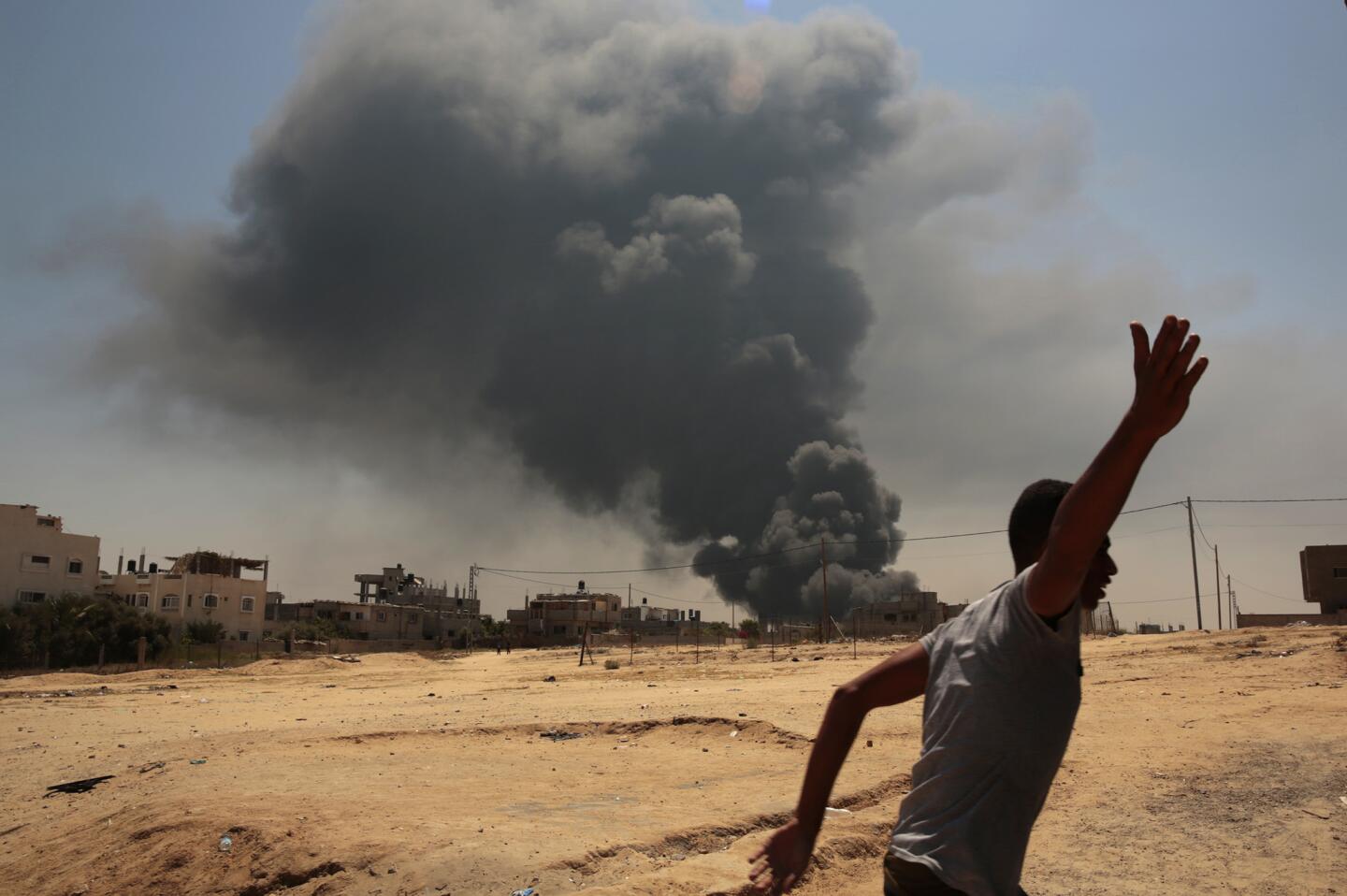
After a night of heavy bombardment by Israeli forces, smoke rises from a power plant outside the town of Bureij in the Gaza Strip on July 29, 2014. (Carolyn Cole / Los Angeles Times)
Scenes from the devastating war in the Gaza Strip between Israel and the militant group Hamas in 2014.
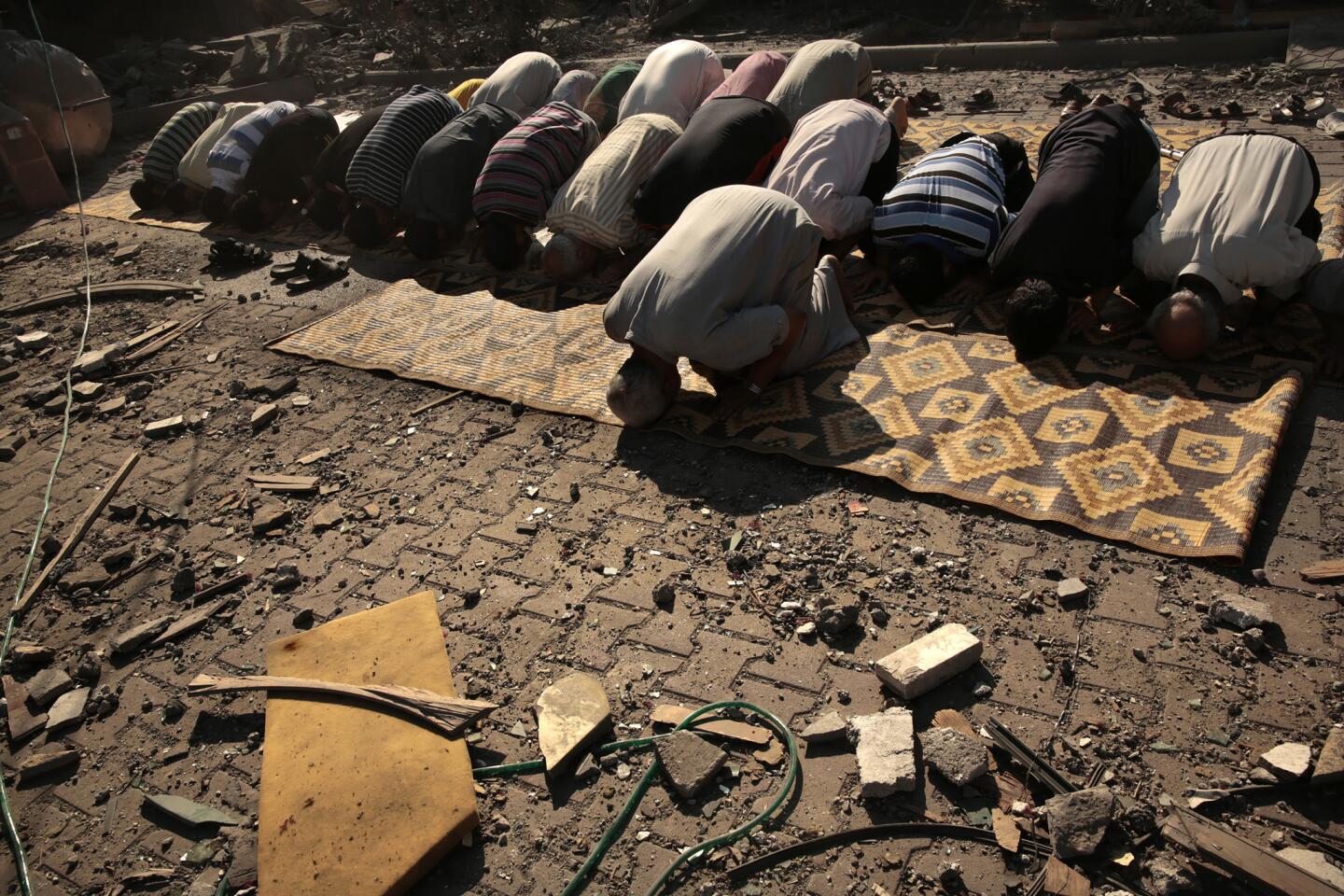
Men gather to pray outside the Ameen Mohammed mosque in Gaza City on July 29, 2014. The mosque was destroyed during a night of heavy bombing. (Carolyn Cole / Los Angeles Times)
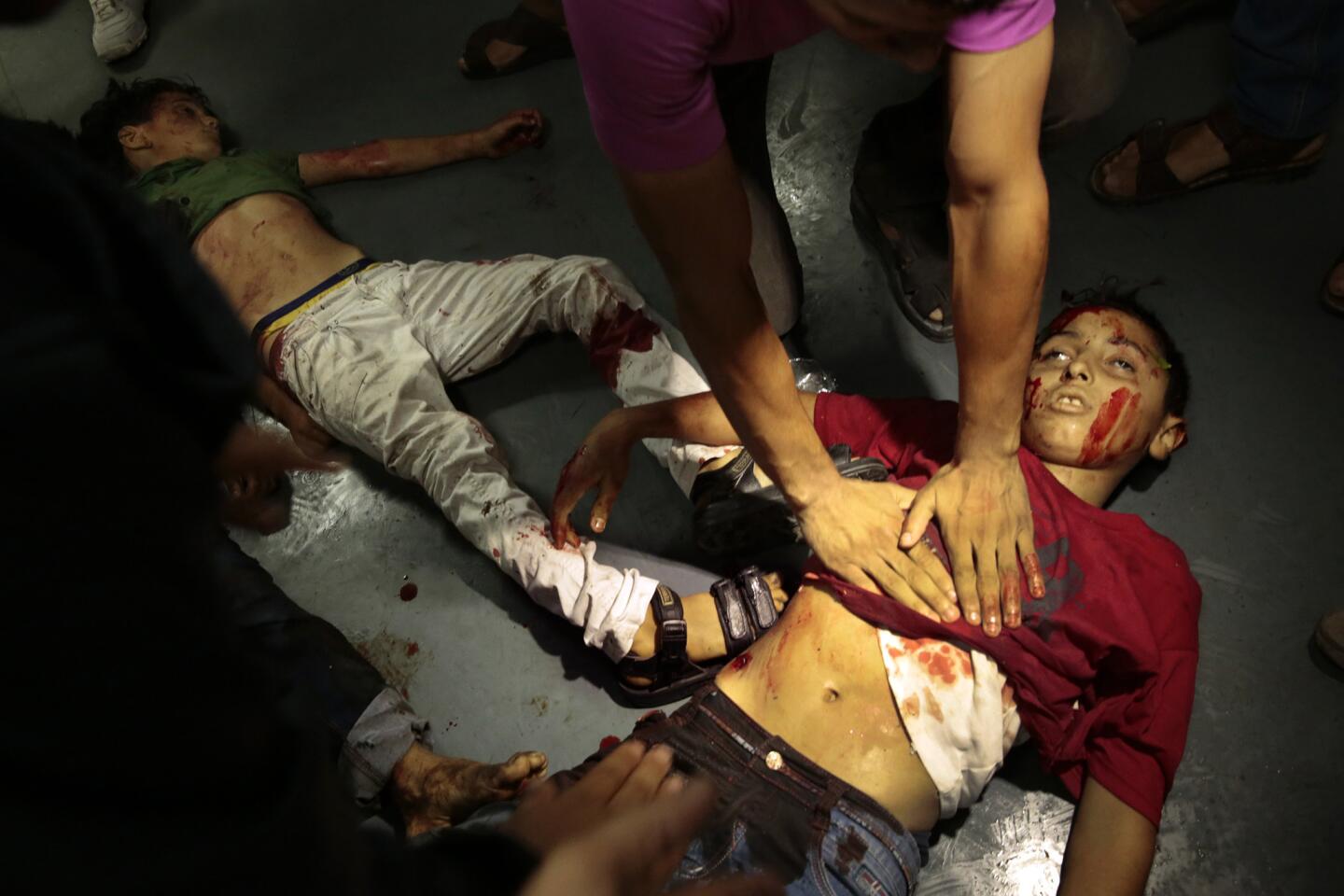
Dozens of children were killed during an explosion in Gaza City on July 28, 2014. The wounded were transported to Shifa Hospital. Some thought the cause of the blast was a misfired Kassam rocket. (Carolyn Cole / Los Angeles Times)
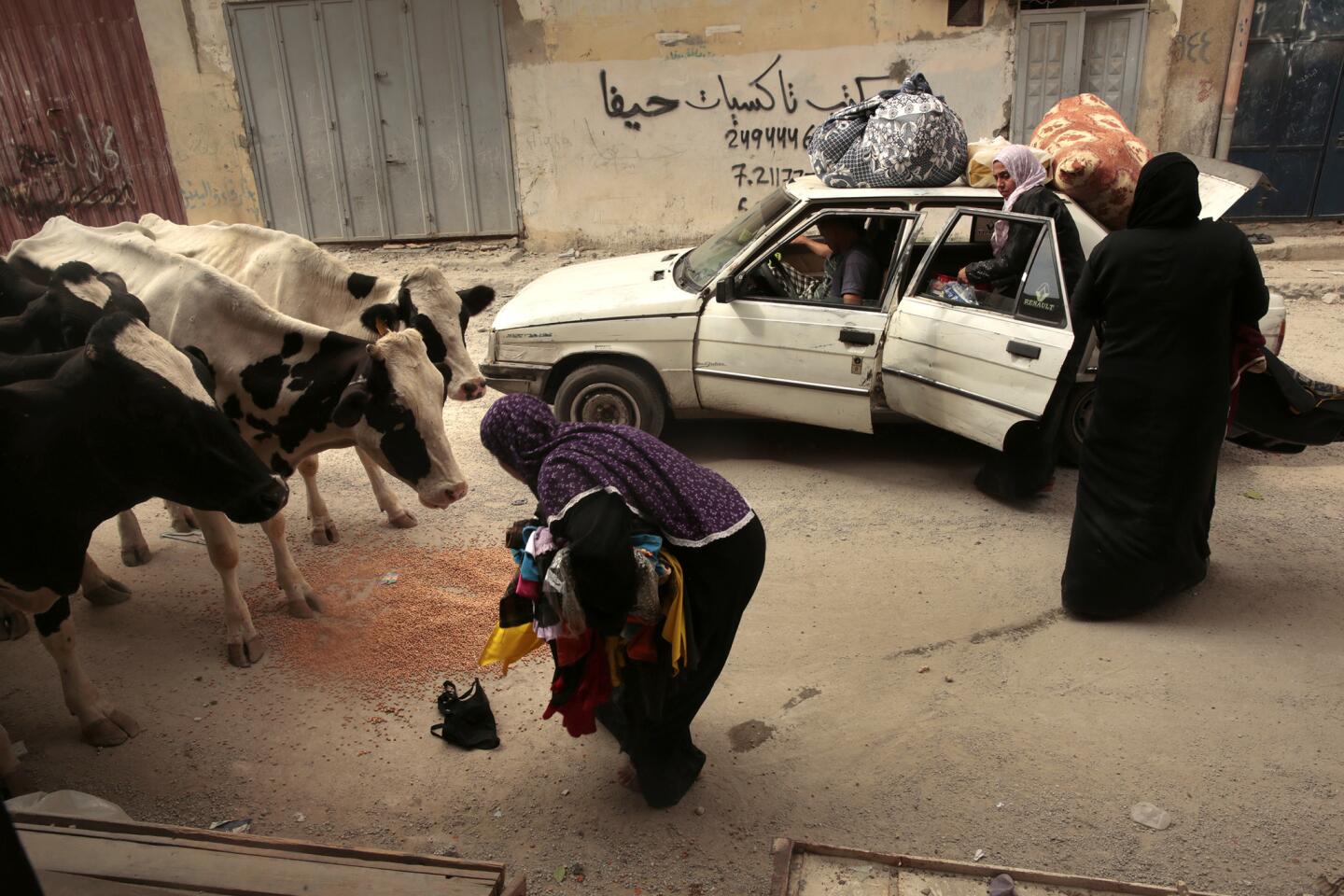
A family leaves the destroyed town of Beit Hanoun with their own belongings and some looted from a store on July 28, 2014, as starving cows gather to try to get food. (Carolyn Cole / Los Angeles Times)
Advertisement
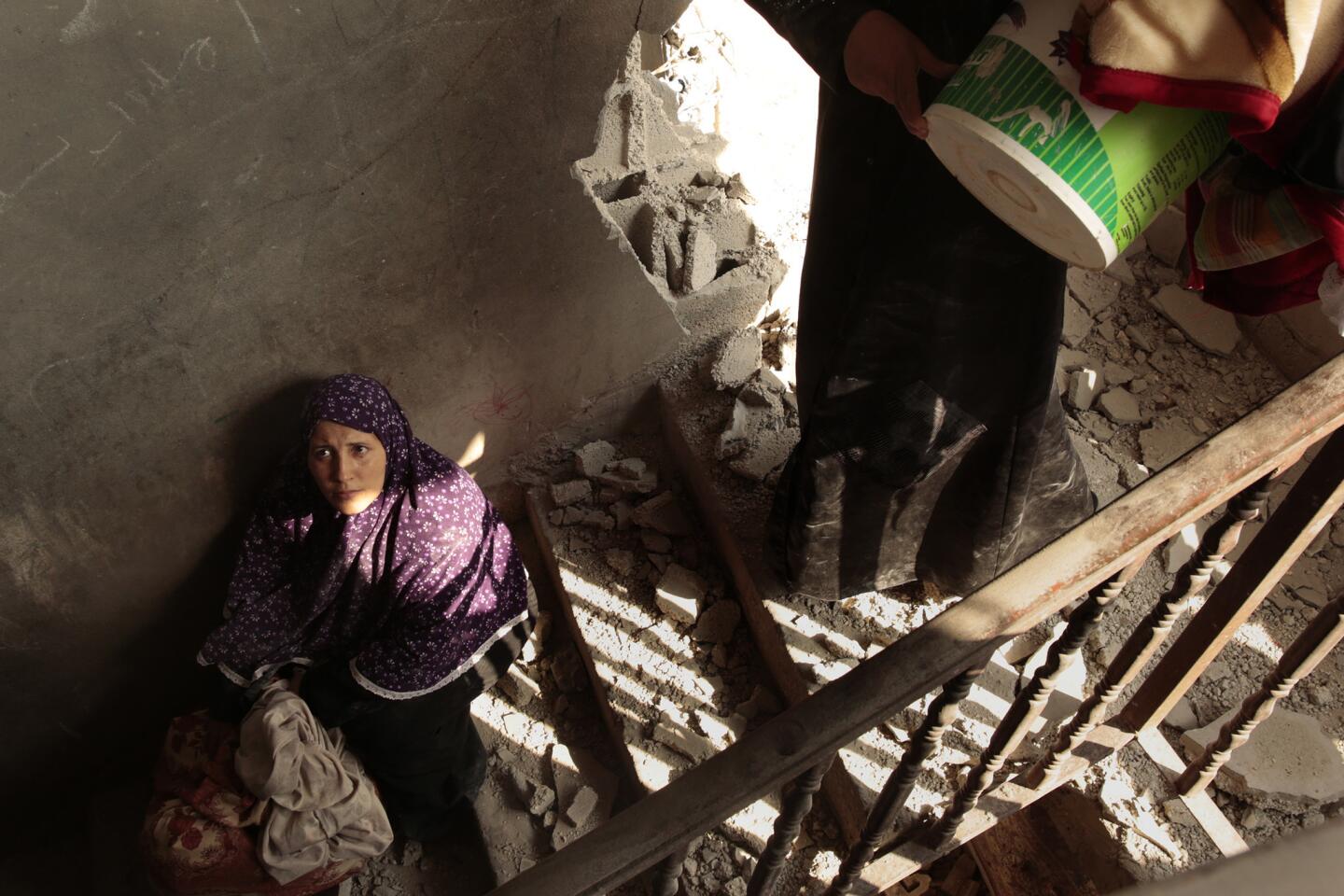
A pregnant woman rests on the stairs of a destroyed building on July 28, 2014, as she and other women return to salvage belongings in the town of Beit Hanoun. (Carolyn Cole / Los Angeles Times)
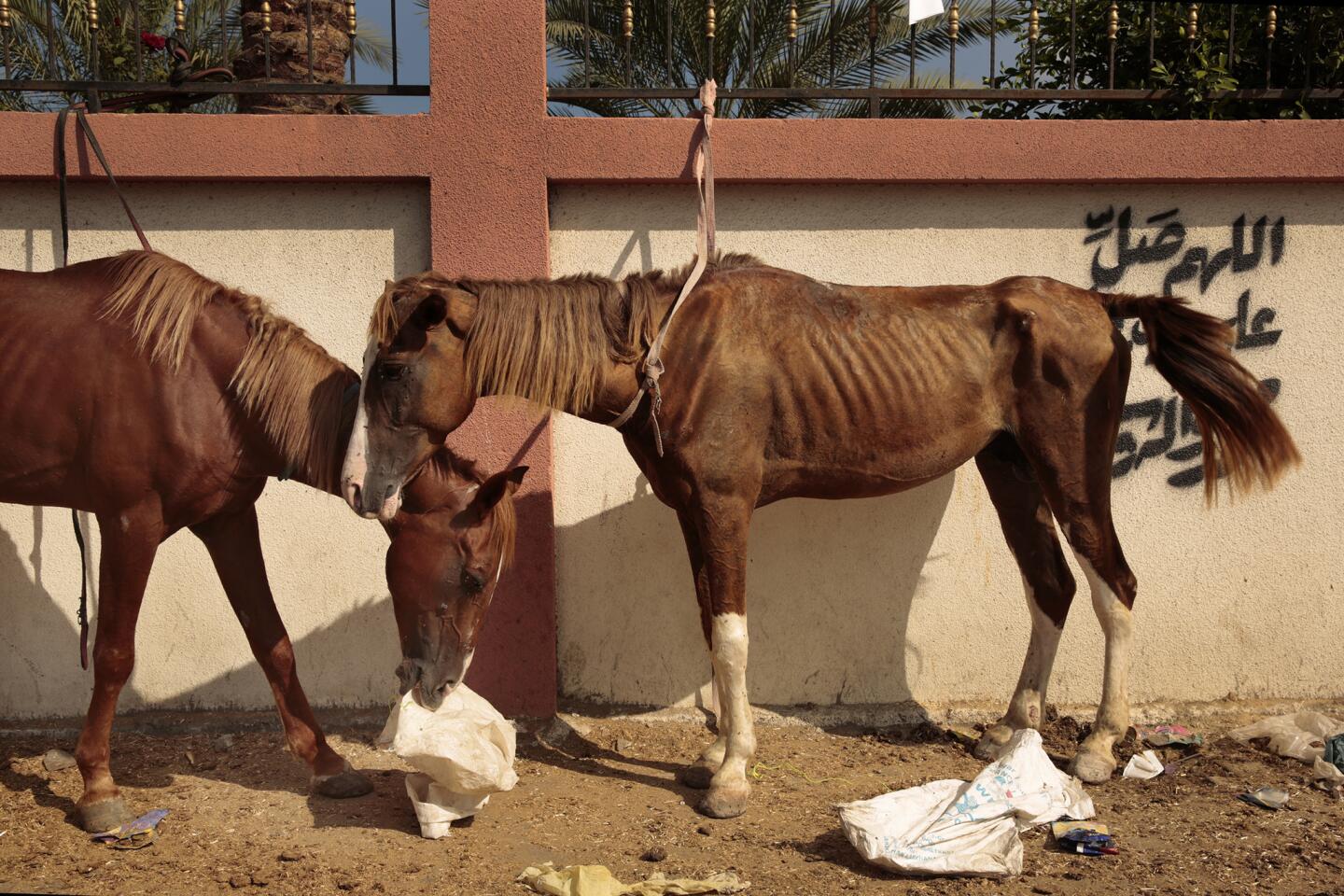
The working animals of Gaza suffer during the bombardment as two horses try to get food from and empty feed bag. (Carolyn Cole / Los Angeles Times)
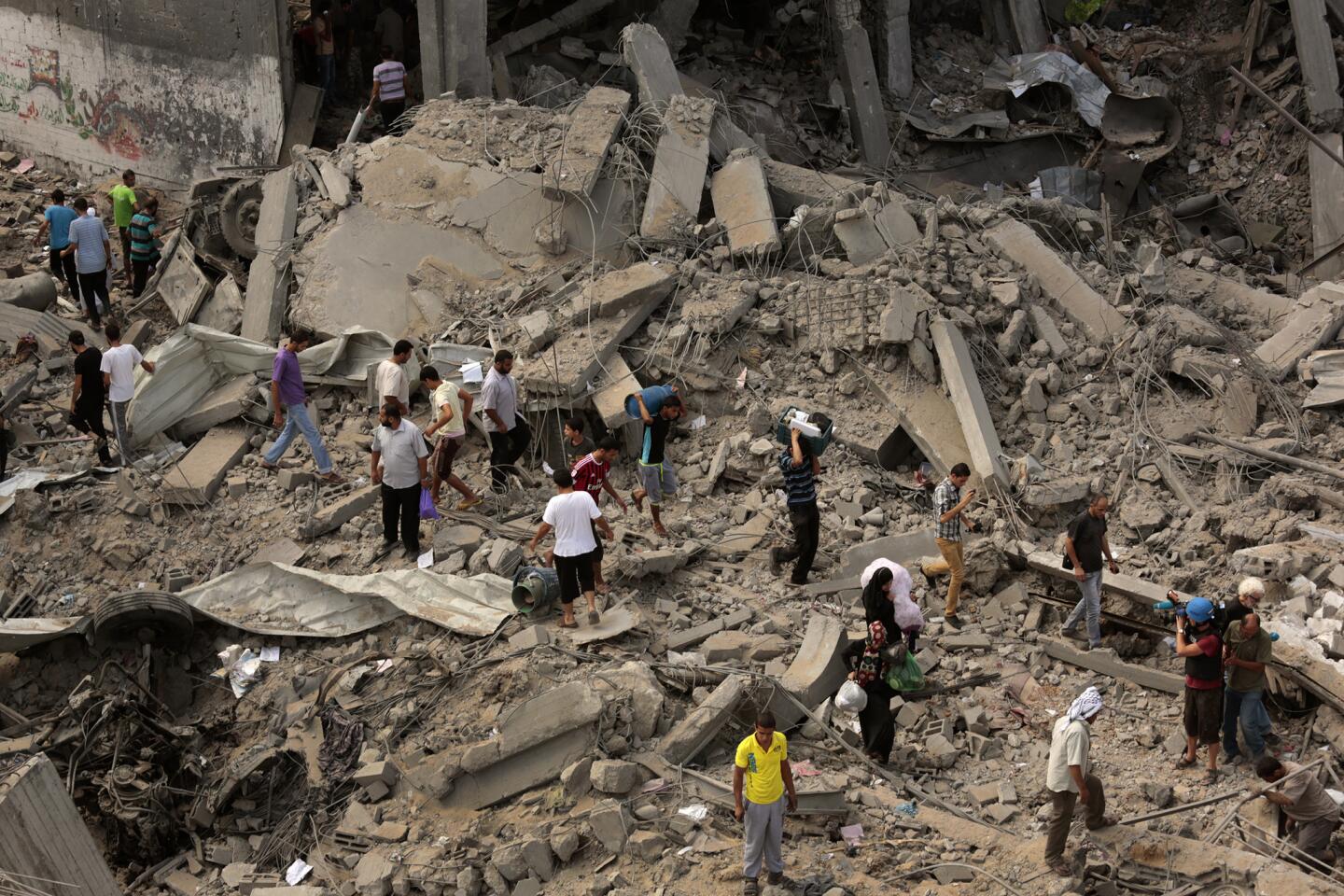
At the start of a 12-hour ceasefire, people scour the rubble of their homes in Shejaiya neighborhood looking for the dead and recovering belongings. (Carolyn Cole / Los Angeles Times)
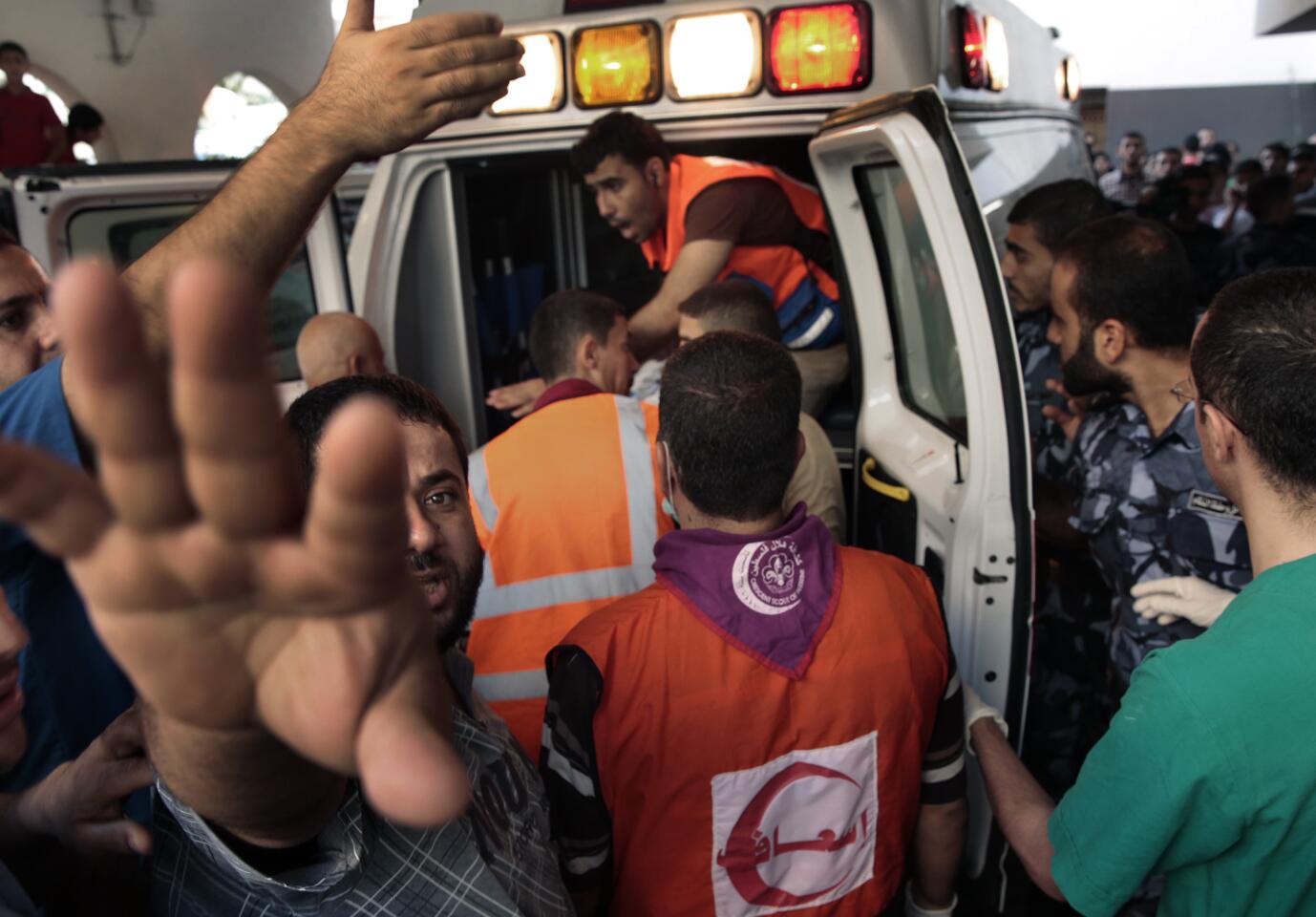
Security and hospital personnel prevent photographs from being taken as an injured Hamas fighter arrives at the hospital in Gaza City. (Carolyn Cole / Los Angeles Times)
Advertisement
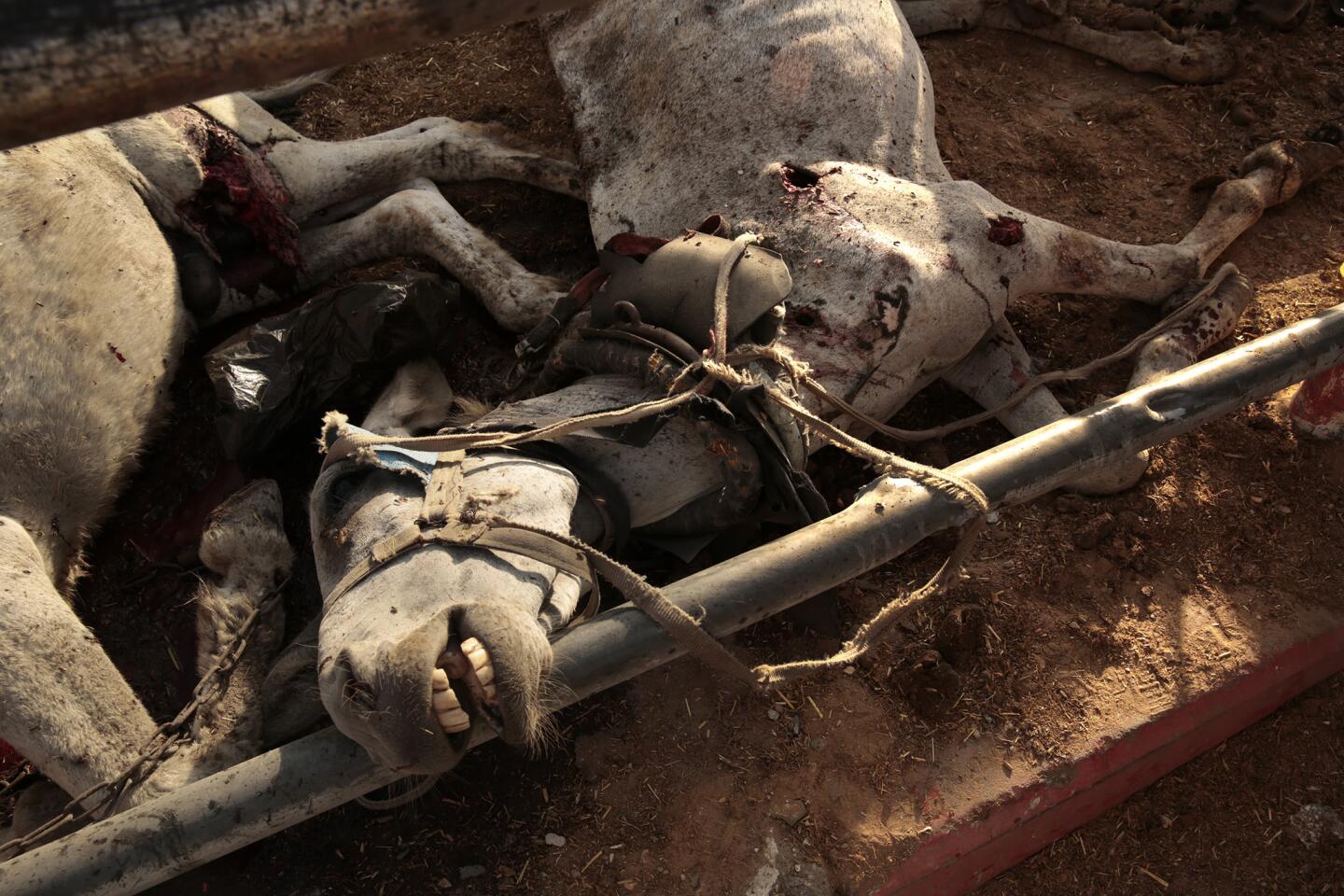
Dead donkeys lie in the courtyard outside of a school in Jabaliya, Gaza, that was hit by Israeli tank shelling. (Carolyn Cole / Los Angeles Times)
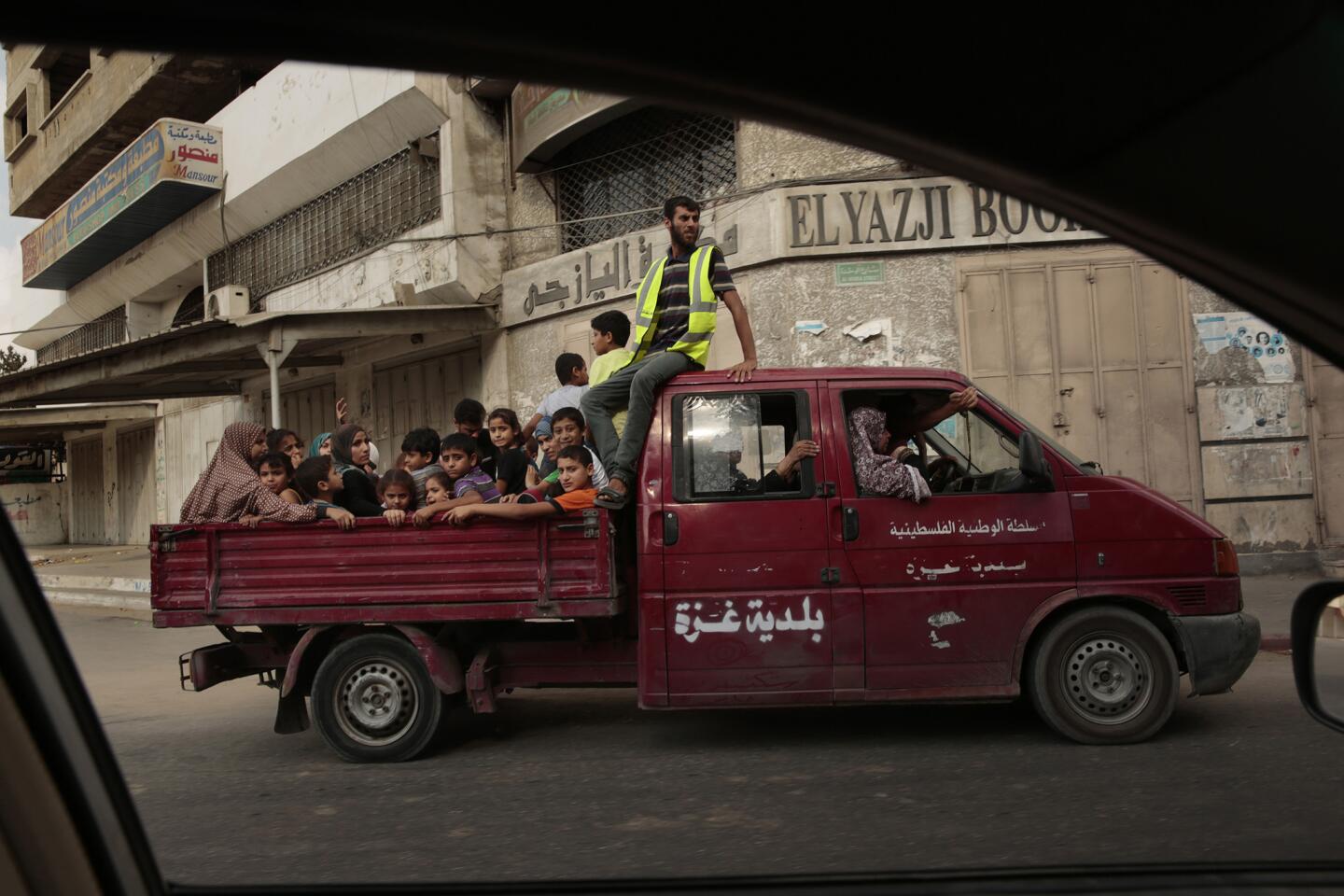
Carrying men, women and children evacuate Shajaiya area of eastern Gaza City. (Carolyn Cole / Los Angeles Times)
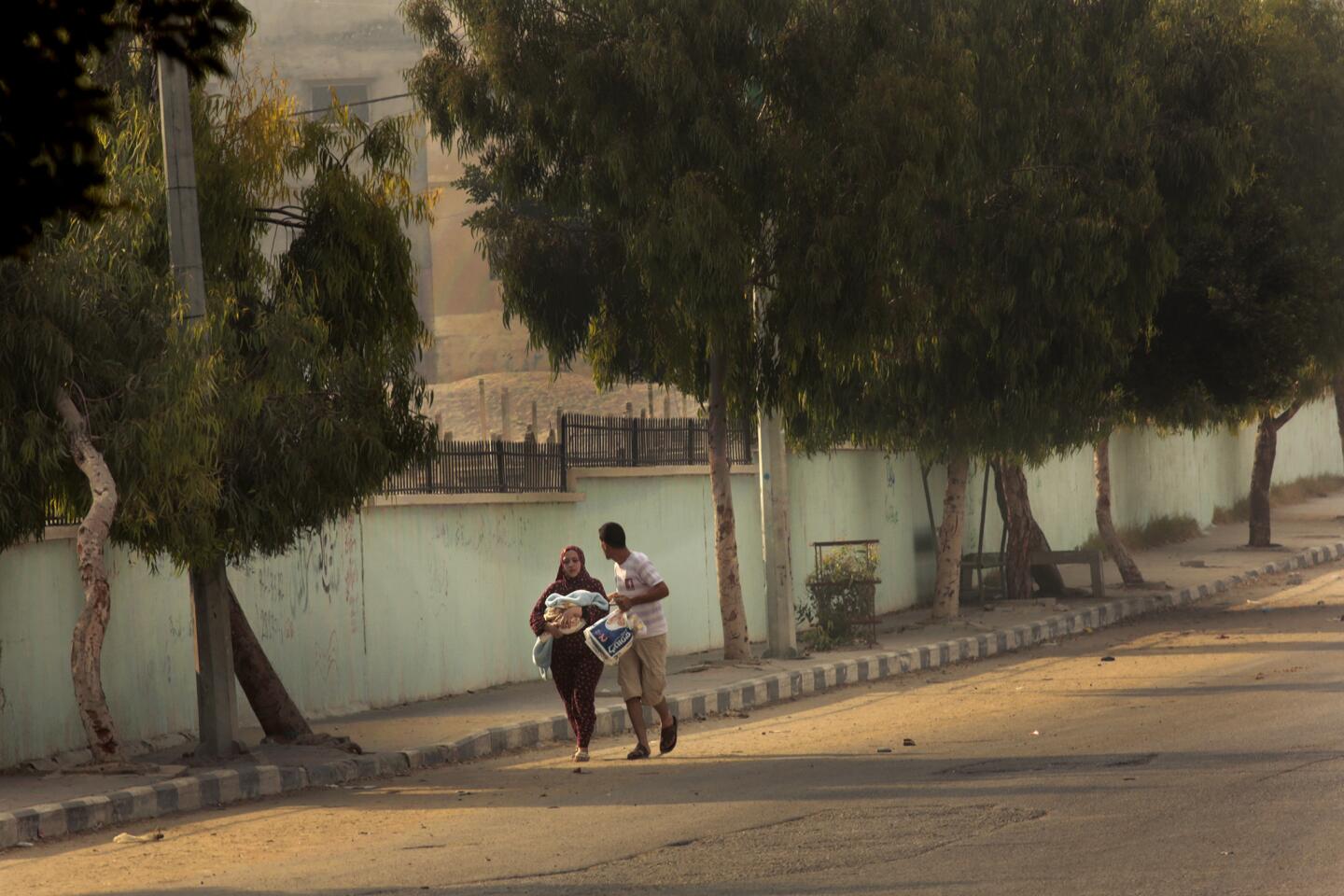
A man and woman run with a baby away from the fighting in the Shajaiya area of eastern Gaza City. (Carolyn Cole / Los Angeles Times)
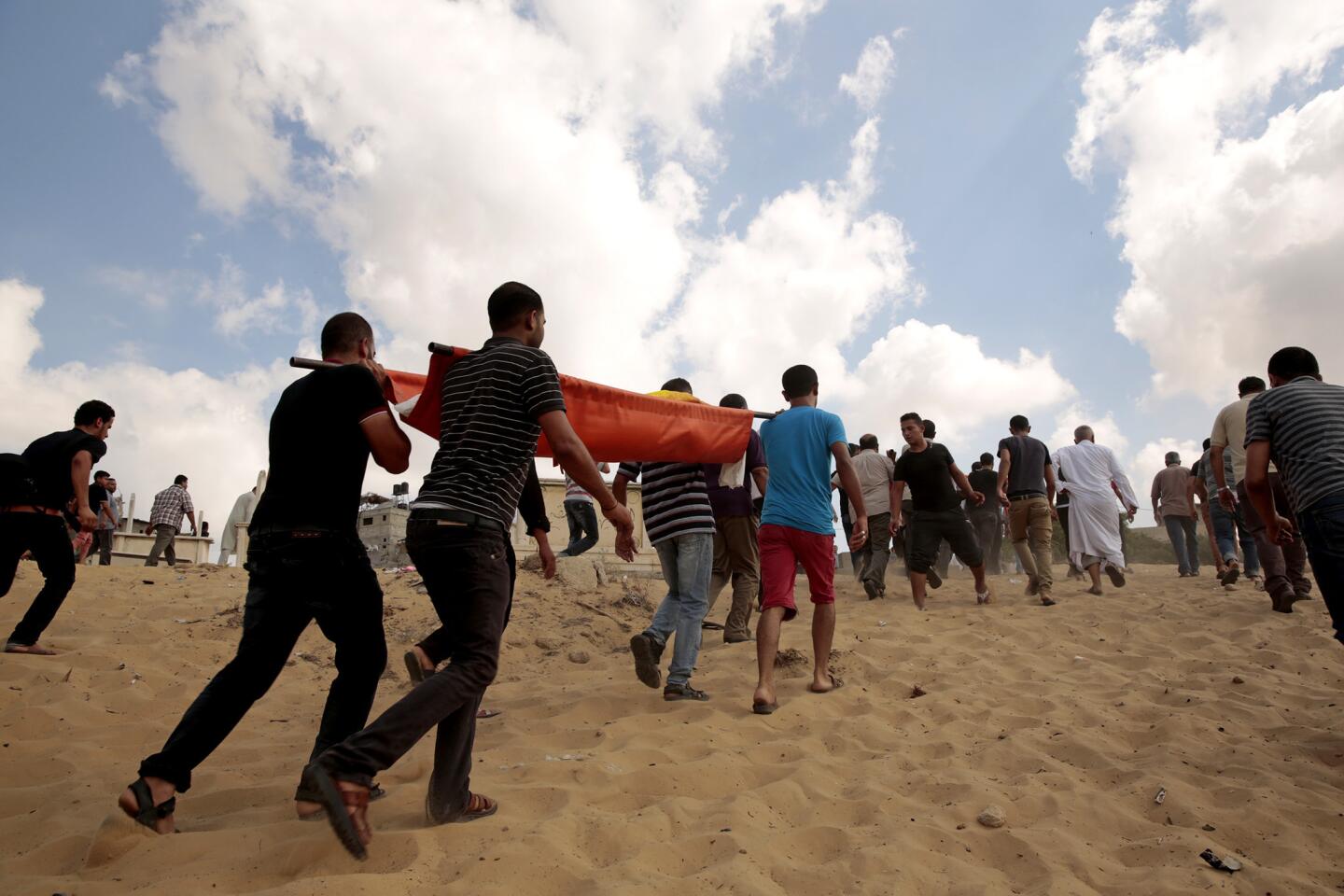
Men carry the bodies of those killed in a recent bombing by Israeli forces. Eight members of the Abu Jarad family were killed in an Israeli strike on a house in Beit Hanoun in northern Gaza Strip, including four children. Friends and relatives grieve as their bodies are taken from the hospital morgue to the mosque and on to the cemetery. (Carolyn Cole / Los Angeles Times)
Advertisement
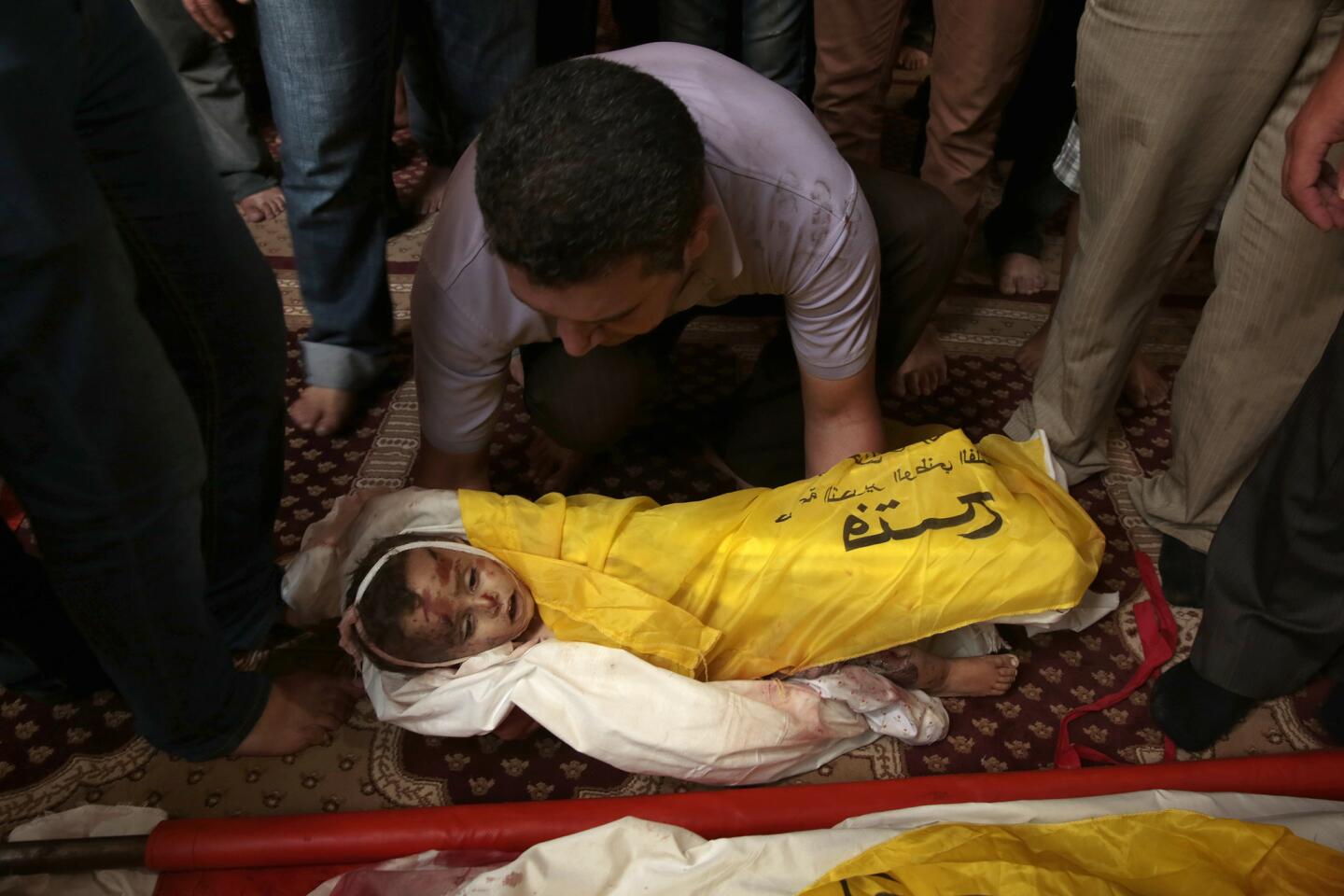
The body of one of four small children is laid on the mosque floor where men came to pray before the burial. Eight members of the Abu Jarad family were killed in an Israeli strike on a house in Beit Hanoun in northern Gaza Strip, including four children. (Carolyn Cole / Los Angeles Times)
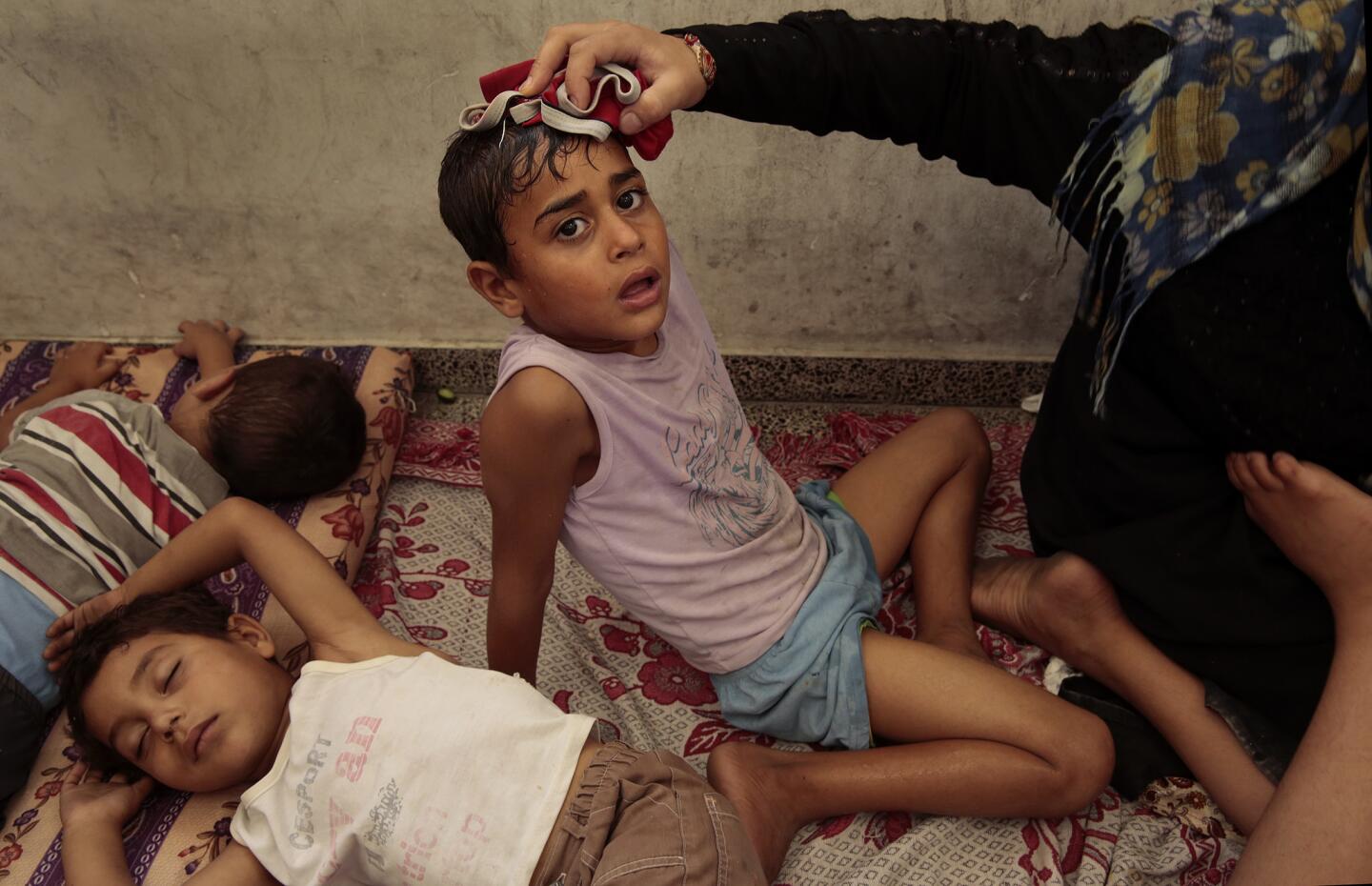
Newly displaced children sleep on the floor at the Jabalia Prep A Boys School, in Gaza. (Carolyn Cole / Los Angeles Times)
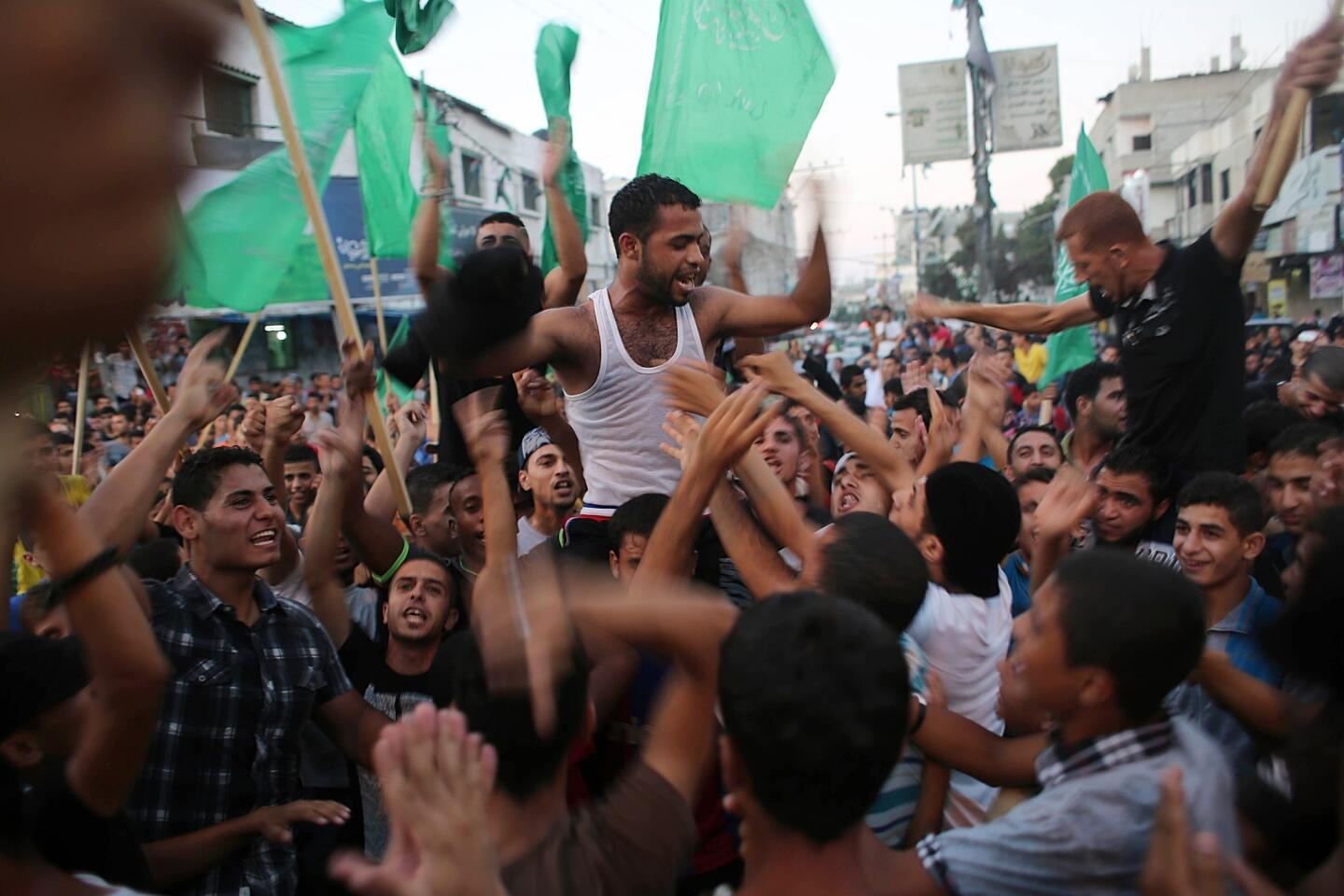
Palestinians gather in the streets of Rafah in the southern Gaza Strip to celebrate on Aug. 26 after a long-term cease-fire deal was reached between Hamas and Israel. (Said Khatib / AFP/Getty Images)
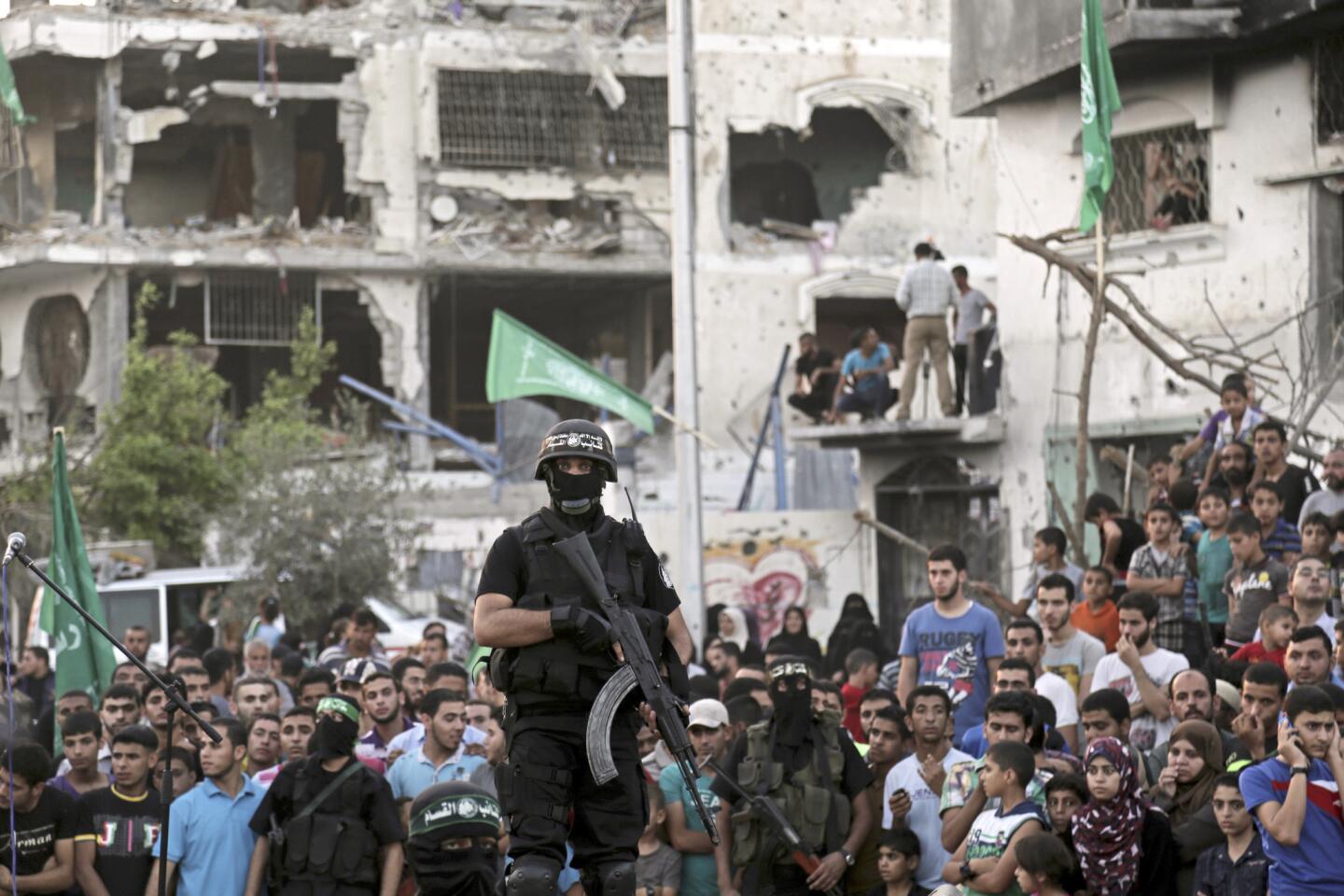
Masked Palestinian militants and their supporters celebrate news of a cease-fire during an Aug 27 rally among the debris of destroyed houses in the Shijaiyah neighborhood of Gaza City. (Adel Hana / Associated Press)
Advertisement
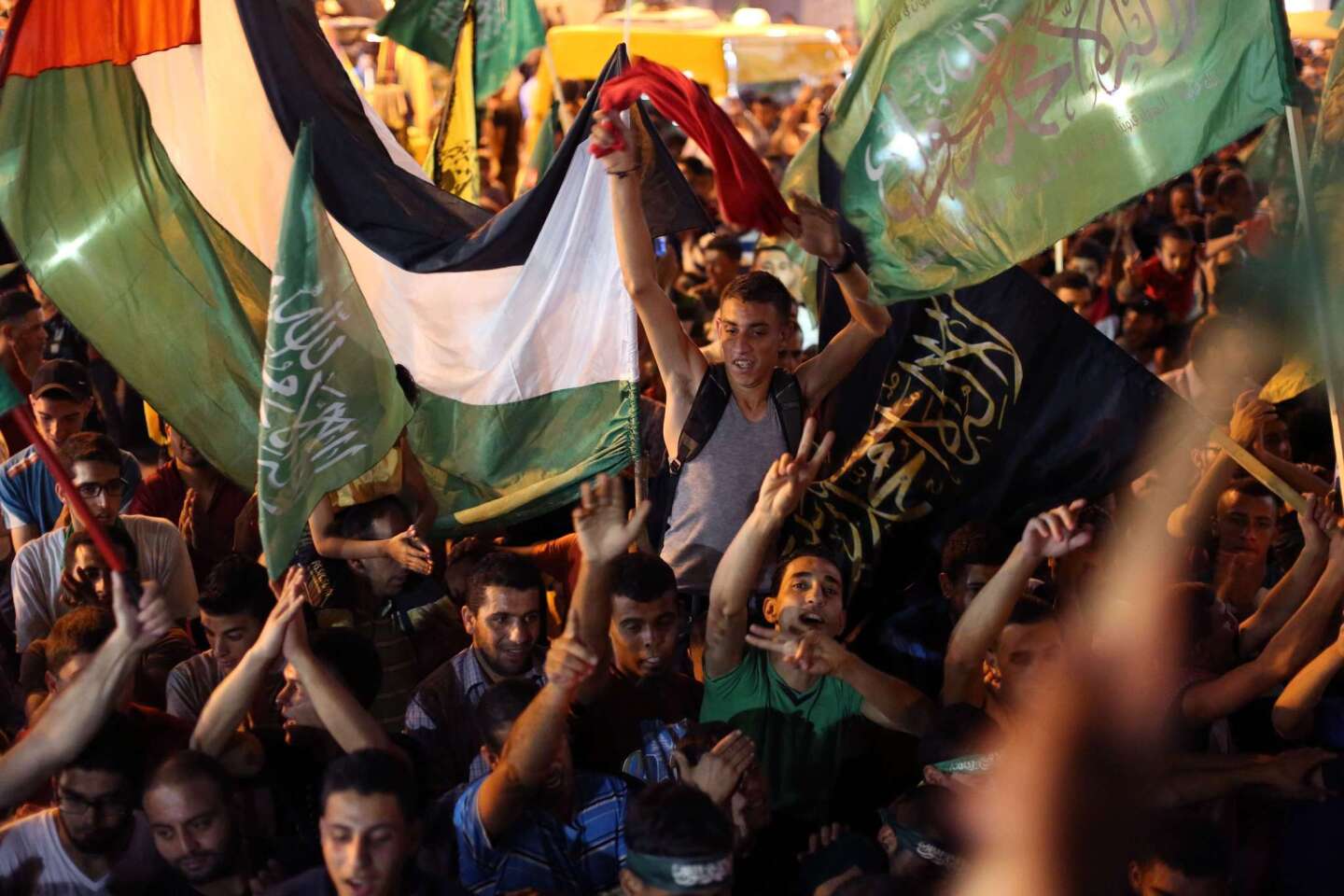
Palestinians celebrate news of a Gaza cease-fire deal in the West Bank city of Ramallah on Aug. 26. (Abbas Momani / AFP/Getty Images)
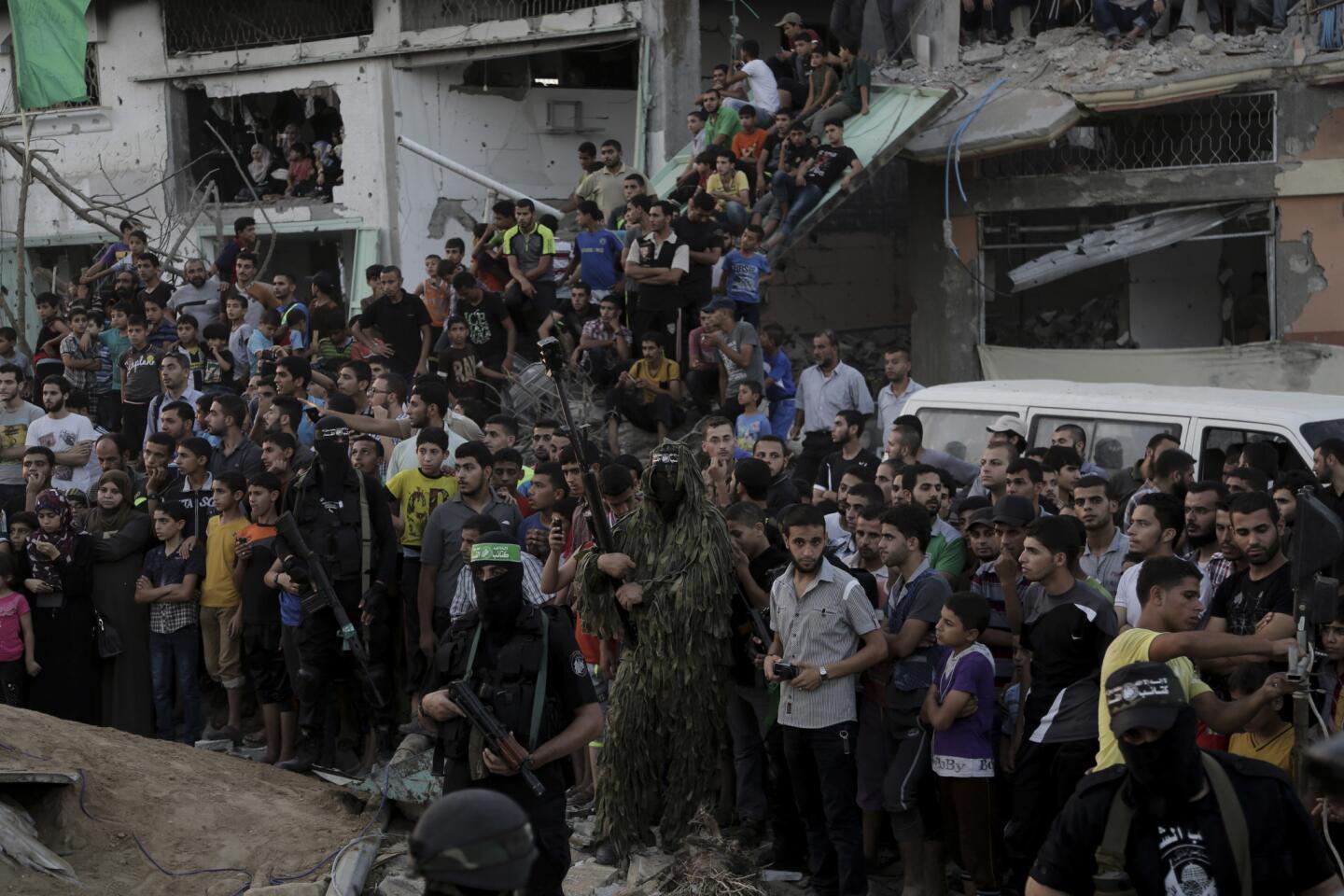
Members of the military wing of Hamas and their supporters celebrate a cease-fire deal in the Shijaiyah neighborhood of Gaza City on Aug. 27. (Adel Hana / Associated Press)
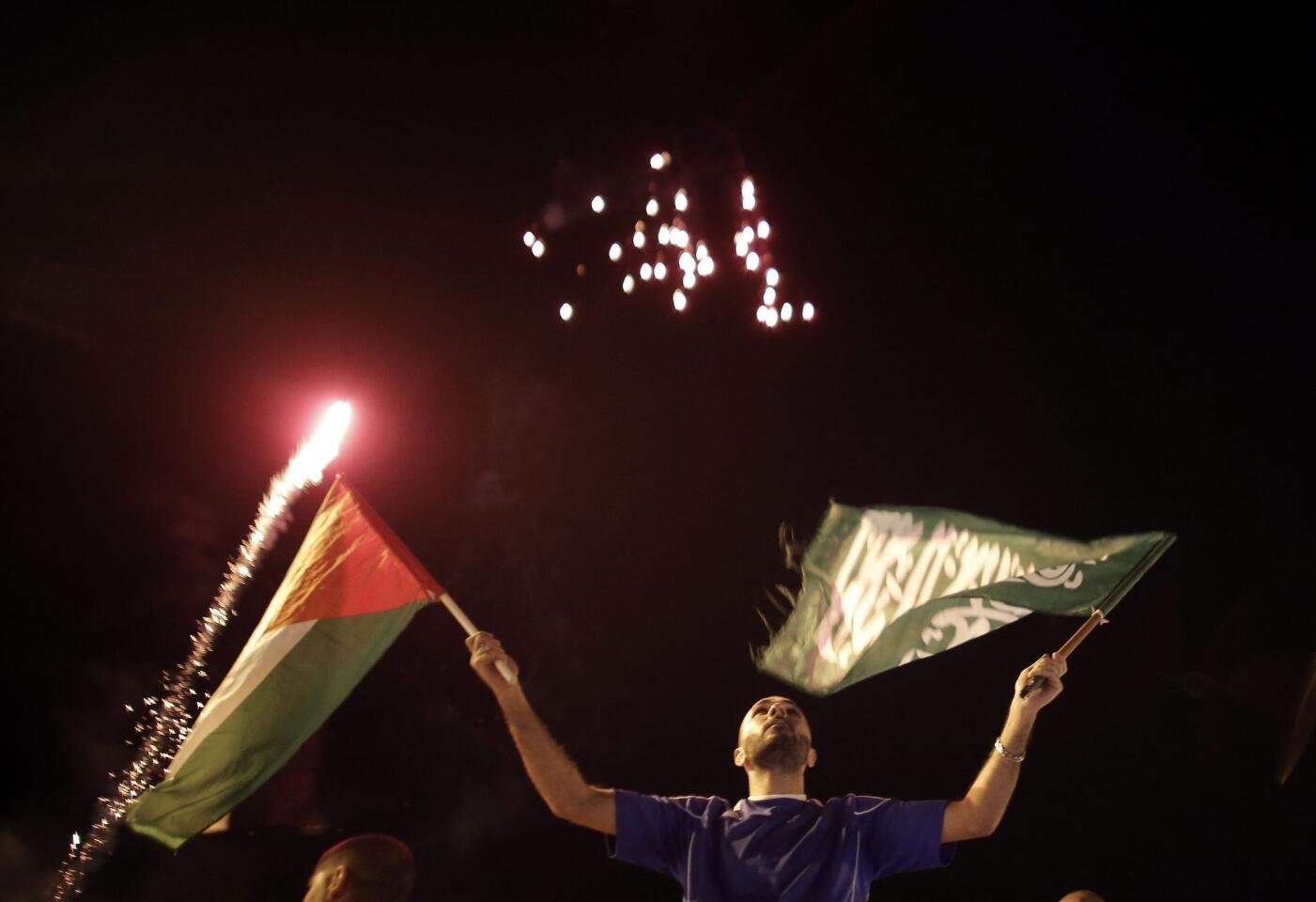
A Palestinian waves flags as fireworks light up the sky in East Jerusalem during an Aug. 26 celebration of a Gaza cease-fire agreement. (Ahmad Gharabli / AFP/Getty Images)
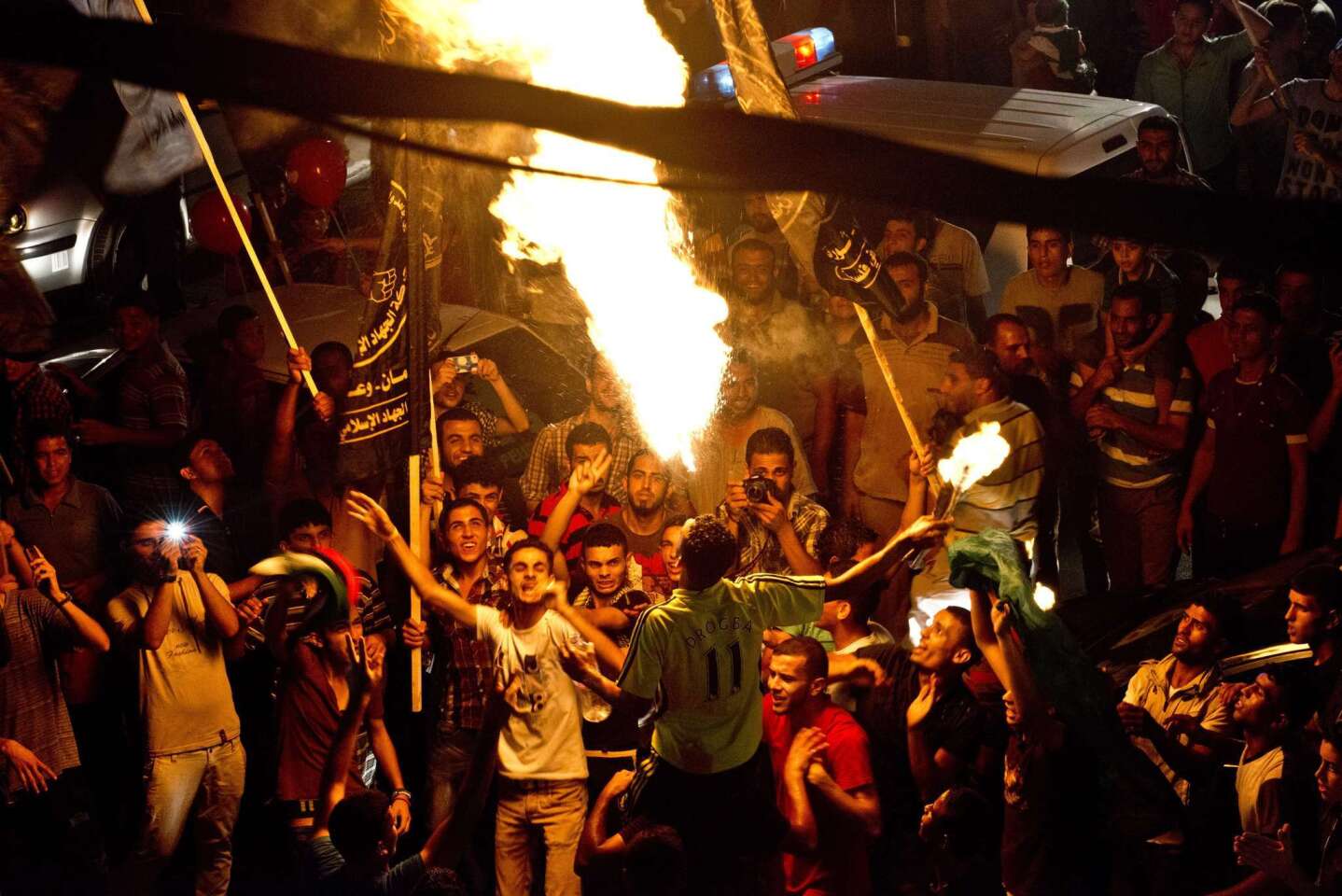
A Palestinian man blows fire as Gazans gather at an intersection to celebrate the cease-fire between Israel and Hamas in Gaza City on Aug. 26. (Roberto Schmidt / AFP/Getty Images)
Advertisement
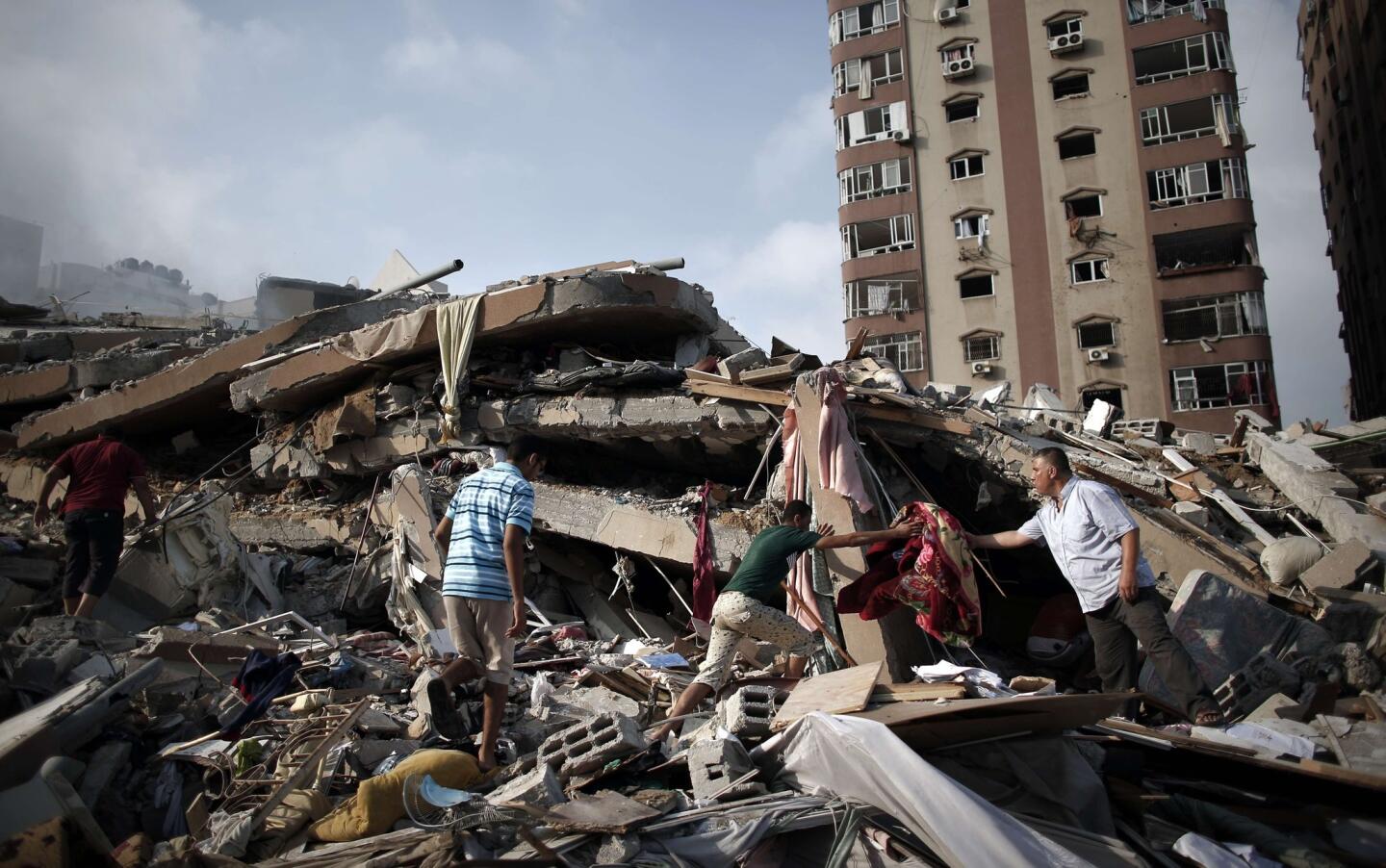
Palestinians collect items from the rubble of a 12-story apartment building that collapsed Aug. 23 after it was hit by an Israeli airstrike in Gaza City. (Thomas Coex / AFP/Getty Images)
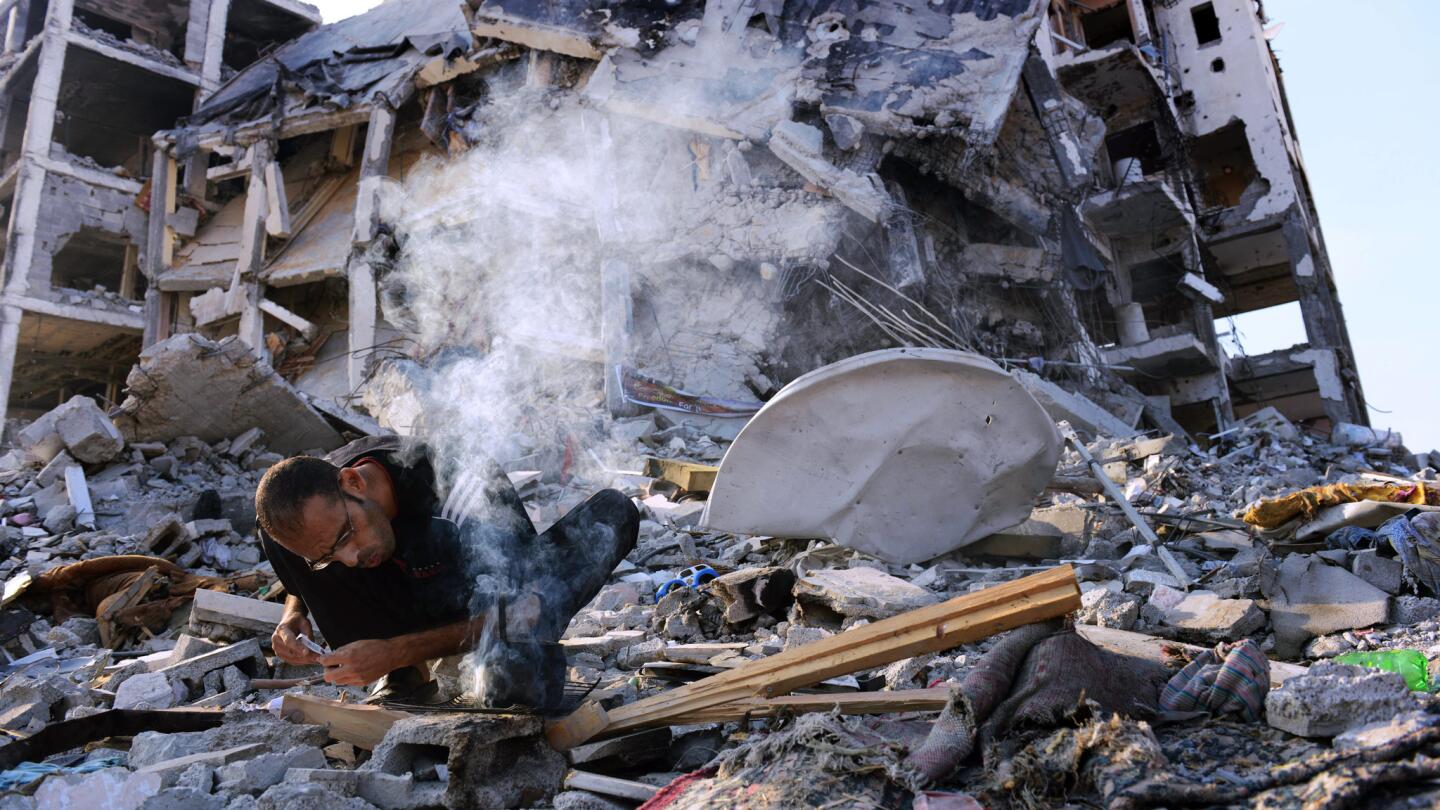
Mohammed Abu Ghama starts a small fire to heat water for tea in the rubble of a Gaza apartment complex heavily damaged in fighting between Israel and Hamas. (Roberto Schmidt / AFP/Getty Images)
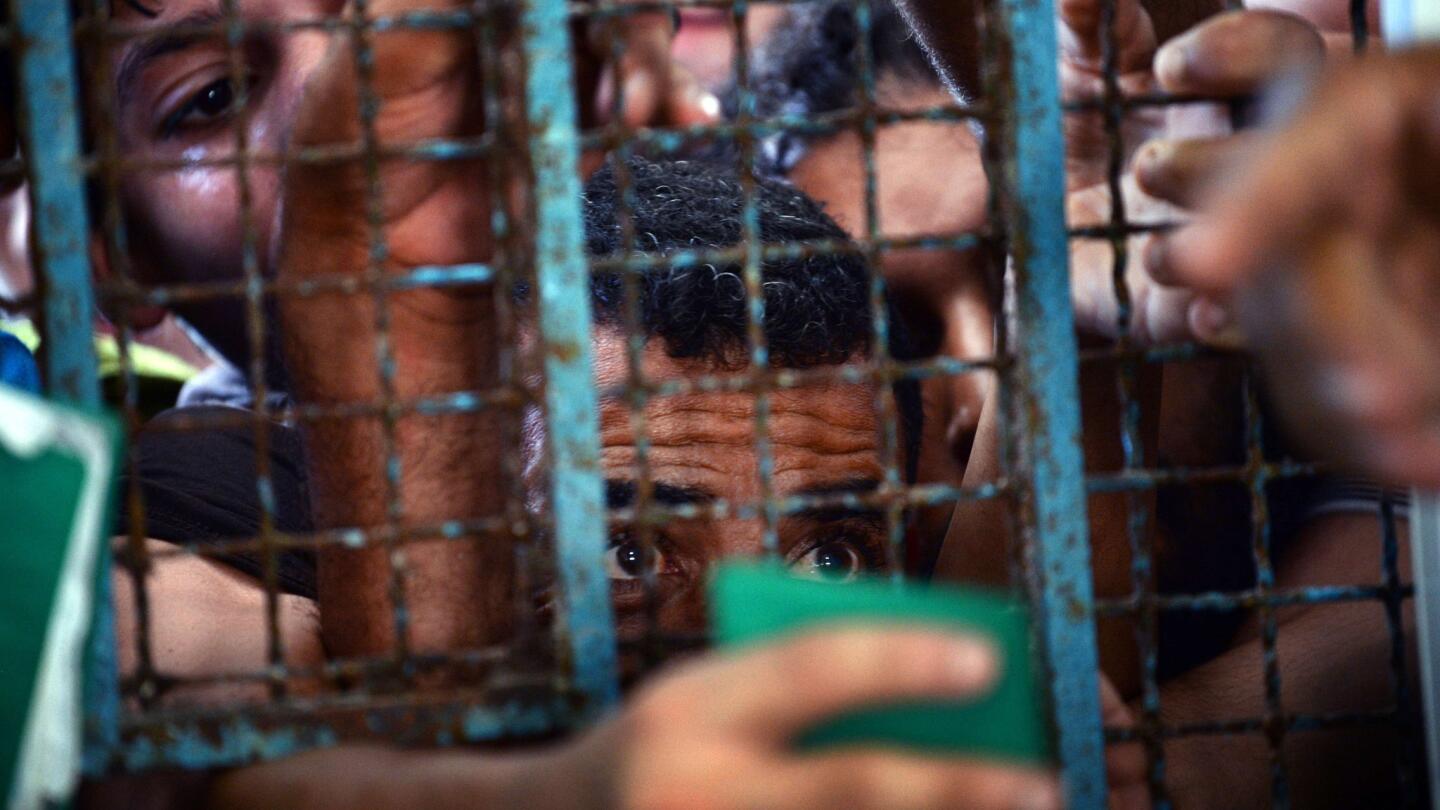
Palestinian men present their IDs to receive food aid at a United Nations facility in Gaza City. (Roberto Schmidt / AFP/Getty Images)
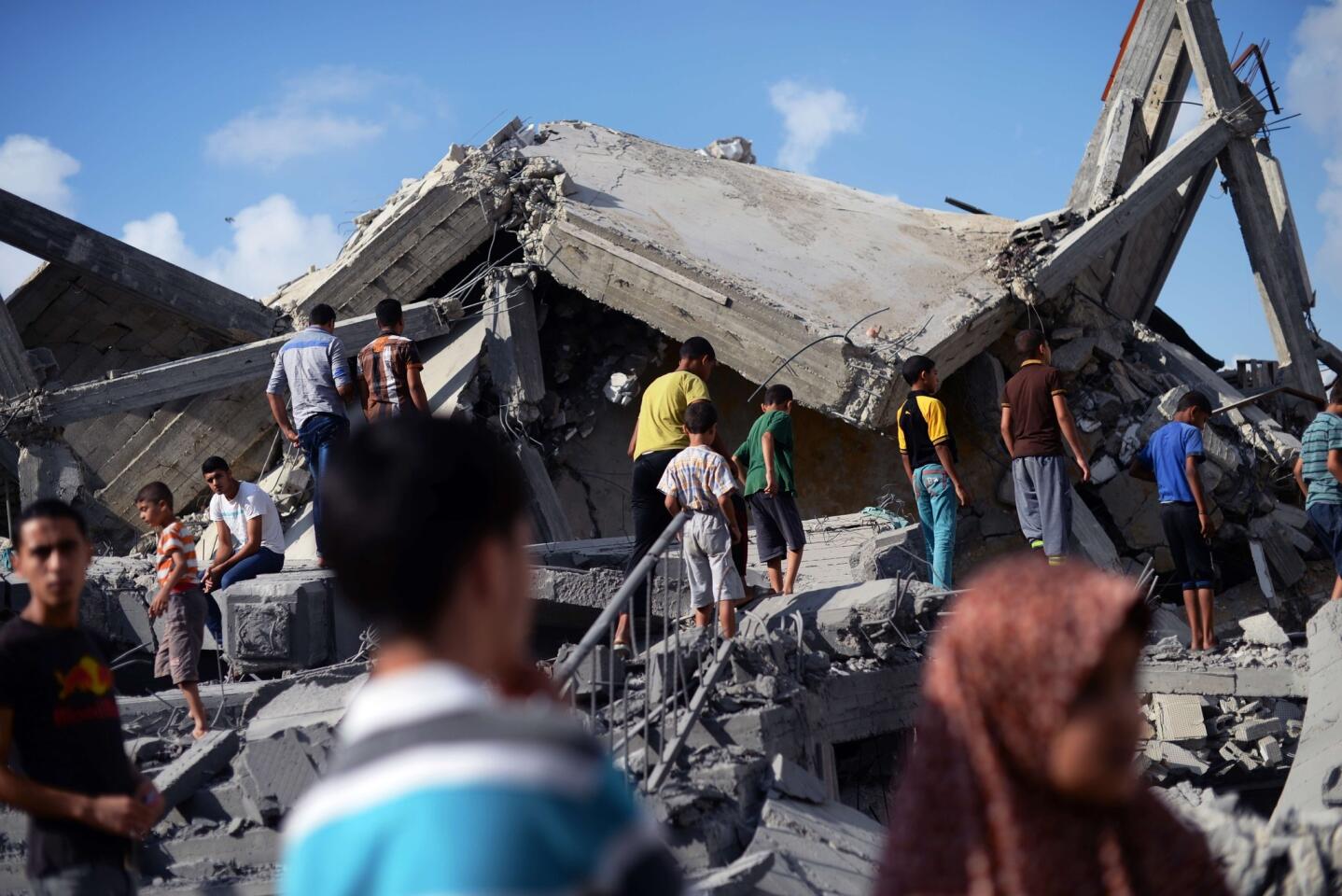
Palestinian boys walk on the bombed out remains of a mosque that was targeted by Israeli airstrikes in Nuseirat, central Gaza. (Roberto Schmidt / AFP/Getty Images)
Advertisement
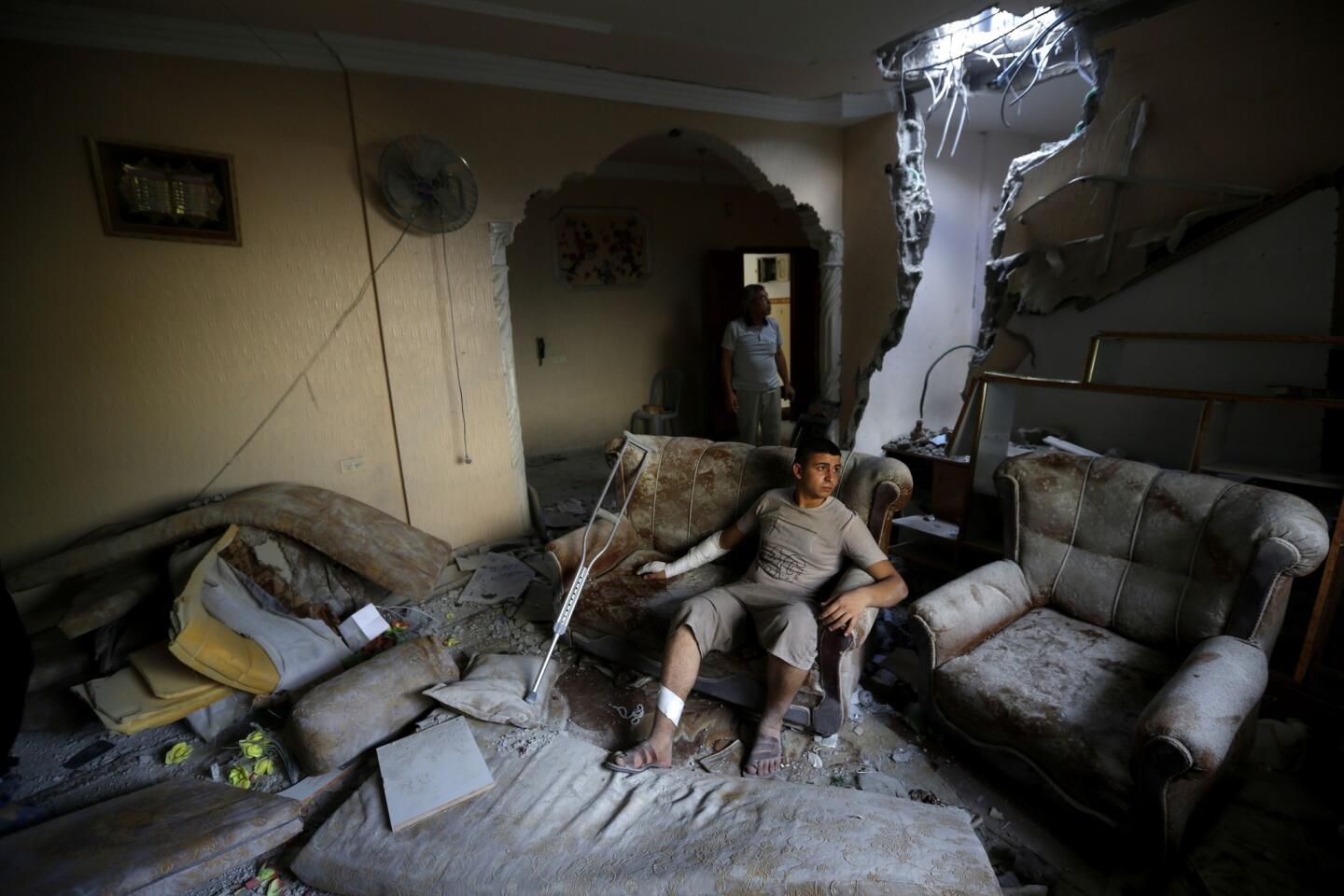
An injured Palestinian man sits in his ruined house after an Israeli military strike in the Jabalia refugee camp, in the northern Gaza Strip. (Mohammed Abed / AFP/Getty Images)
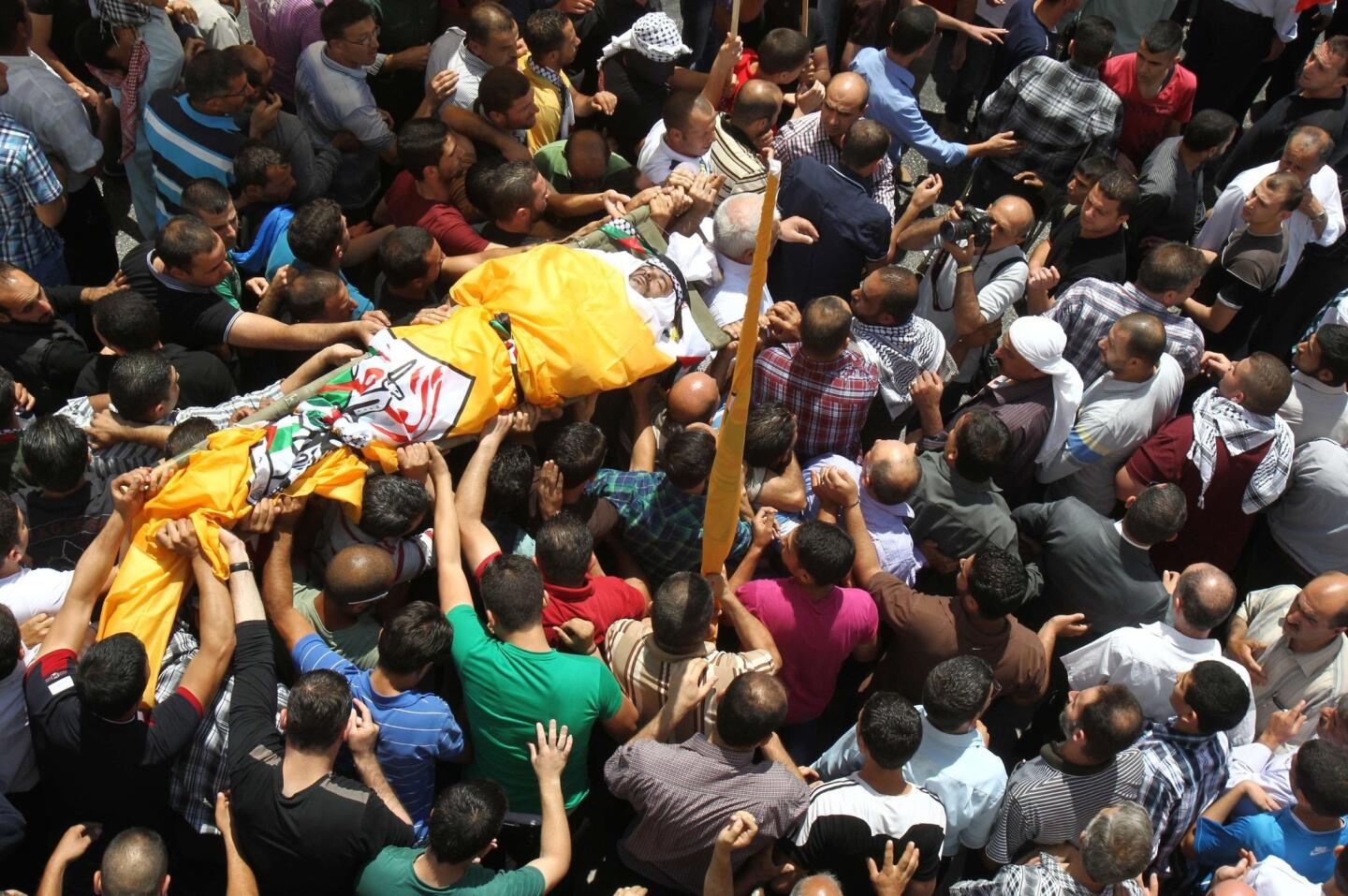
Mourners carry the body of Palestinian Nader Edriss, 22, at his funeral in the West Bank town of Hebron. Edriss was wounded by the Israeli army at a protest against the Israeli offensive in Gaza, and died from his injuries at Hebron’s Mizan hospital. (Hazem Bader / AFP/Getty Images)
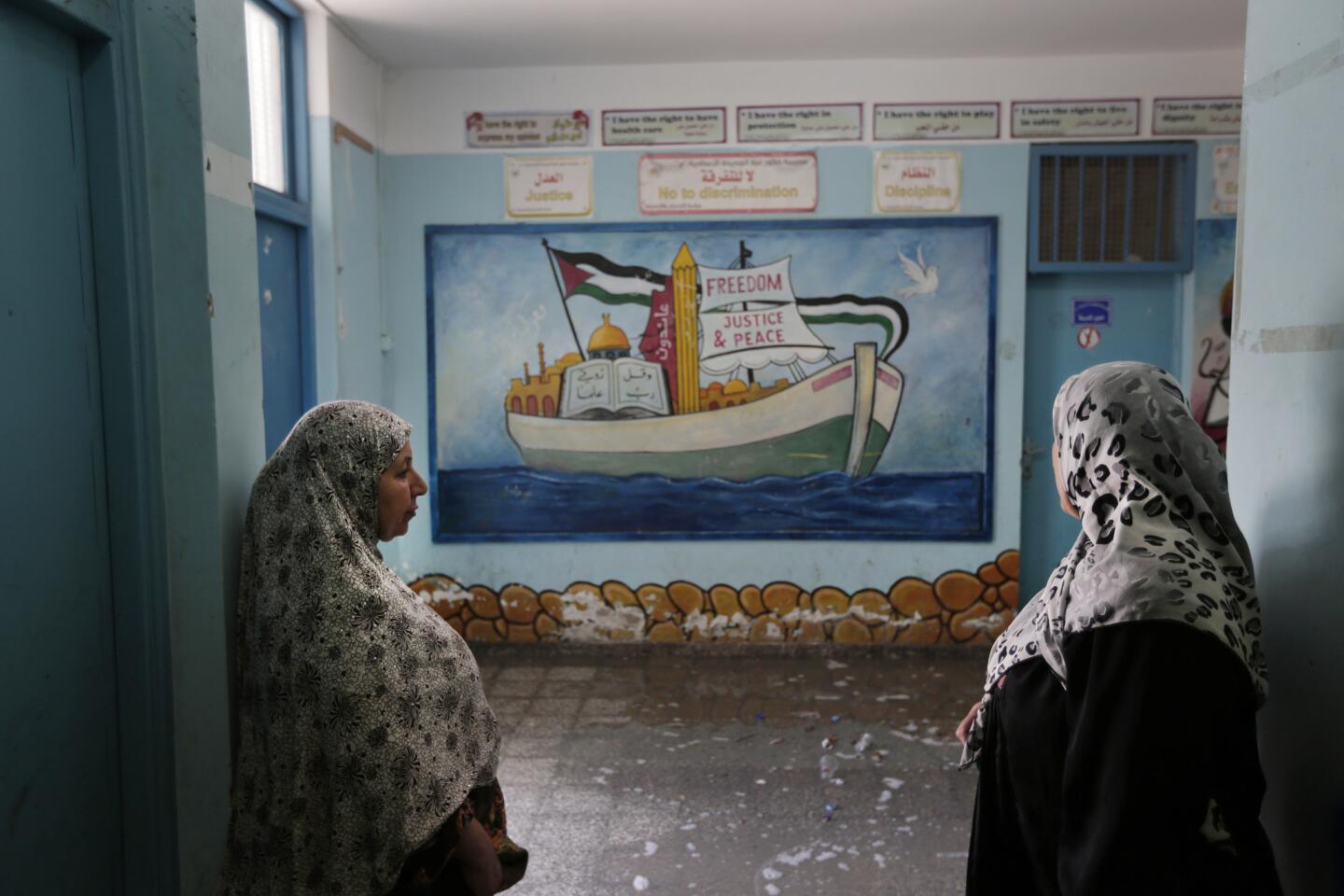
Displaced Palestinians stand in the hallway of a U.N. school where families are taking refuge during the war, in Gaza City, on Friday, Aug. 8, 2014. (Lefteris Pitarakis / AP)
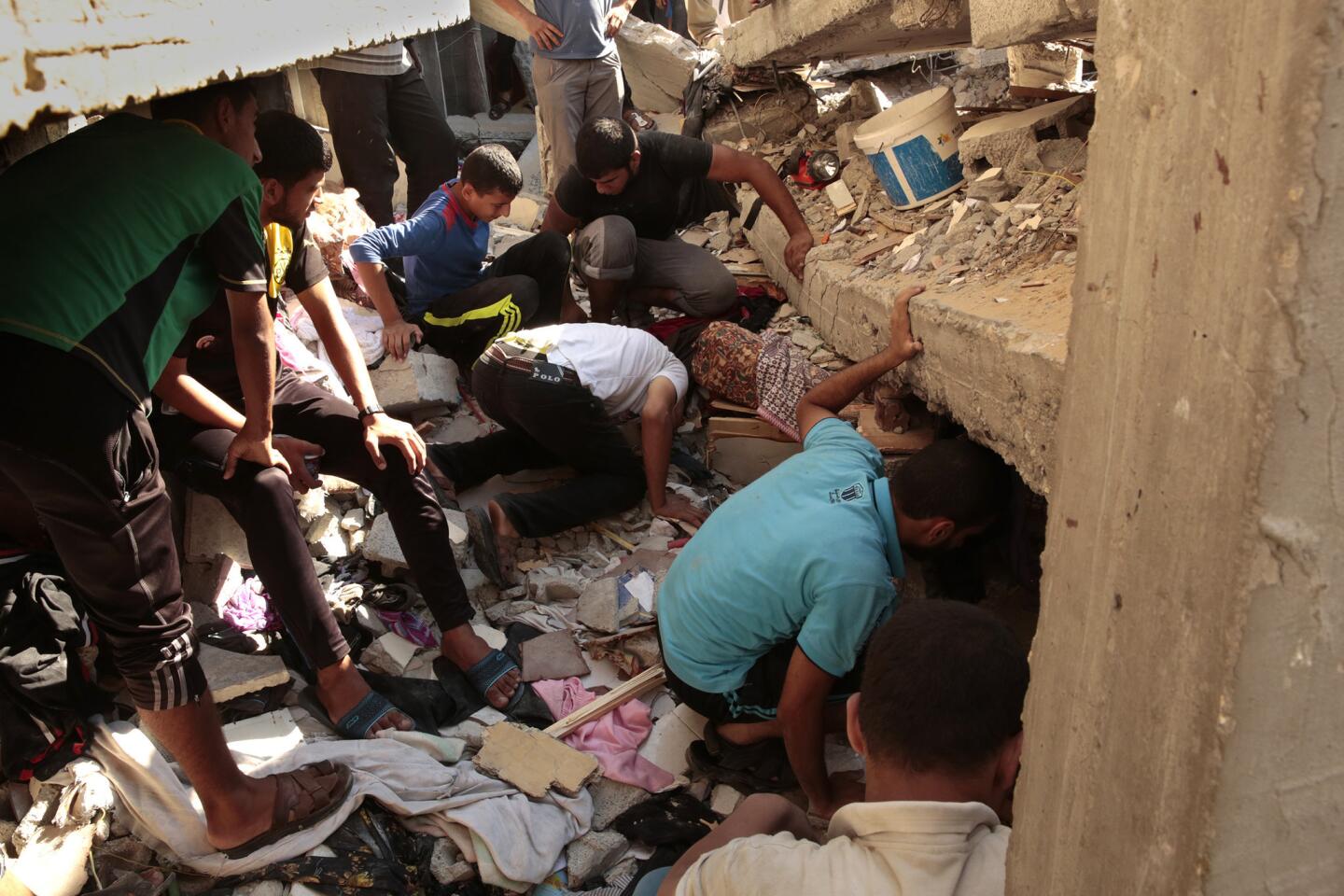
Four people are still missing after an Israeli air strike. (Carolyn Cole / Los Angeles Times)
Advertisement
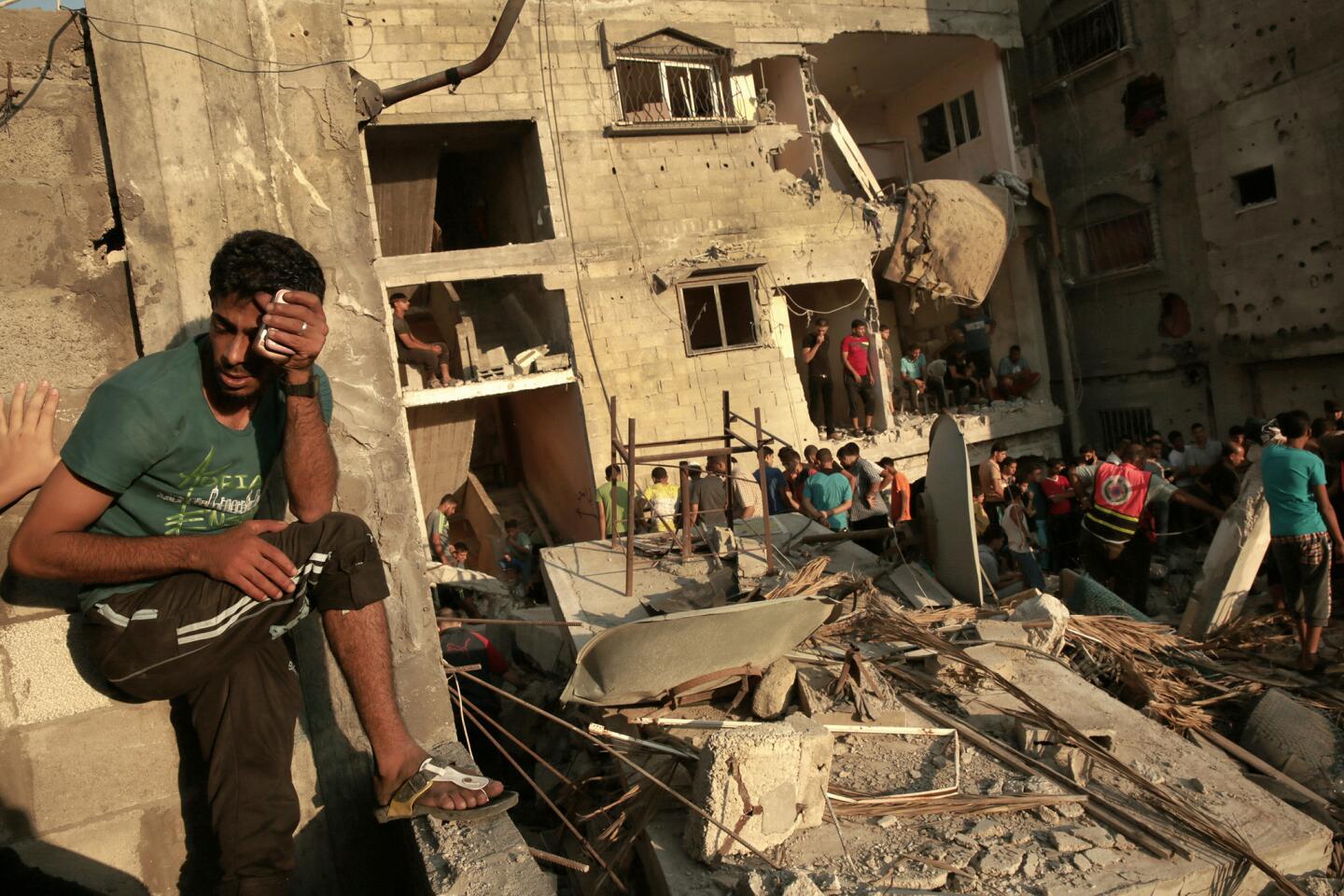
Men search a bombed building in the Shati refugee camp looking for the bodies of four people still missing from an Israeli air strike. (Carolyn Cole / Los Angeles Times)
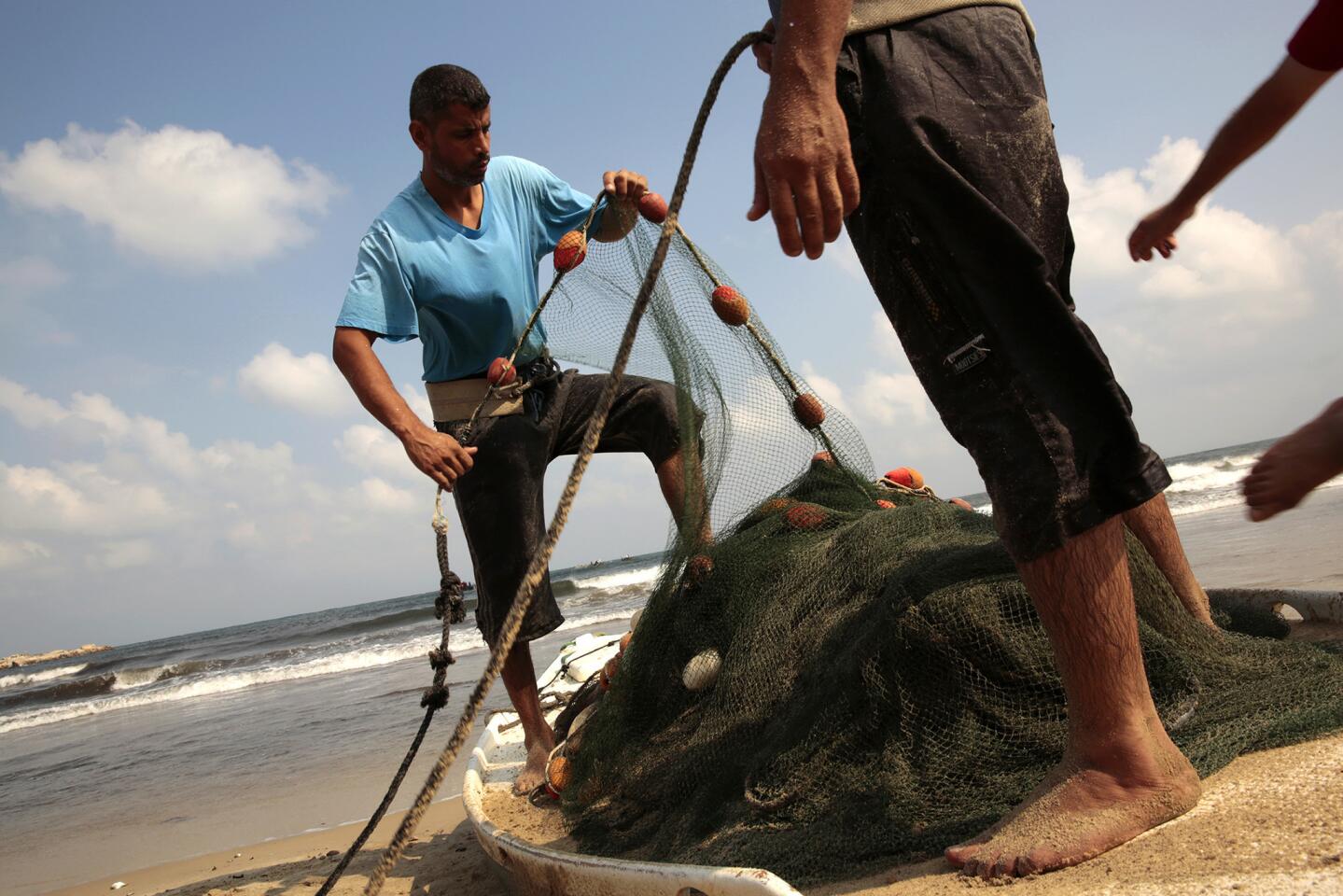
At the start of a 72-hour ceasefire between Hamas and the Israeli army, people return to Gaza Beach, where fishermen prepare to set out their net, having not been able to earn a living for the past month. (Carolyn Cole / Los Angeles Times)
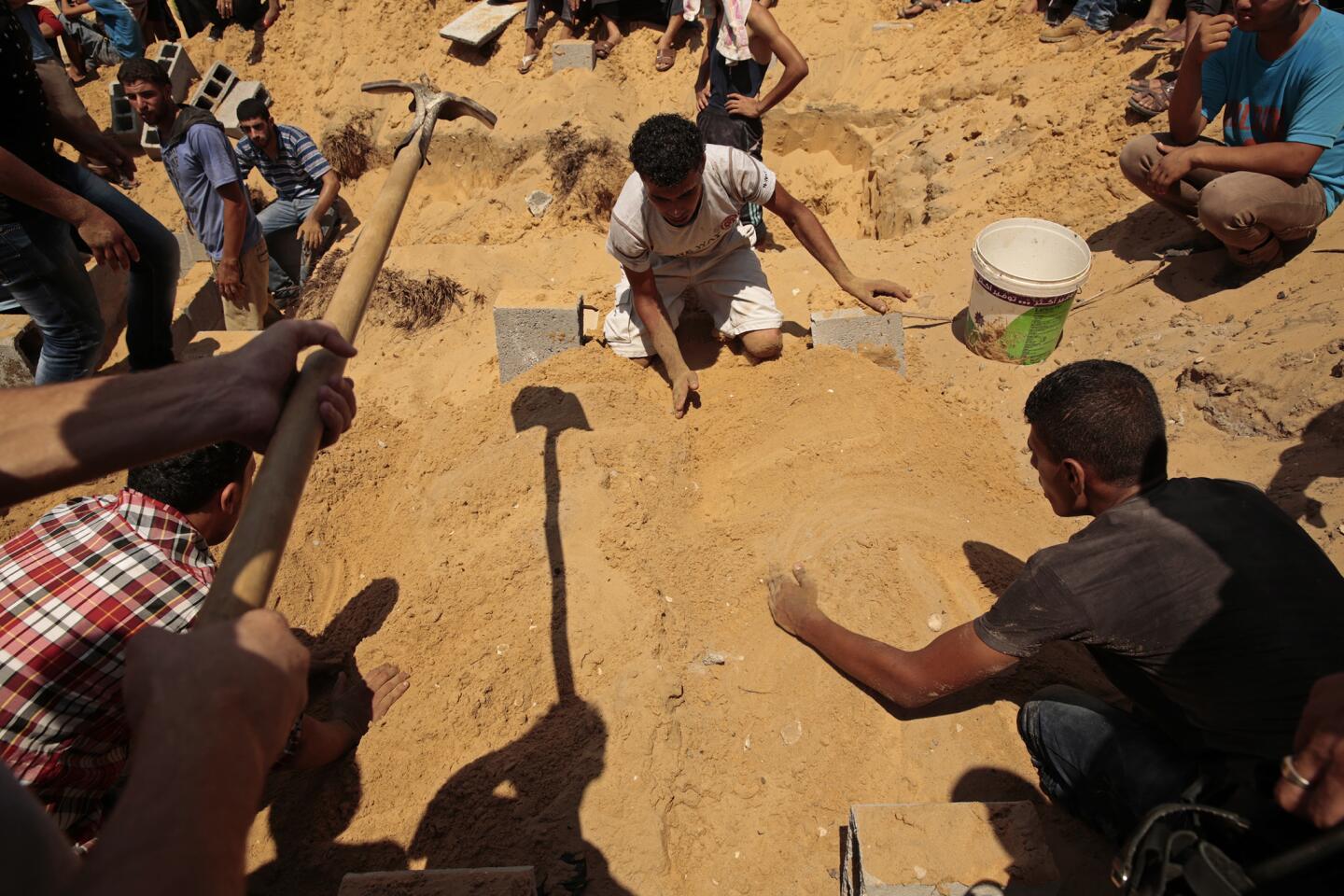
The bodies of seven people are buried after a home in Jabalia was hit by Israeli ordnance. The Israeli military said a strike before dawn Monday killed a leader of Islamic Jihad, an ally of the militant group Hamas, which dominates the territory. (Carolyn Cole / Los Angeles Times)
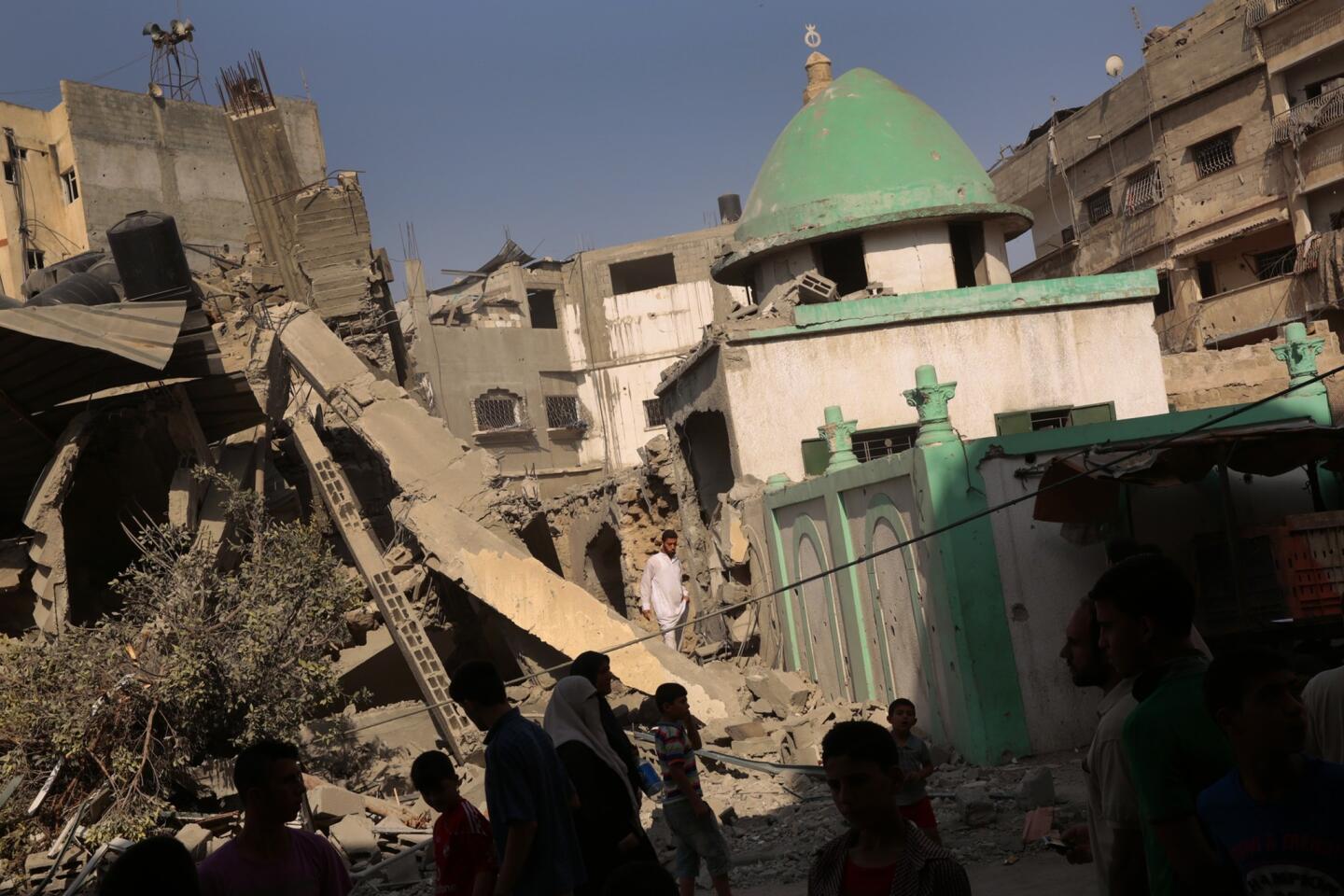
The Omari mosque, one of the oldest mosques in the Jabalia area of northern Gaza, was hit in overnight bombing. The old section of the mosque remained standing, right, while a new section was flattened, left. (Carolyn Cole / Los Angeles Times)
Advertisement
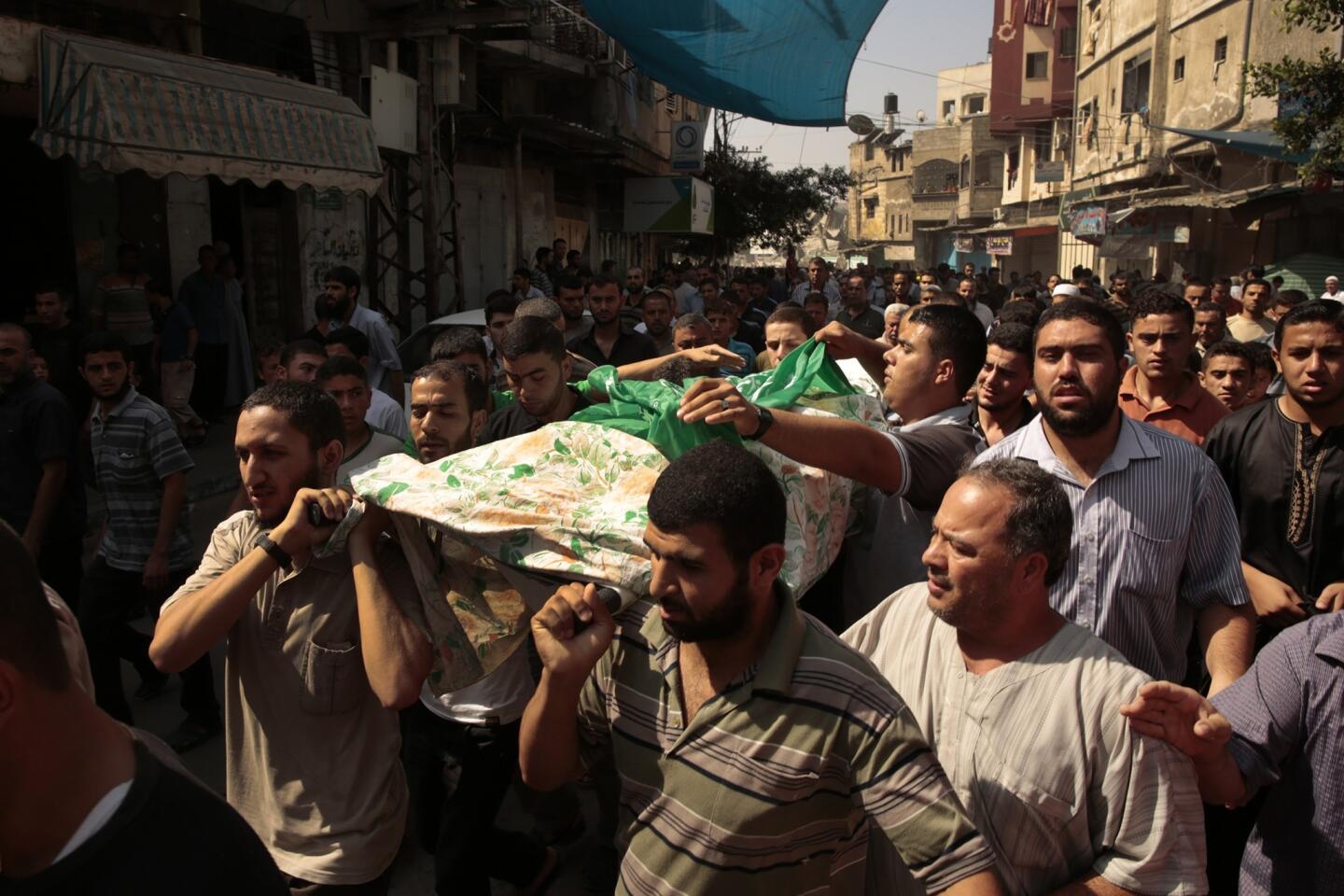
Daud Suleiyman, the muezzin who made the call to prayer at the Omari mosque in the Jabalia area of northern Gaza, was among those killed when the mosque was bombed overnight. His funeral was Saturday morning. (Carolyn Cole / Los Angeles Times)
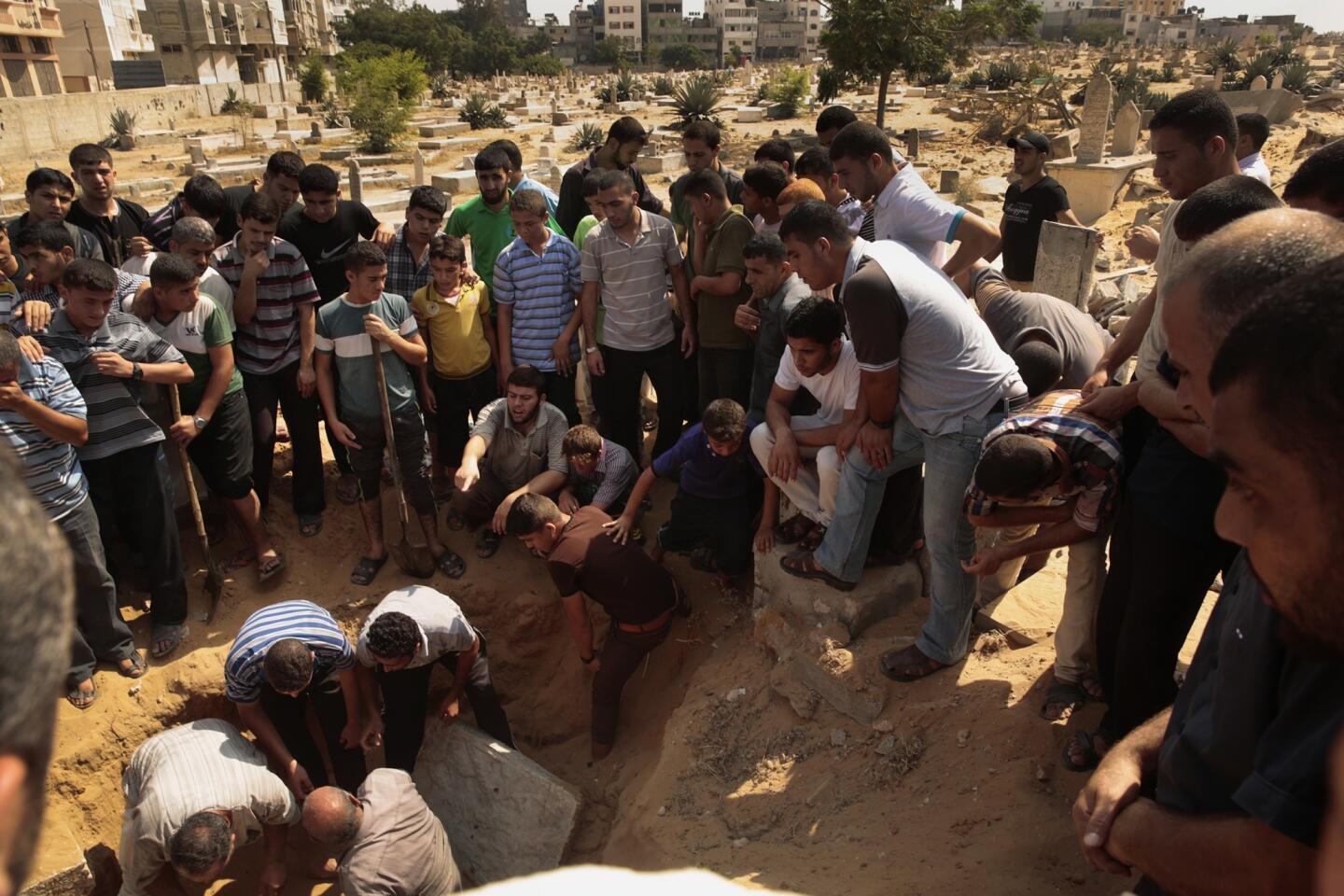
Daud Suleiyman, the muezzin who made the call to prayer at the Omari mosque, is placed in his grave Saturday morning, hours after he was killed in the overnight bombing of the mosque in northern Gaza. (Carolyn Cole / Los Angeles Times)
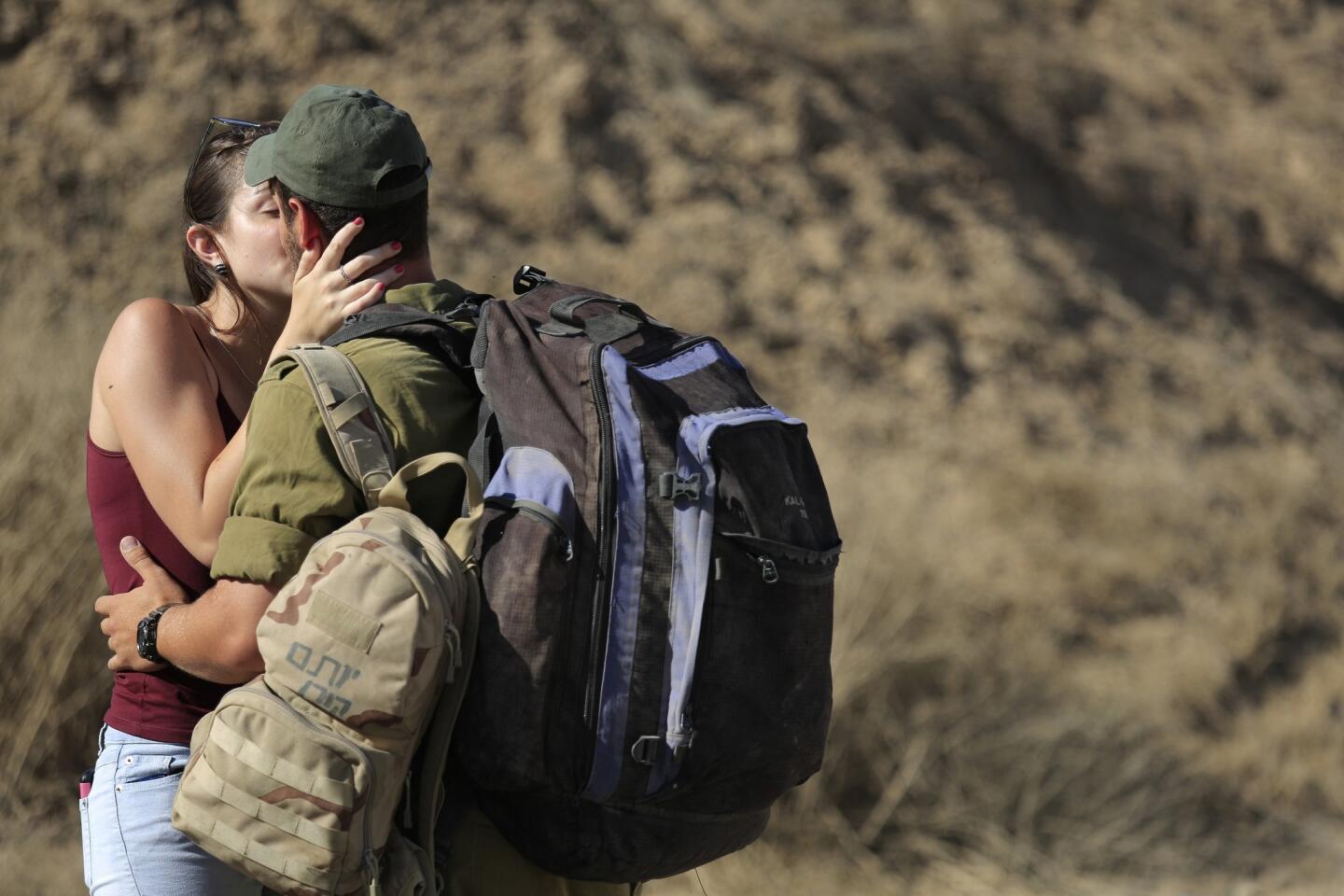
An Israeli soldier kisses his girlfriend before joining his unit in a staging area near the Israel-Gaza border on Saturday. (Tsafrir Abayov / Associated Press)
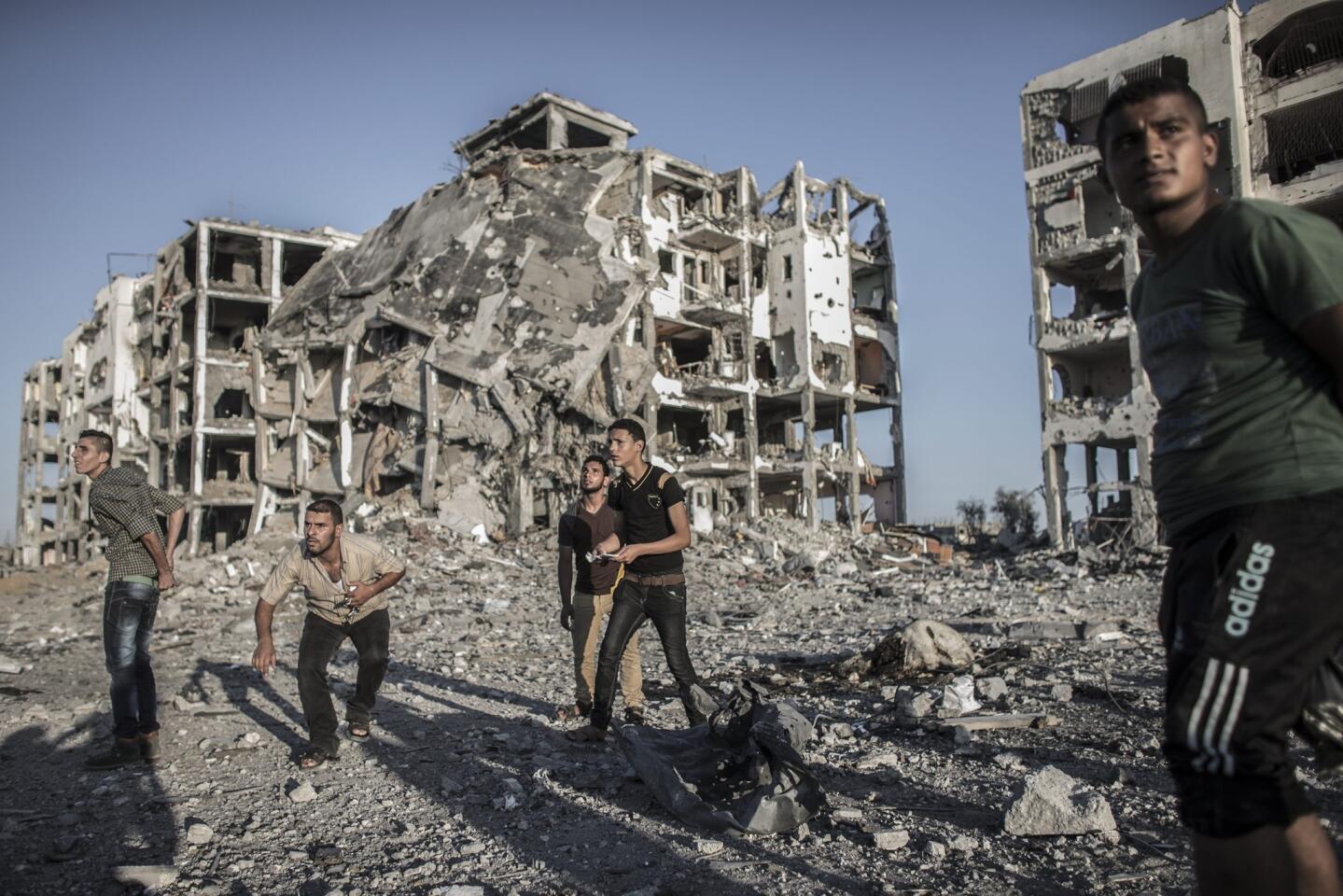
Palestinian men duck in reaction to a possible incoming Israeli airstrike as they walk among destroyed apartment buildings in Beit Lahia in the northern Gaza Strip. (Oliver Weiken / EPA)
Advertisement
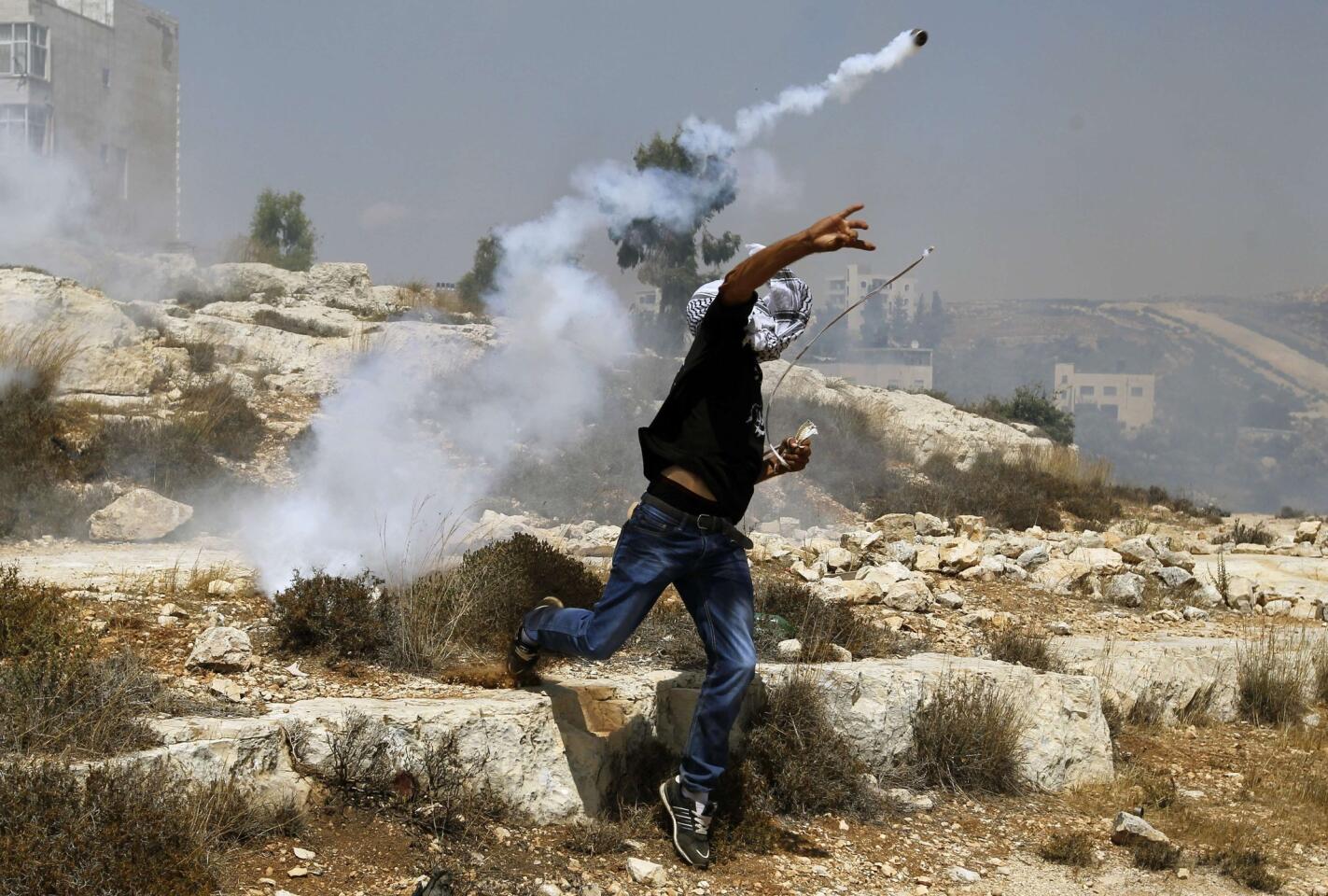
A Palestinian throws back a tear gas canister fired by Israeli security forces during clashes following the funeral of 19-year-old Udai Nafez on Saturday in the West Bank village of Rafat. Udai was shot in the chest in a clash with Israeli forces during solidarity protests by Palestinians in Saffa, west of Ramallah. (Abbas Momani / AFP/Getty Images)
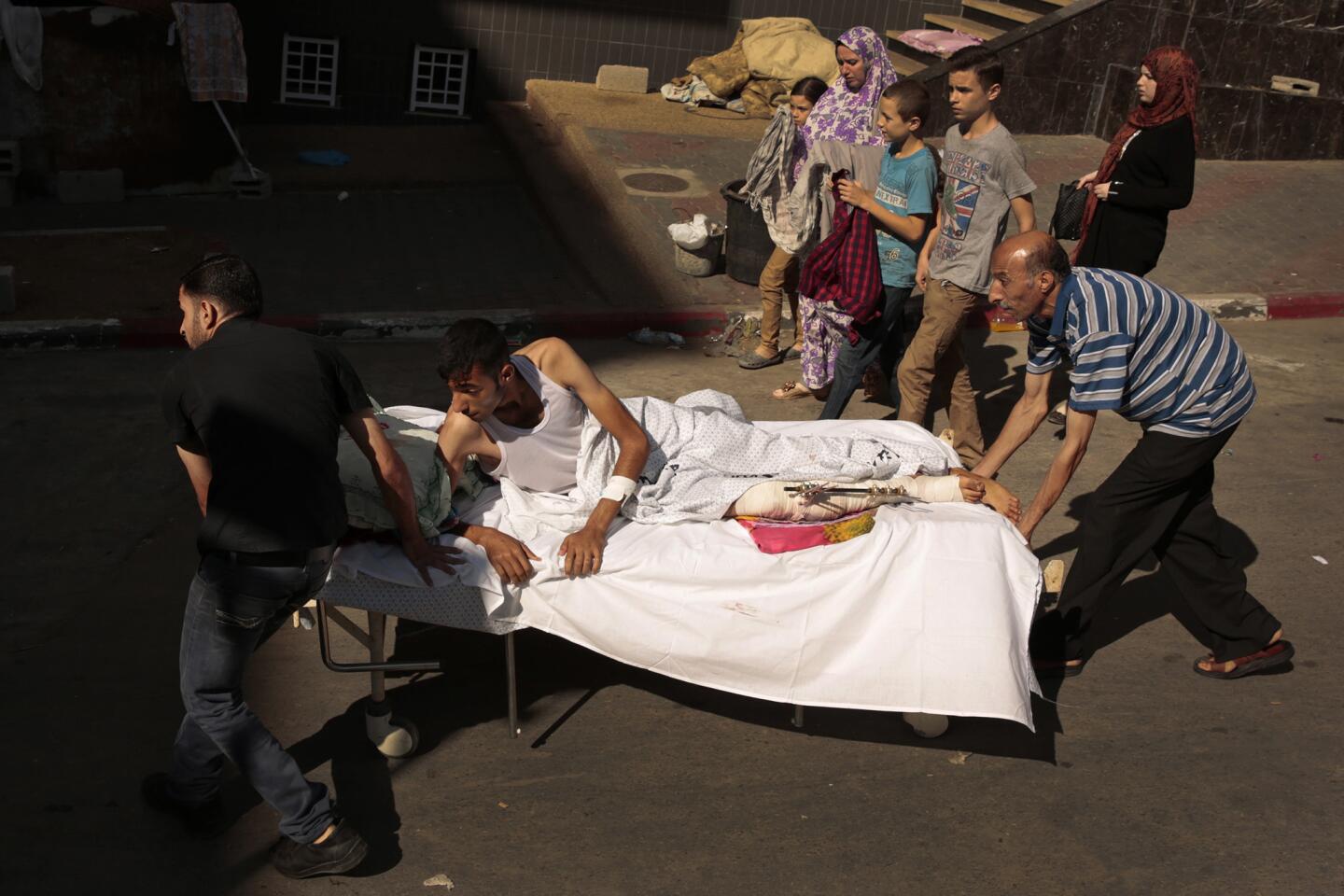
After the collapse of a 72-hour ceasefire, patients and families are evacuated from Shifa Hospital when the threat of a bombing was called in. (Carolyn Cole / Los Angeles Times)
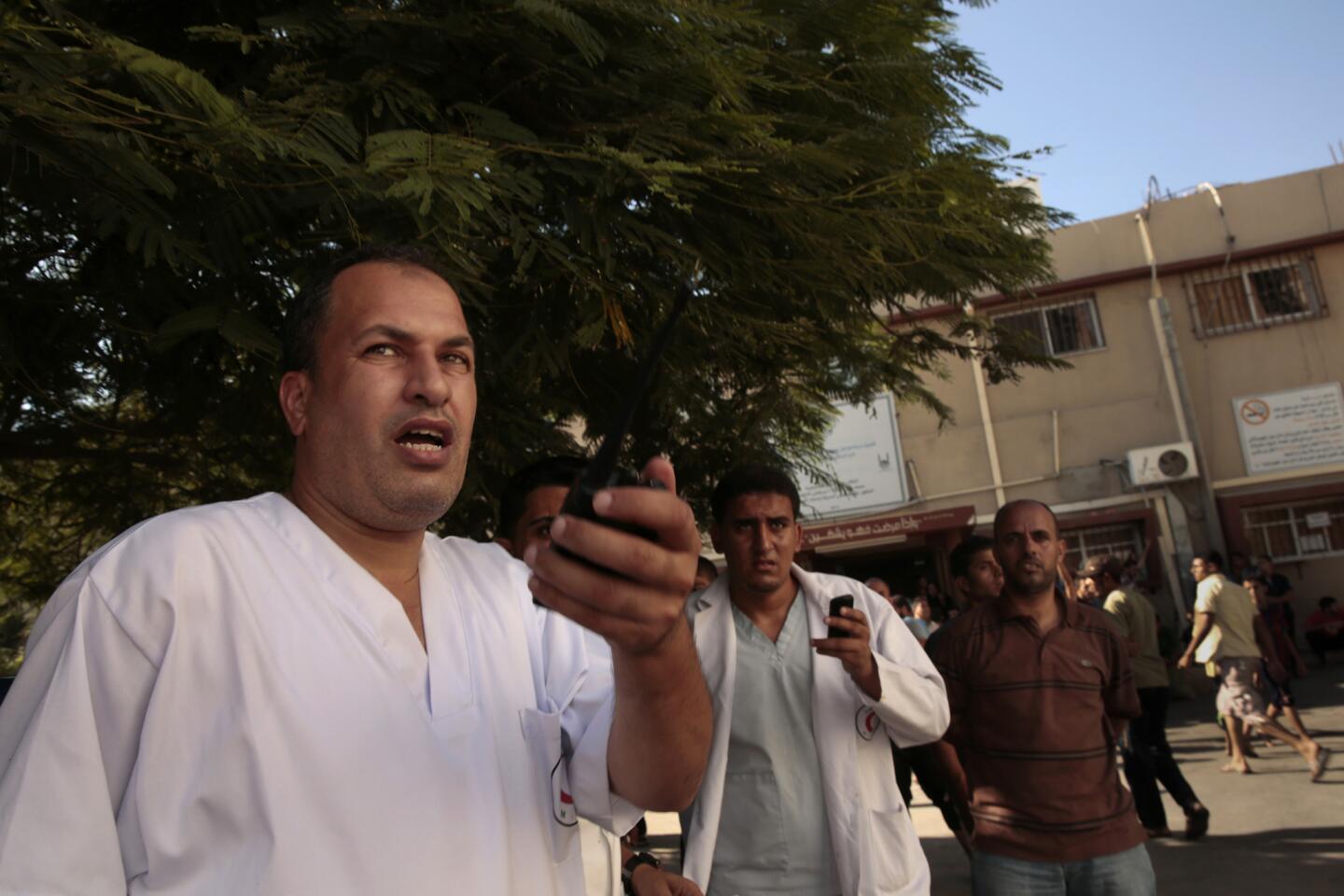
After the collapse of a 72-hour ceasefire, doctors evacuate Shifa Hospital after a bomb threat was called in. (Carolyn Cole / Los Angeles Times)
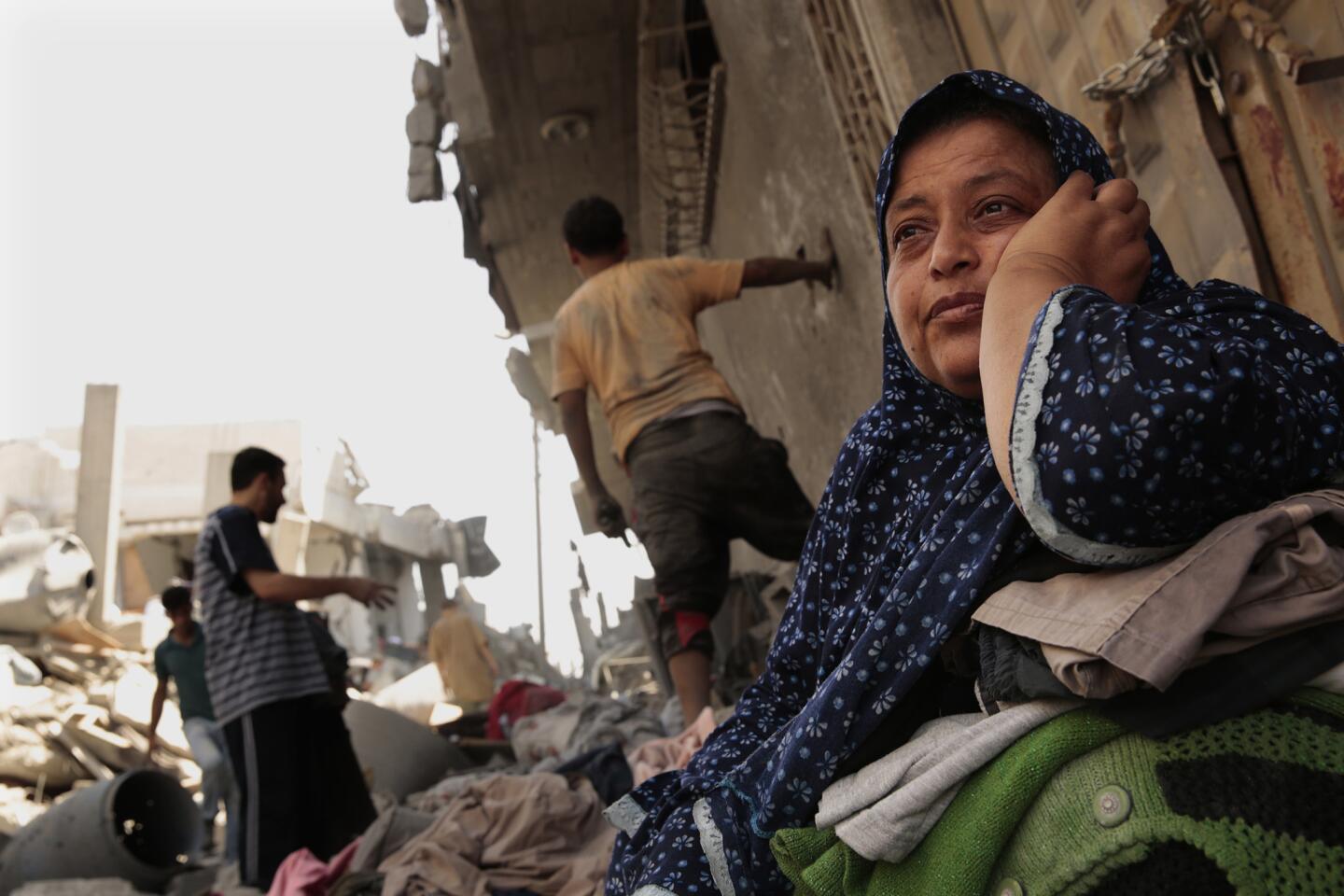
Her home completely destroyed, a woman sits on the side of the road at the start of a 72-hour ceasefire. (Carolyn Cole / Los Angeles Times)
Advertisement
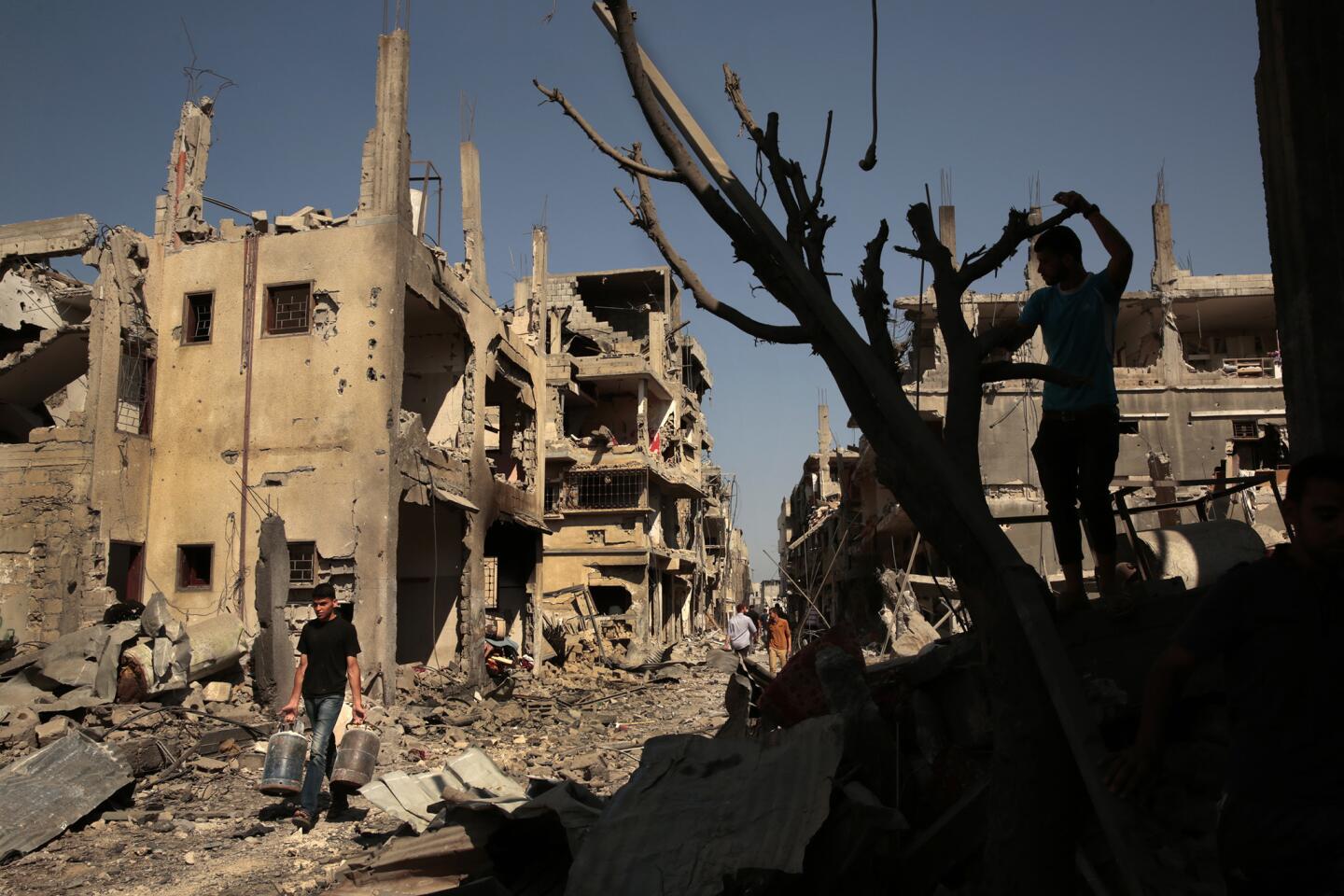
At the start of a 72-hour ceasefire, people return to their homes in the Shejaiya neighborhood of Gaza City to reclaim what belongings they can find. (Carolyn Cole / Los Angeles Times)
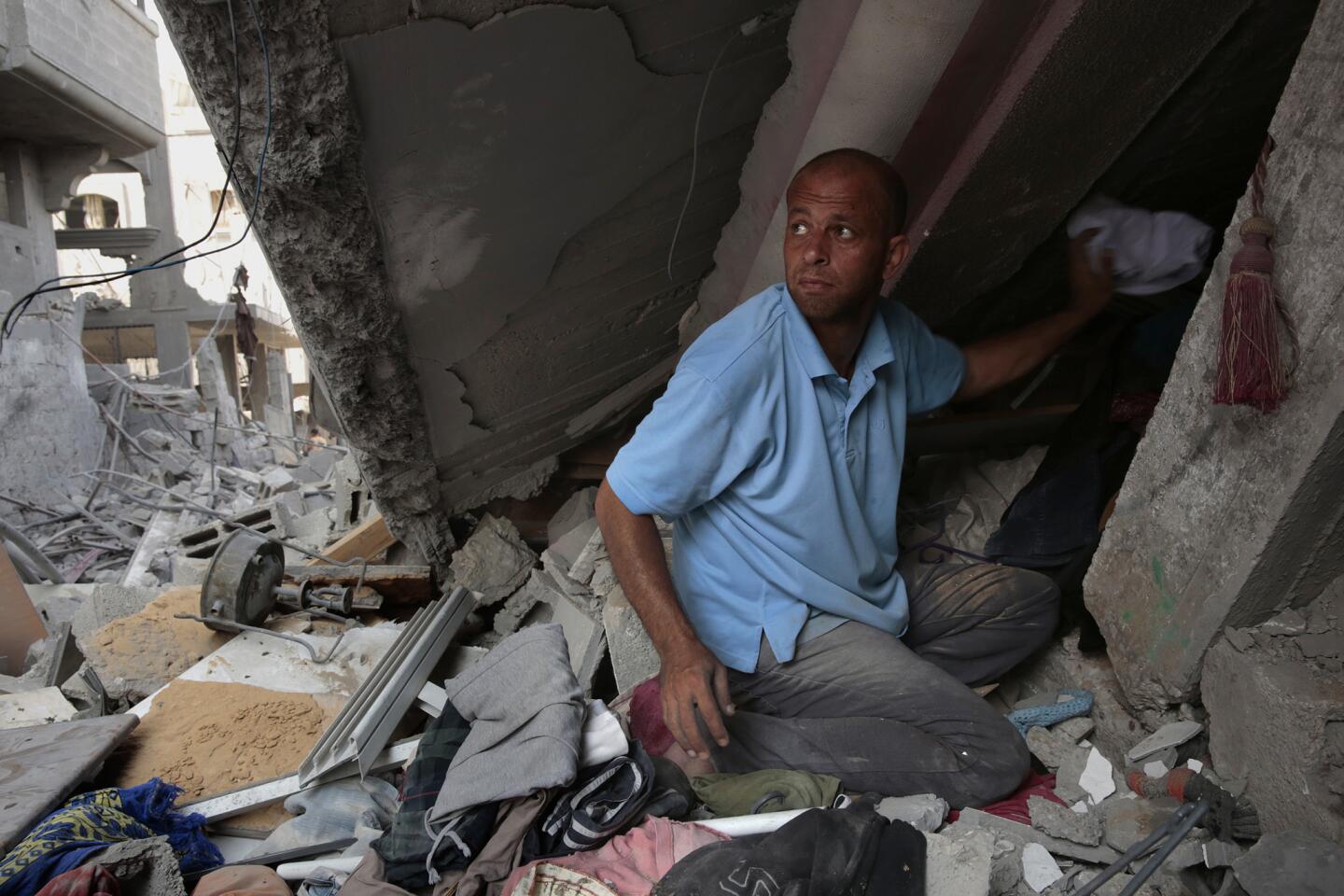
Raed Habib, the father of 10 children, recovers belongings from his demolished family home during the start of a 72-hour ceasefire. (Carolyn Cole / Los Angeles Times)
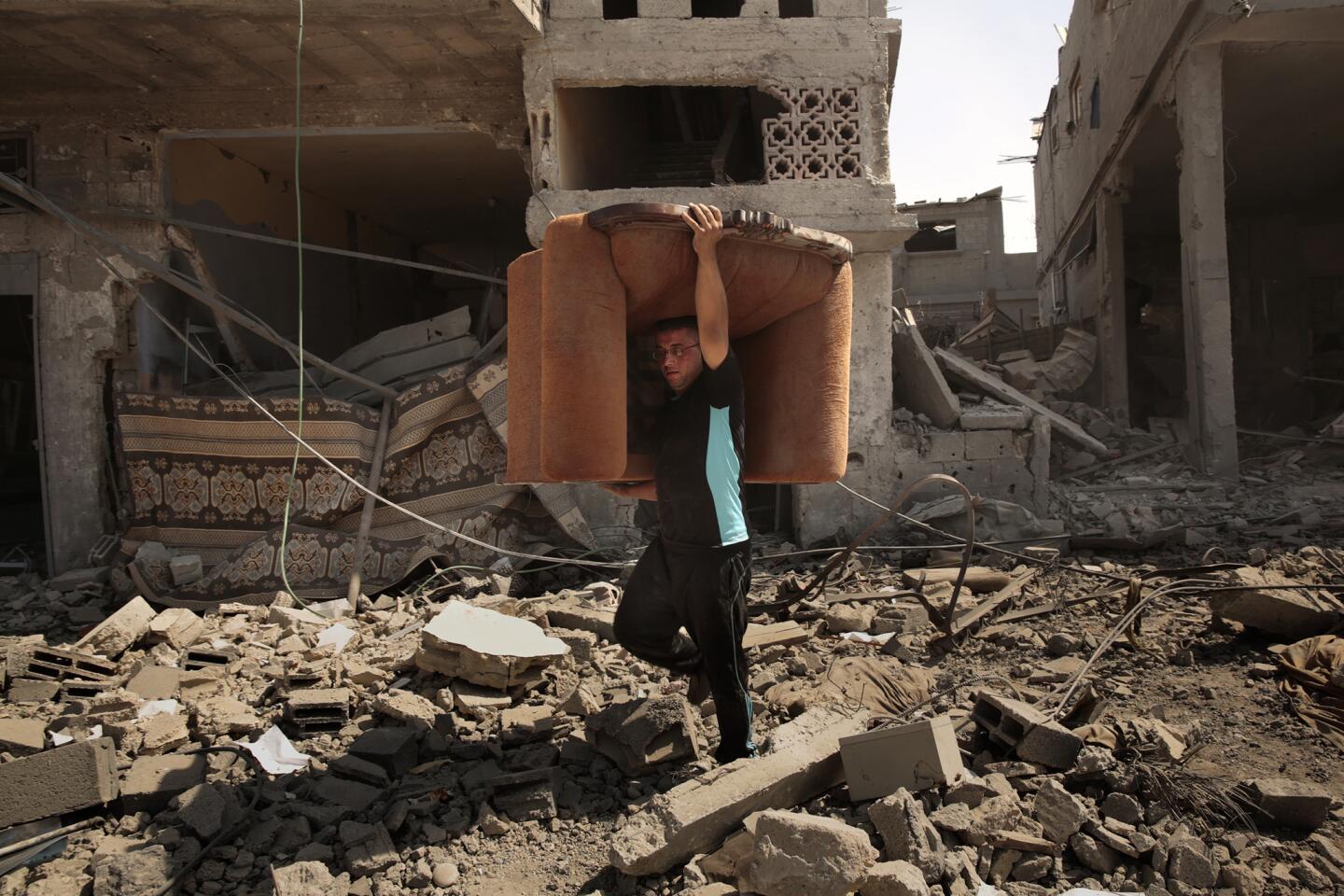
A man carries a large chair through the rubble in the Shejaiya area of Gaza, which has seen some of the worst destruction during the ongoing conflict. (Carolyn Cole / Los Angeles Times)
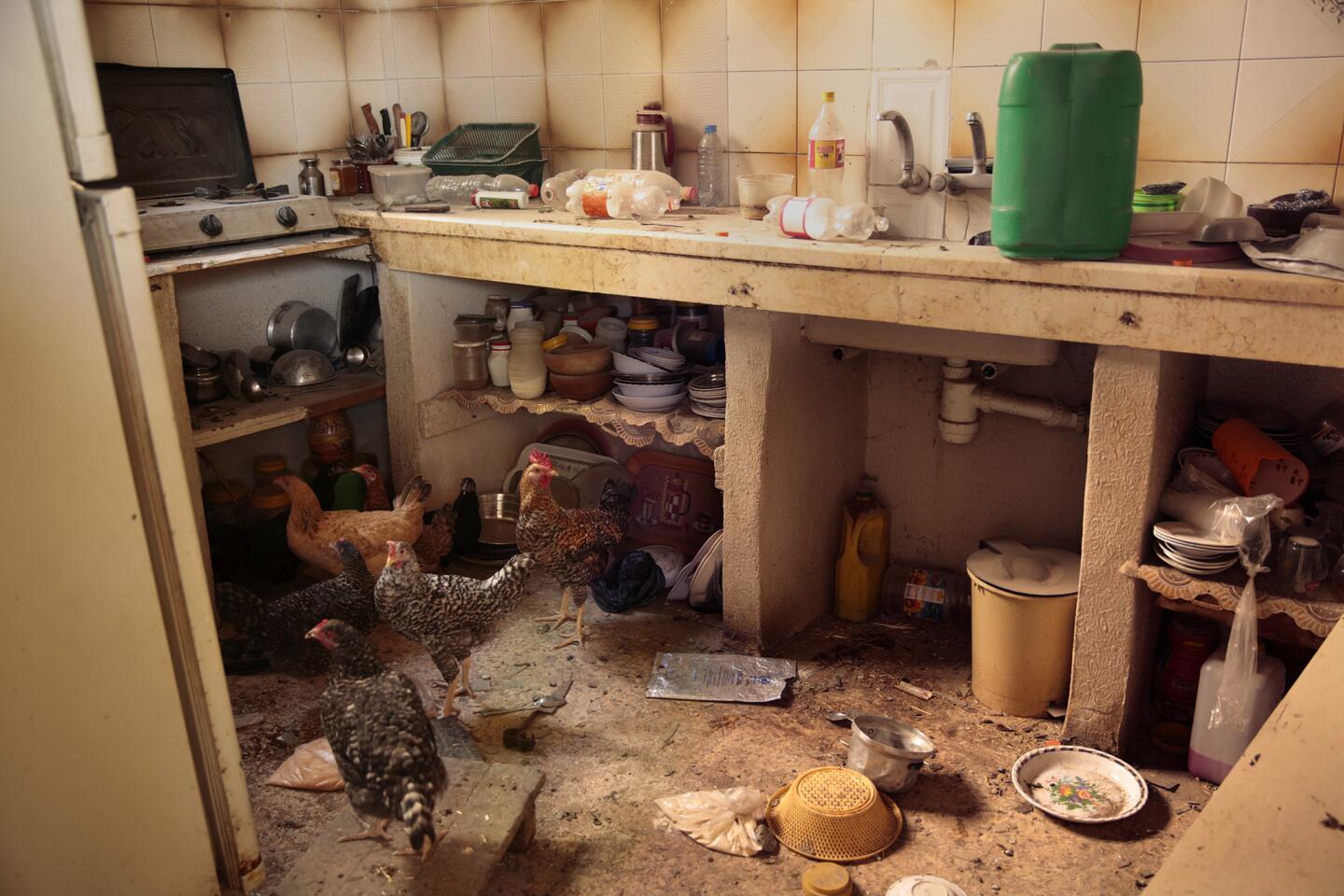
Chickens gather in a kitchen of a destroyed home. Many farm animals in the area haven’t been fed for more than a week. (Carolyn Cole / Los Angeles Times)
Advertisement
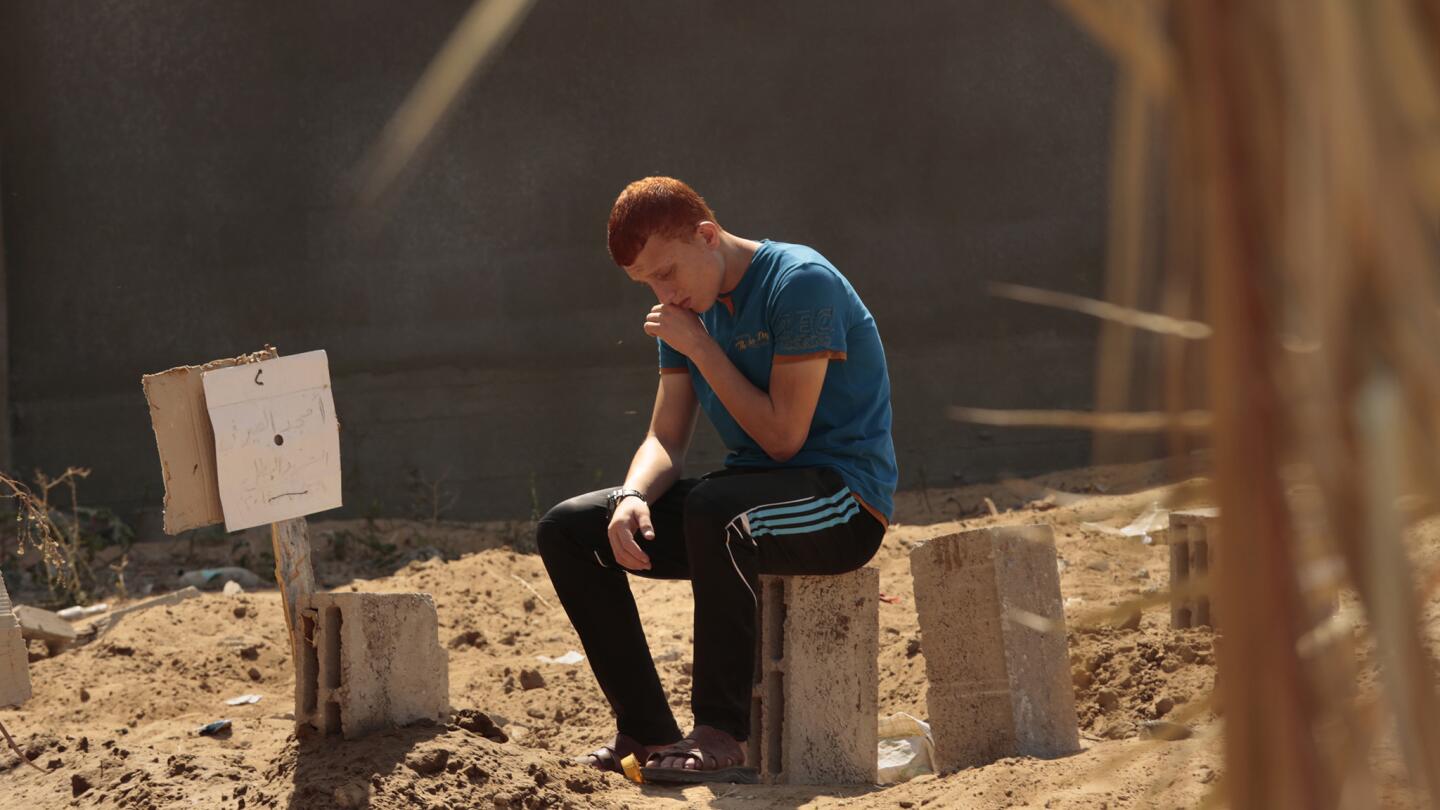
Ahmed Wady mourns the loss of his friend at a newly started cemetery in Gaza City. (Carolyn Cole / Los Angeles Times)
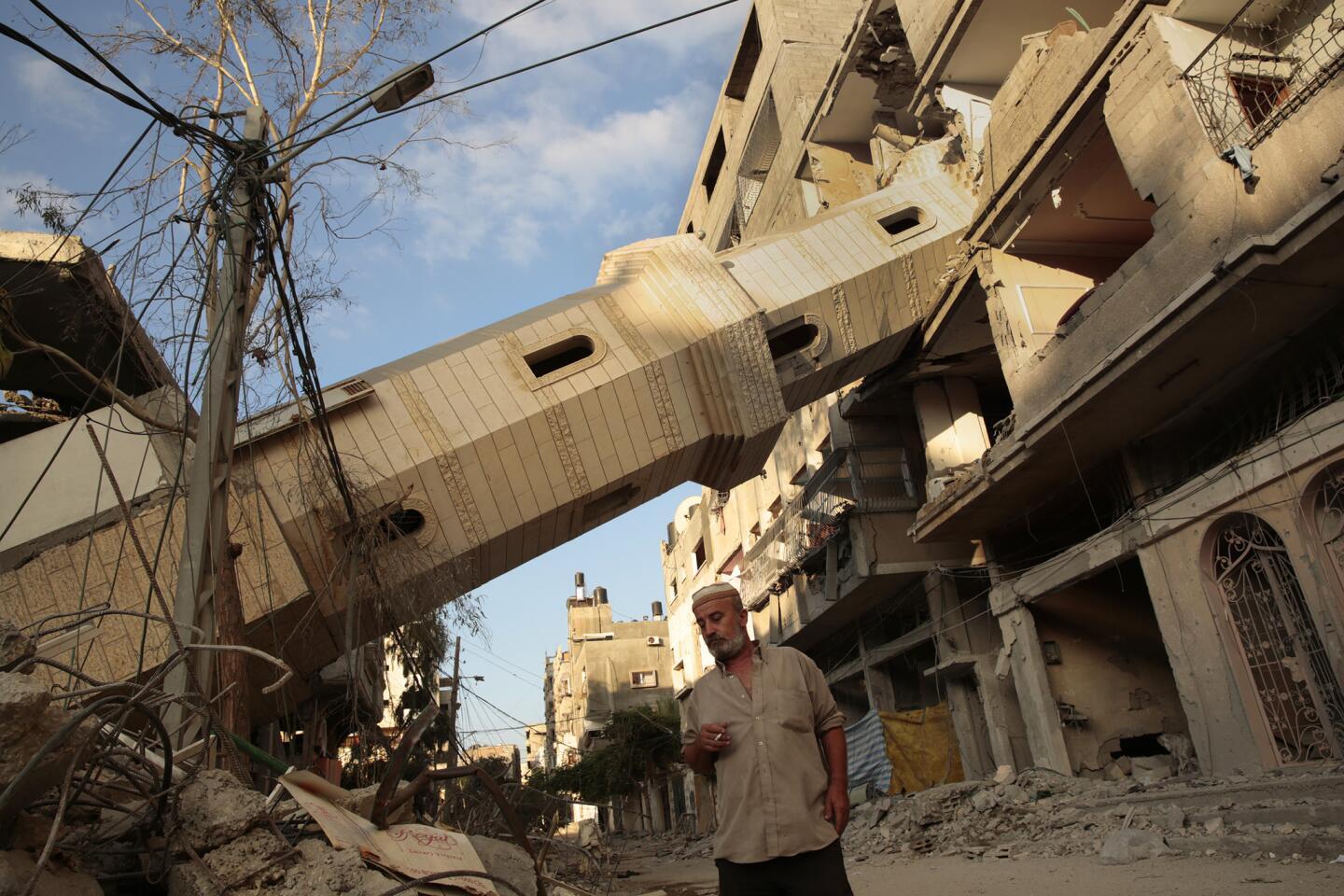
A man walks past one of several mosques destroyed by Israeli forces in the past three and a half weeks in Gaza City. (Carolyn Cole / Los Angeles Times)
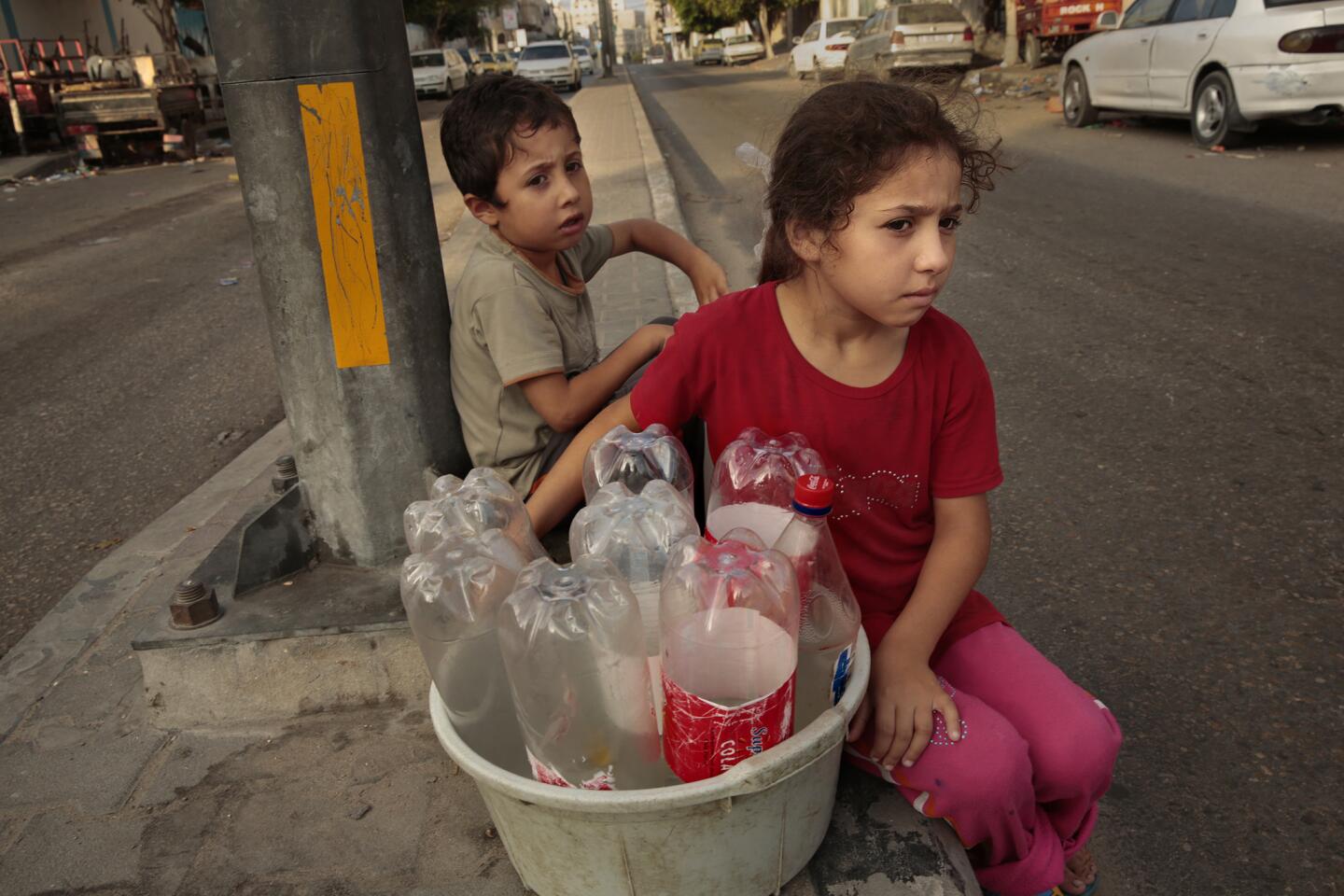
Ten-year-old Marram and her brother Hamsa, 6, wait for the water to be turned on at the school where she and her family are staying in downtown Gaza City. (Carolyn Cole / Los Angeles Times)
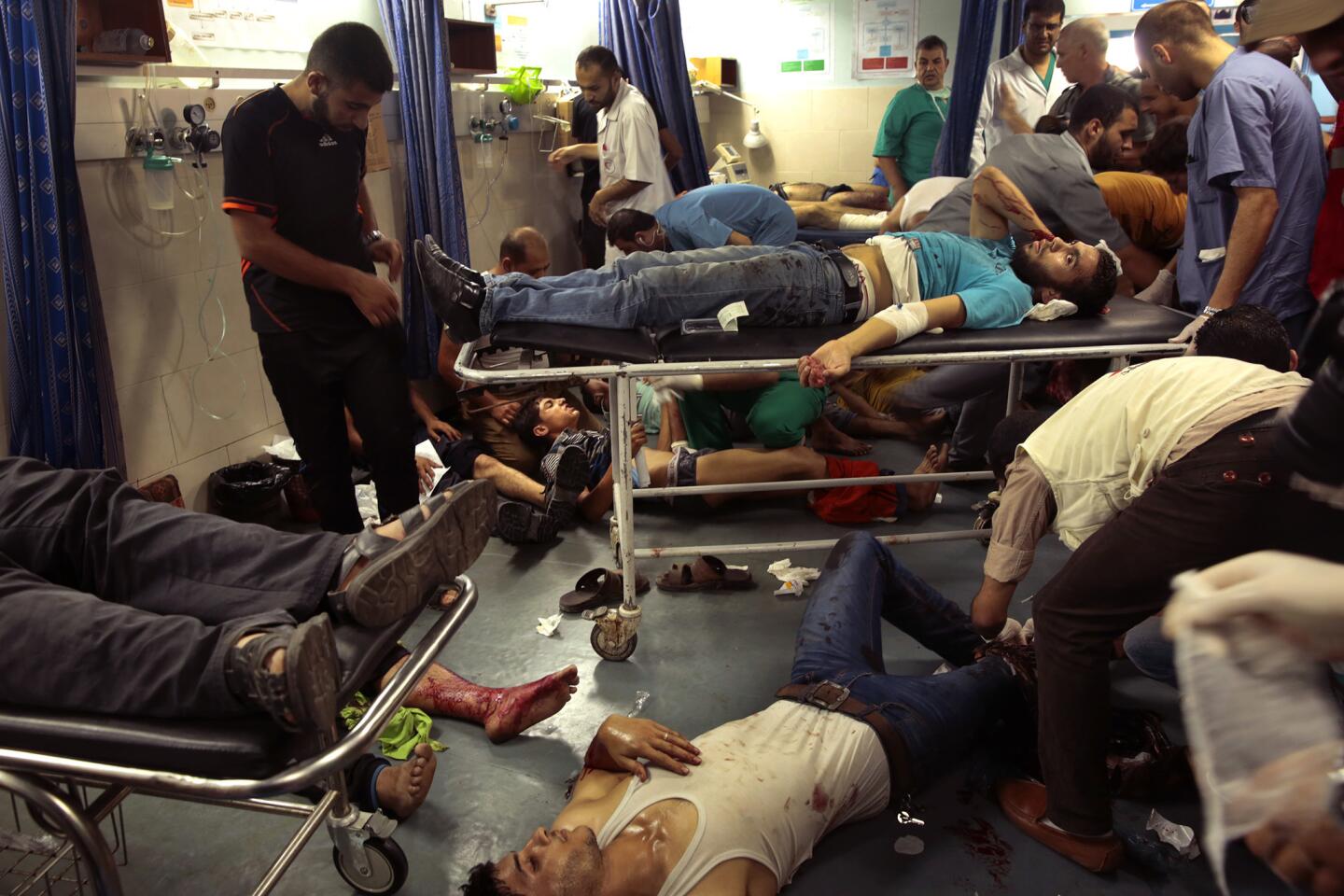
Wounded are treated at Shifa Hospital in Gaza City on July 30 after an explosion went off in the market in Shujayea during what was supposed to be a four-hour humanitarian cease-fire. (Carolyn Cole / Los Angeles Times )
Advertisement
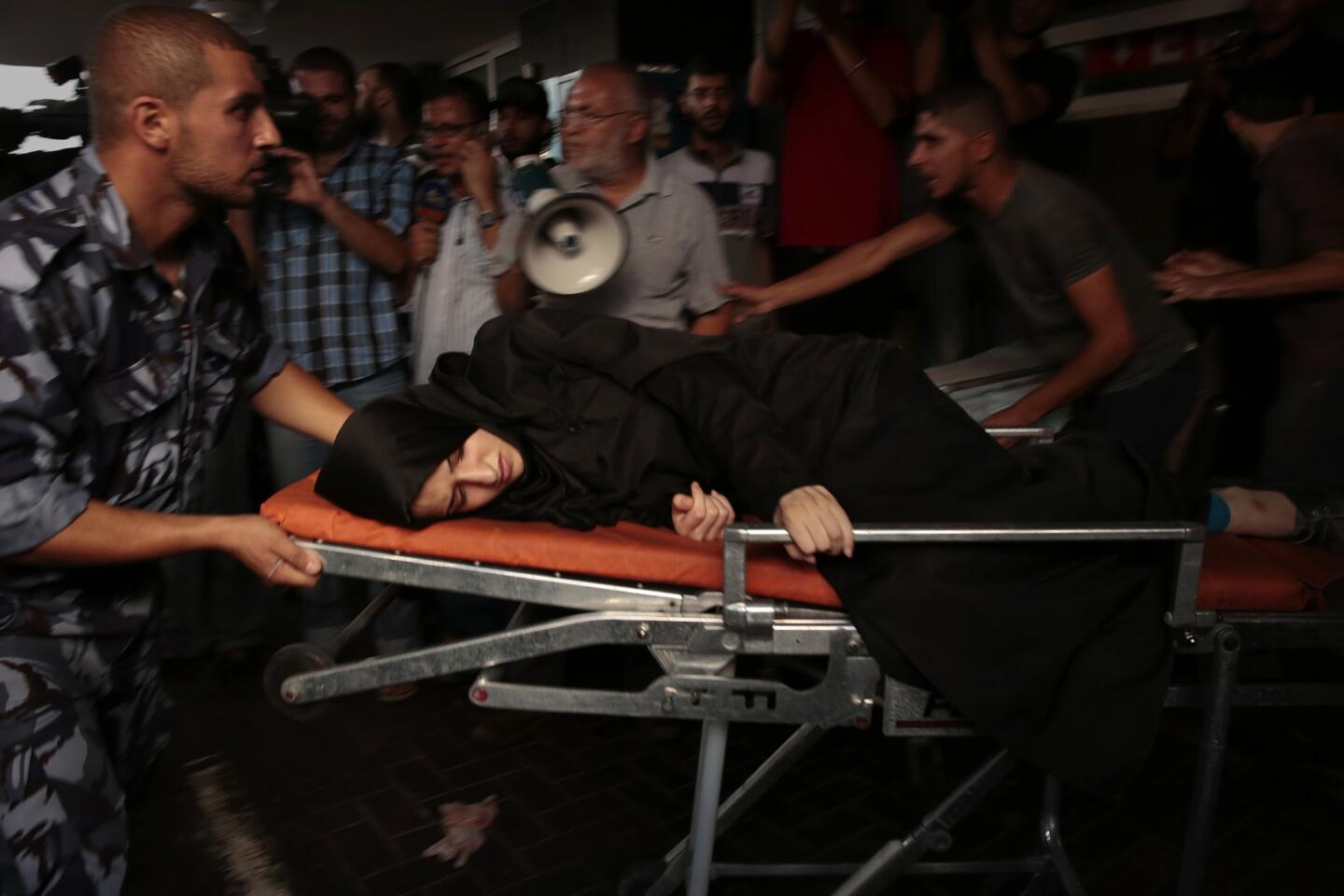
The dead and wounded are rushed to Shifa Hospital in Gaza City after an explosion July 30 in the market in Shujayea during what was supposed to be a four-hour humanitarian cease-fire. (Carolyn Cole / Los Angeles Times)
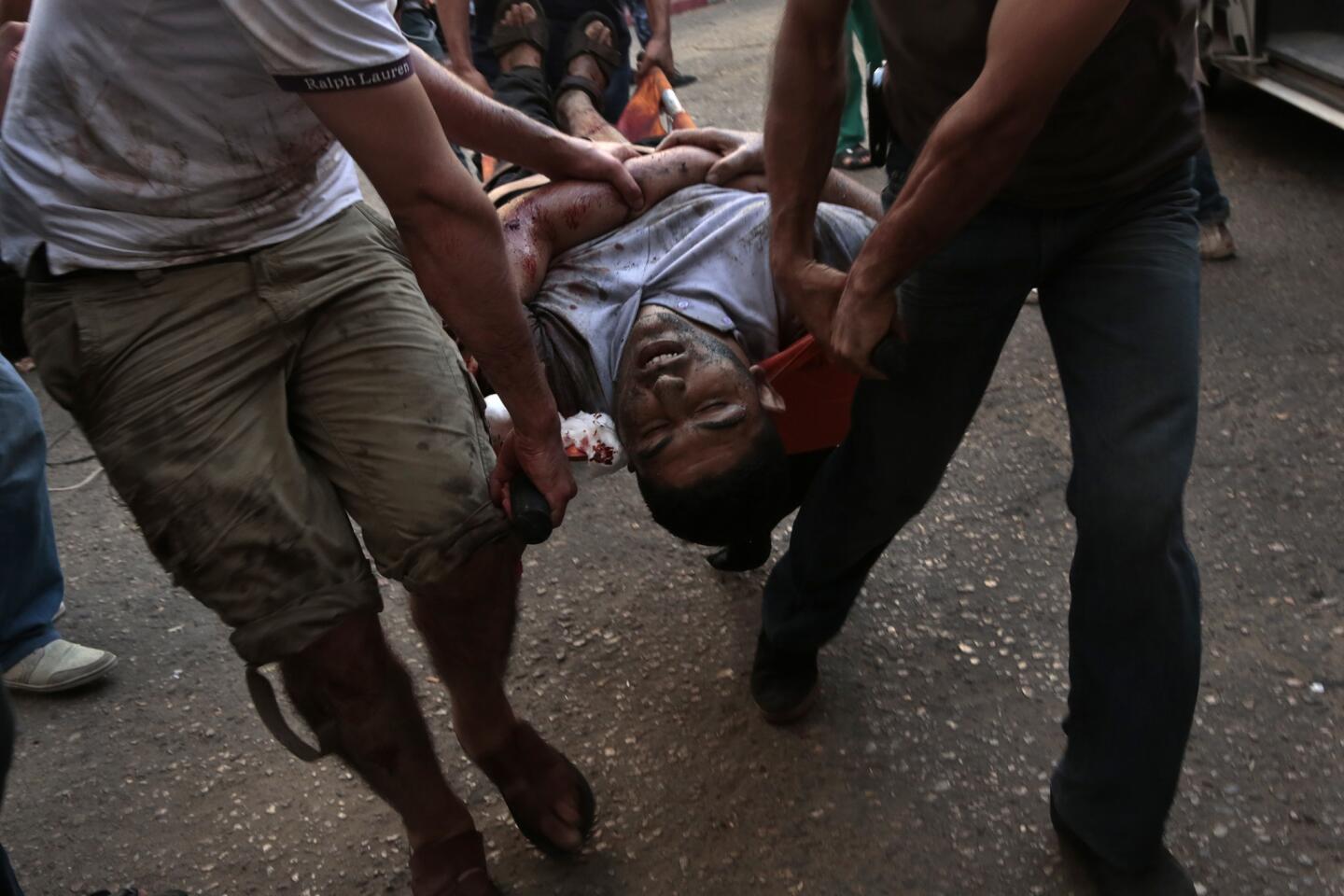
Victims are rushed to Shifa Hospital in Gaza City after an explosion July 30 in the market in Shujayea. (Carolyn Cole / Los Angeles Times)
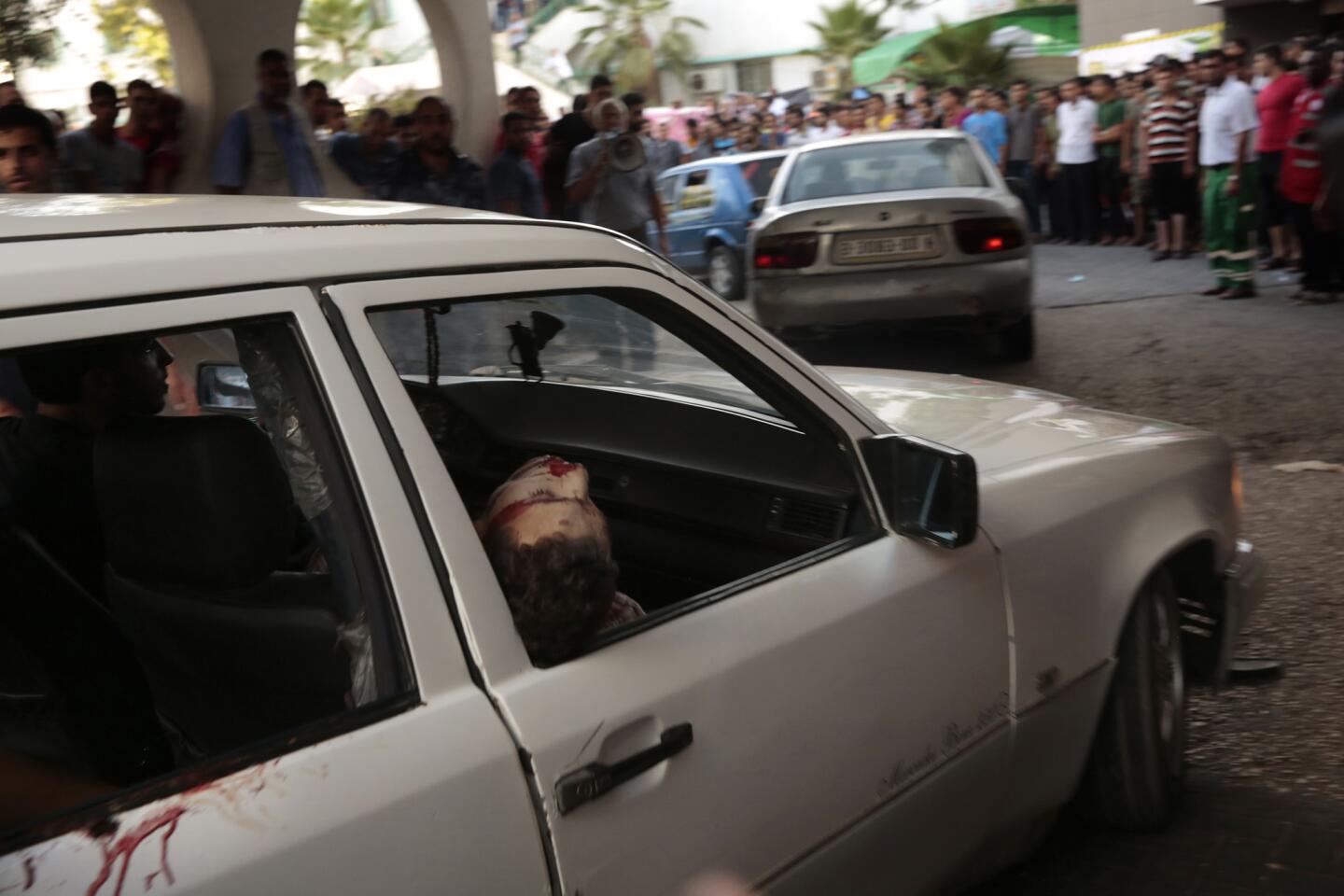
Due to a lack of ambulances, cars rush wounded to Shifa Hospital in Gaza City after an explosion July 30 in the market in Shujayea. (Carolyn Cole / Los Angeles Times)
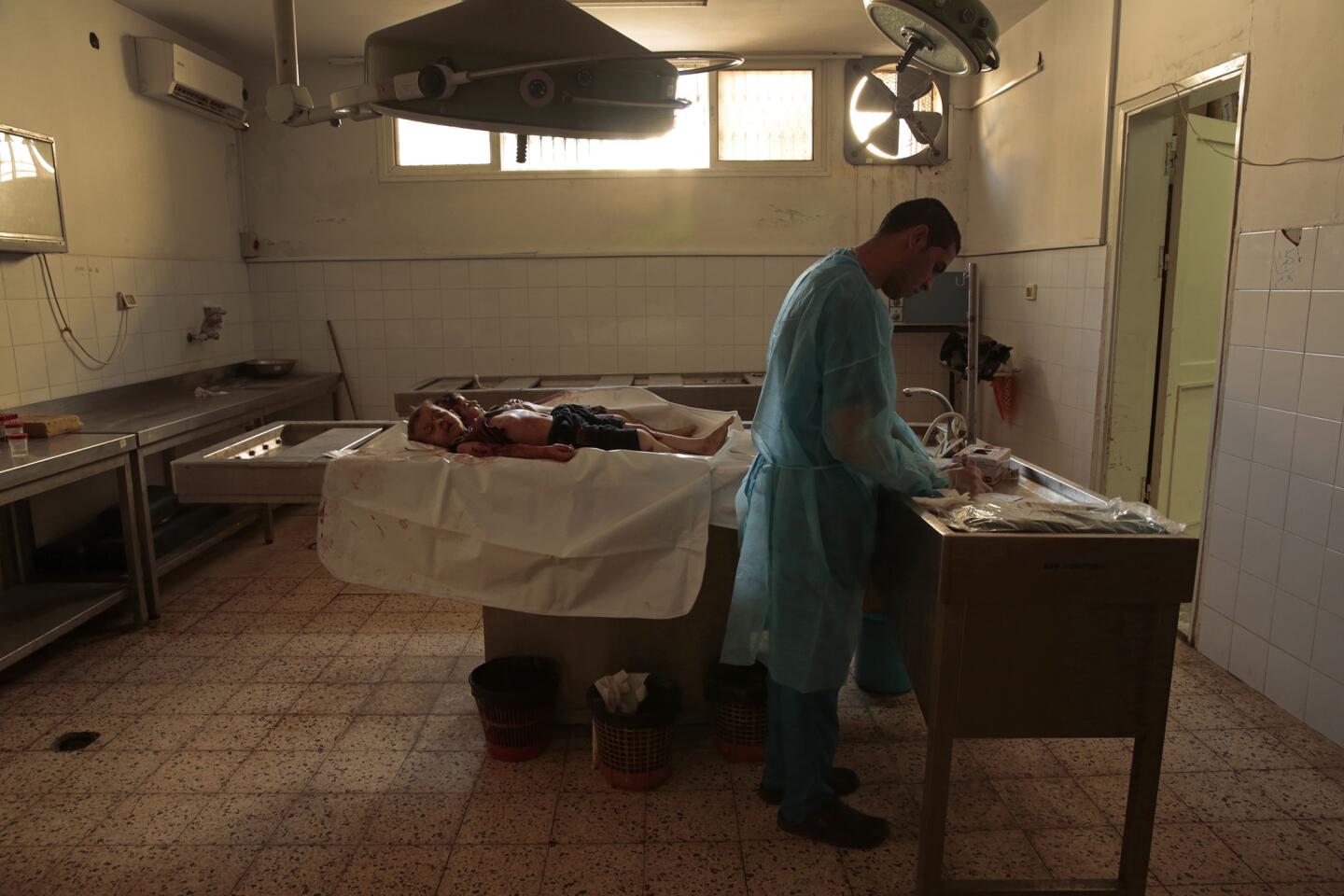
Medical worker, Mohammed Jameel Al Bar Bari, on July 30 finishes examining two young children who were killed when an Israeli airstrike hit a Gaza marketplace. (Carolyn Cole / Los Angeles Times)
Advertisement
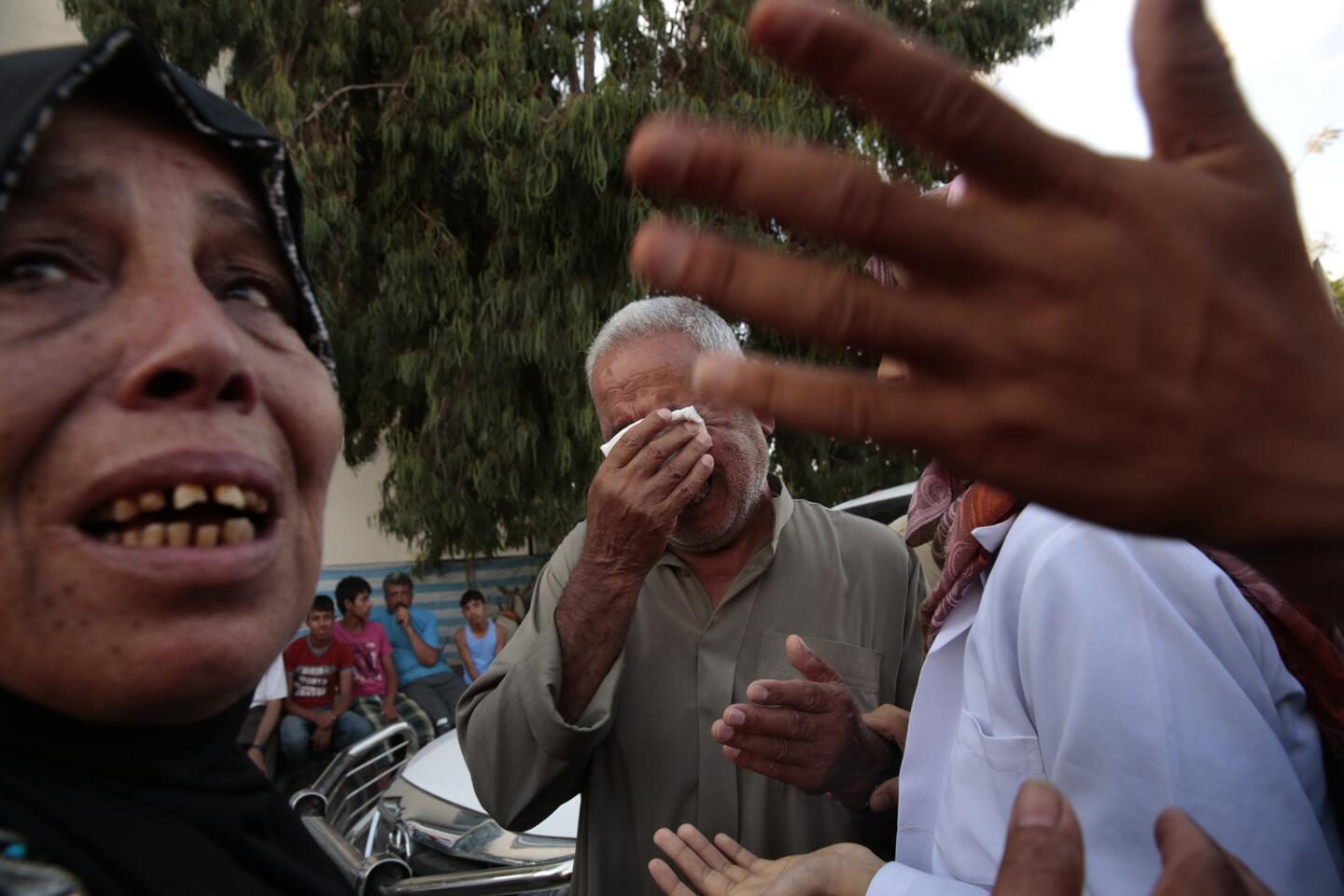
A man grieves for his grandson, who was killed in the Shujayea market blast on July 30. At least 15 people were killed by the Israeli airstrike. (Carolyn Cole / Los Angeles Times)
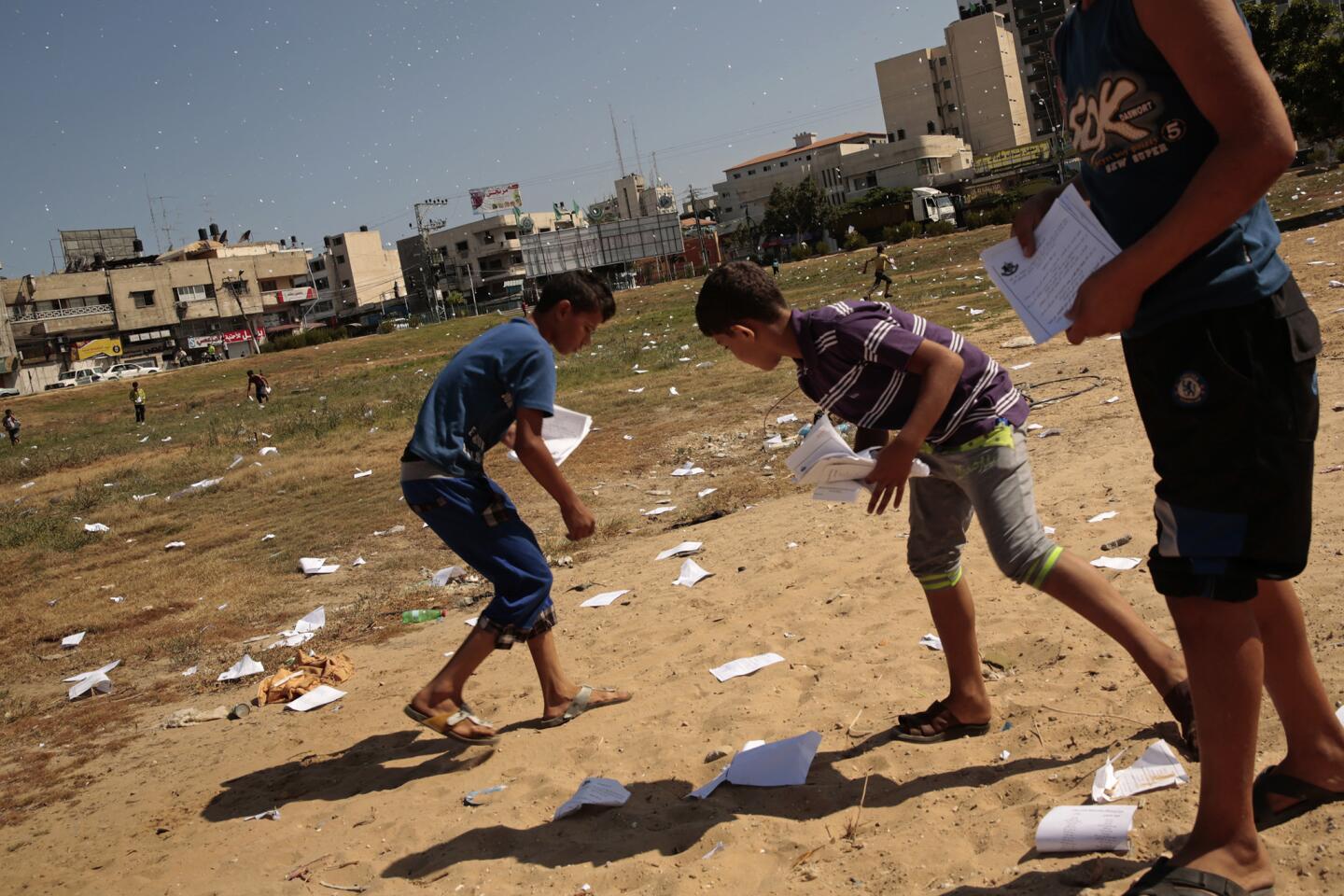
Palestinian children in Gaza City pick up fliers dropped by Israeli forces on July 29. The leaflets urged residents in the area to evacuate. (Carolyn Cole / Los Angeles Times)
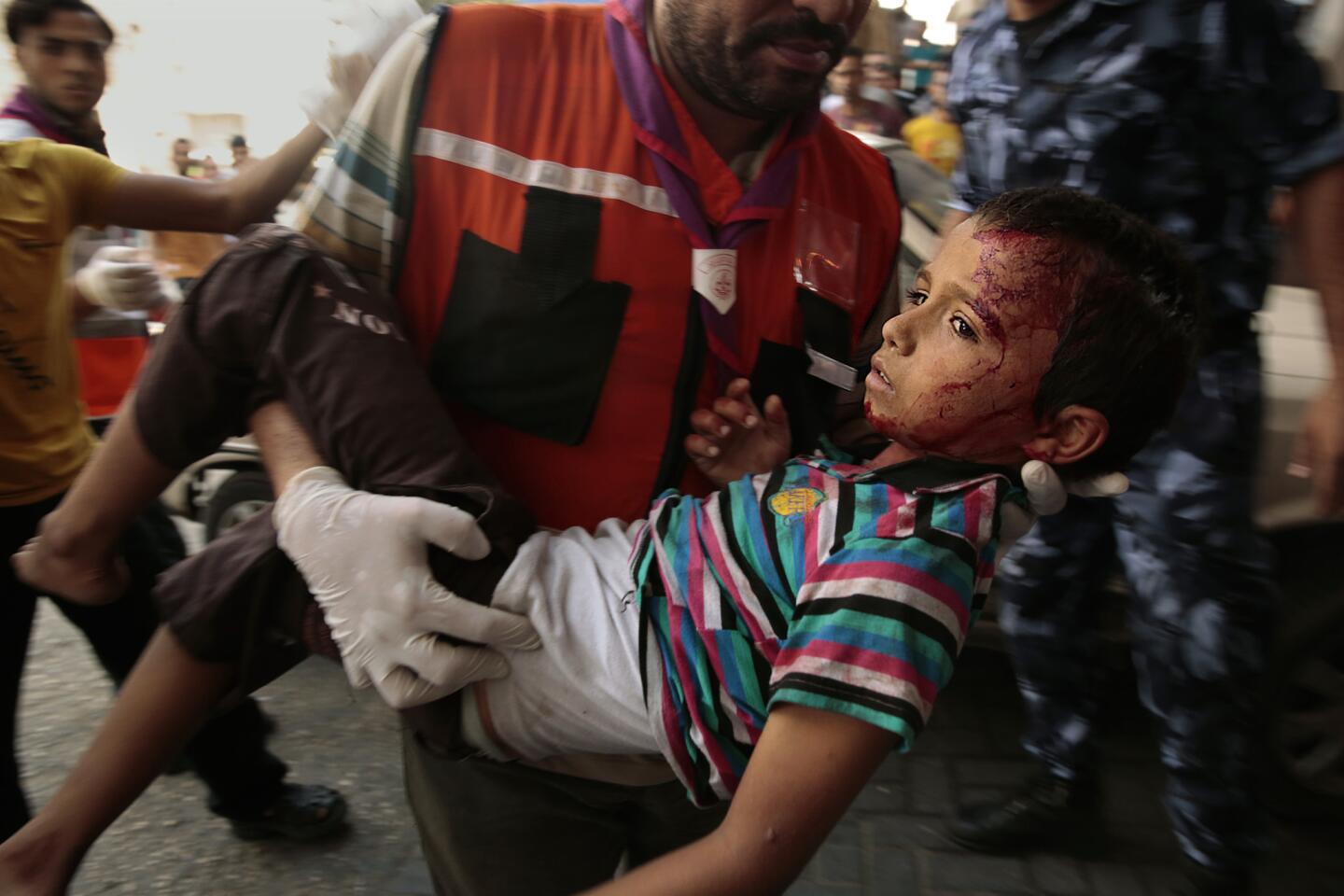
A young child wounded in an attack on a market in Shujayea on July 30 is rushed to Shifa Hospital in Gaza City. (Carolyn Cole / Los Angeles Times)
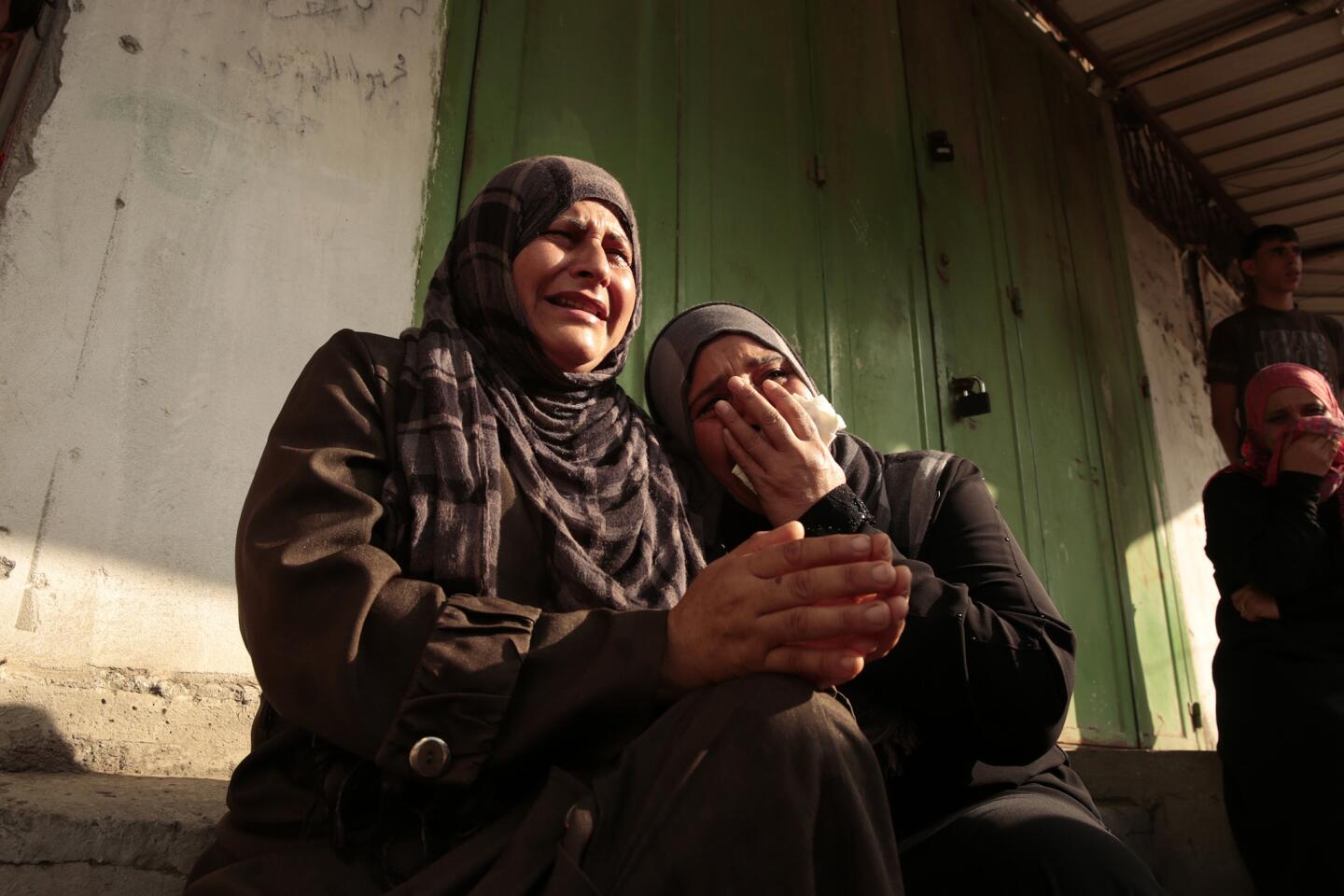
On July 29, women grieve outside the morgue at the hospital in Jabaliya, where the victims of an Israeli shelling incident that killed more than 15 people had gathered. (Carolyn Cole / Los Angeles Times)
Advertisement
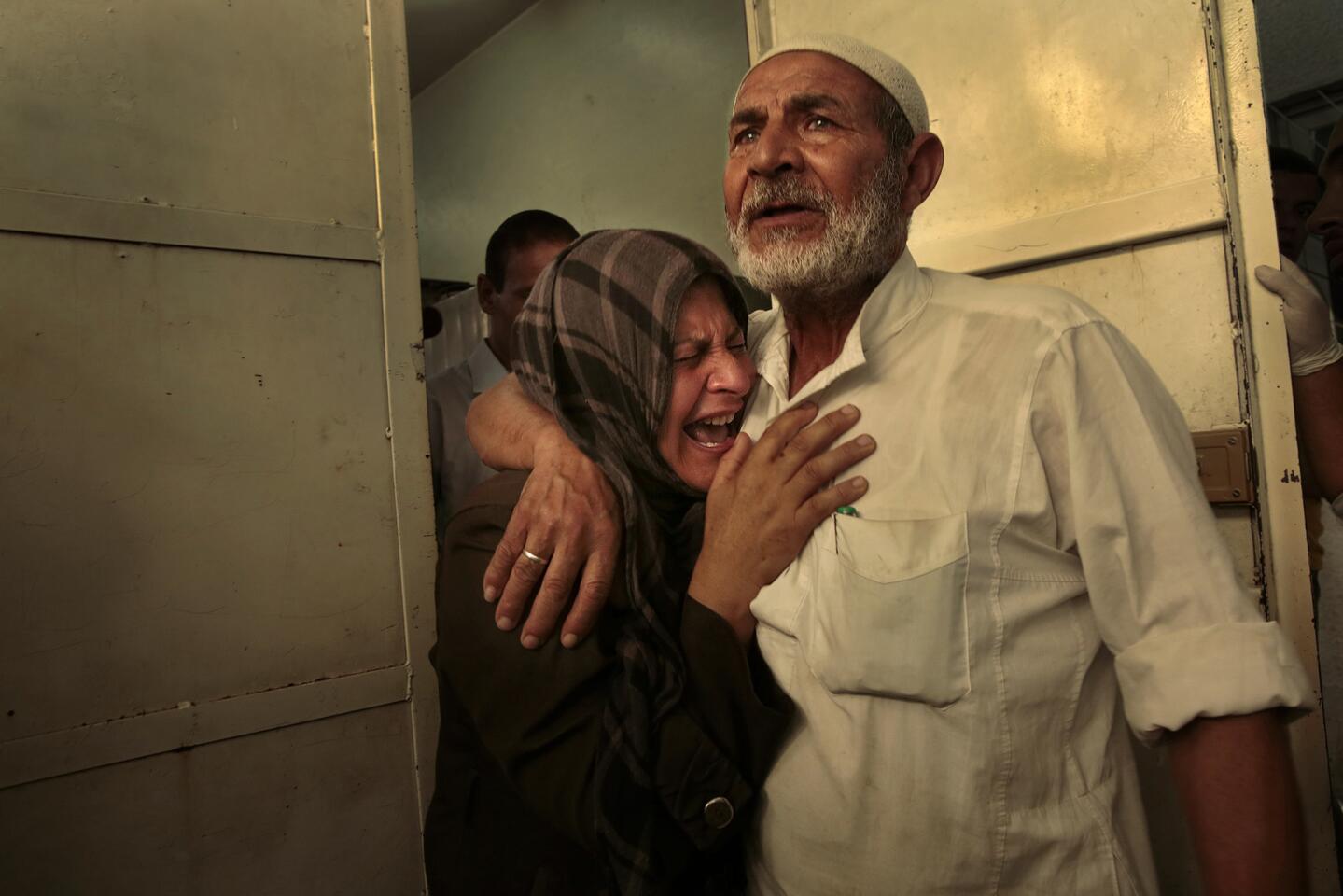
A man and woman leave the hospital morgue at the Jabaliya refugee camp in Gaza on July 30 after viewing the body of a female relative killed in the shelling of a U.N. school. (Carolyn Cole / Los Angeles Times)
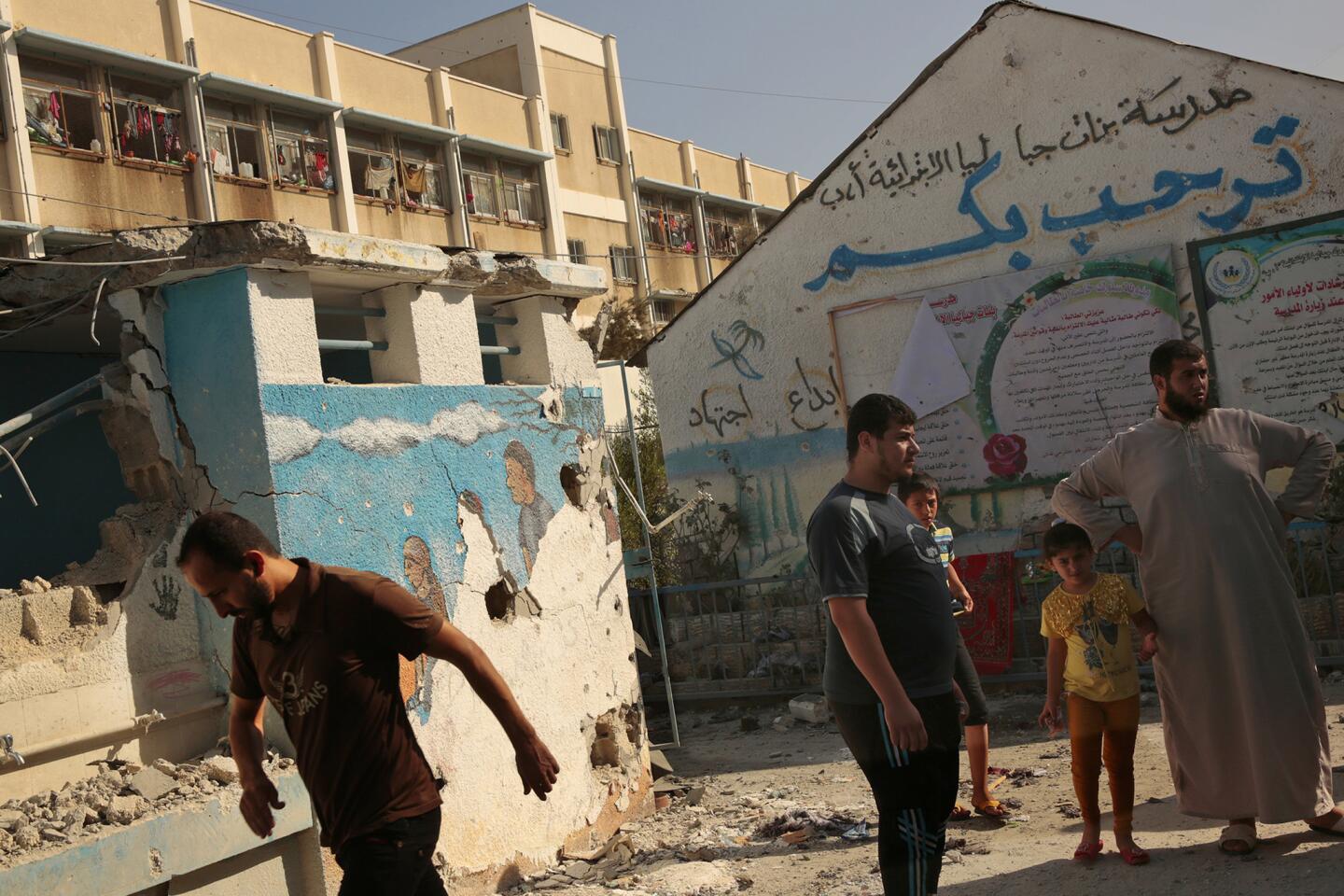
People survey the damage after a U.N. school being used as a shelter by hundreds of displaced people at Gaza’s Jabaliya refugee camp was hit by shells on July 30. (Carolyn Cole / Los Angeles Times)
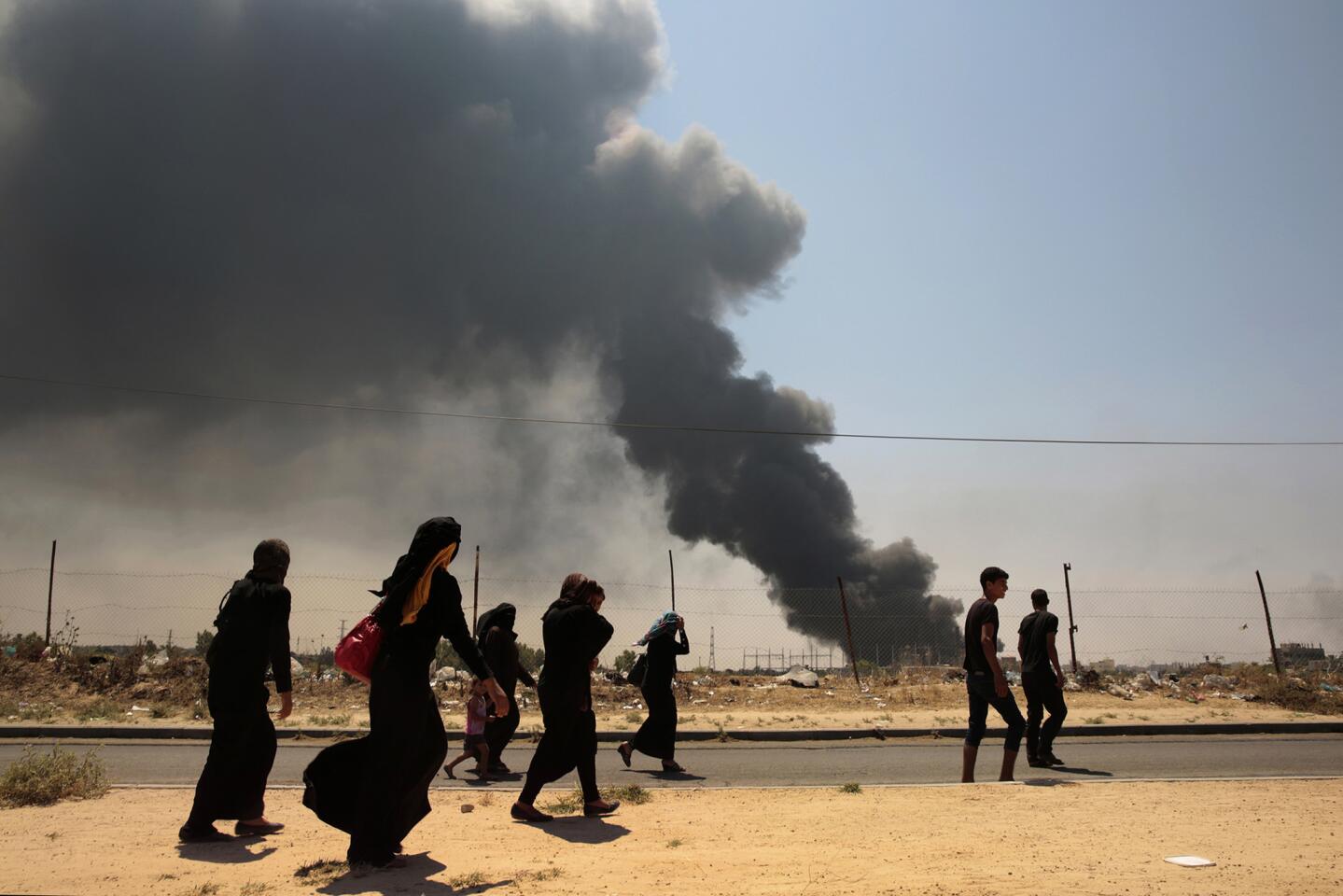
People flee bombing in the town of Nuseirat in the Gaza Strip on July 29. (Carolyn Cole / Los Angeles Times)
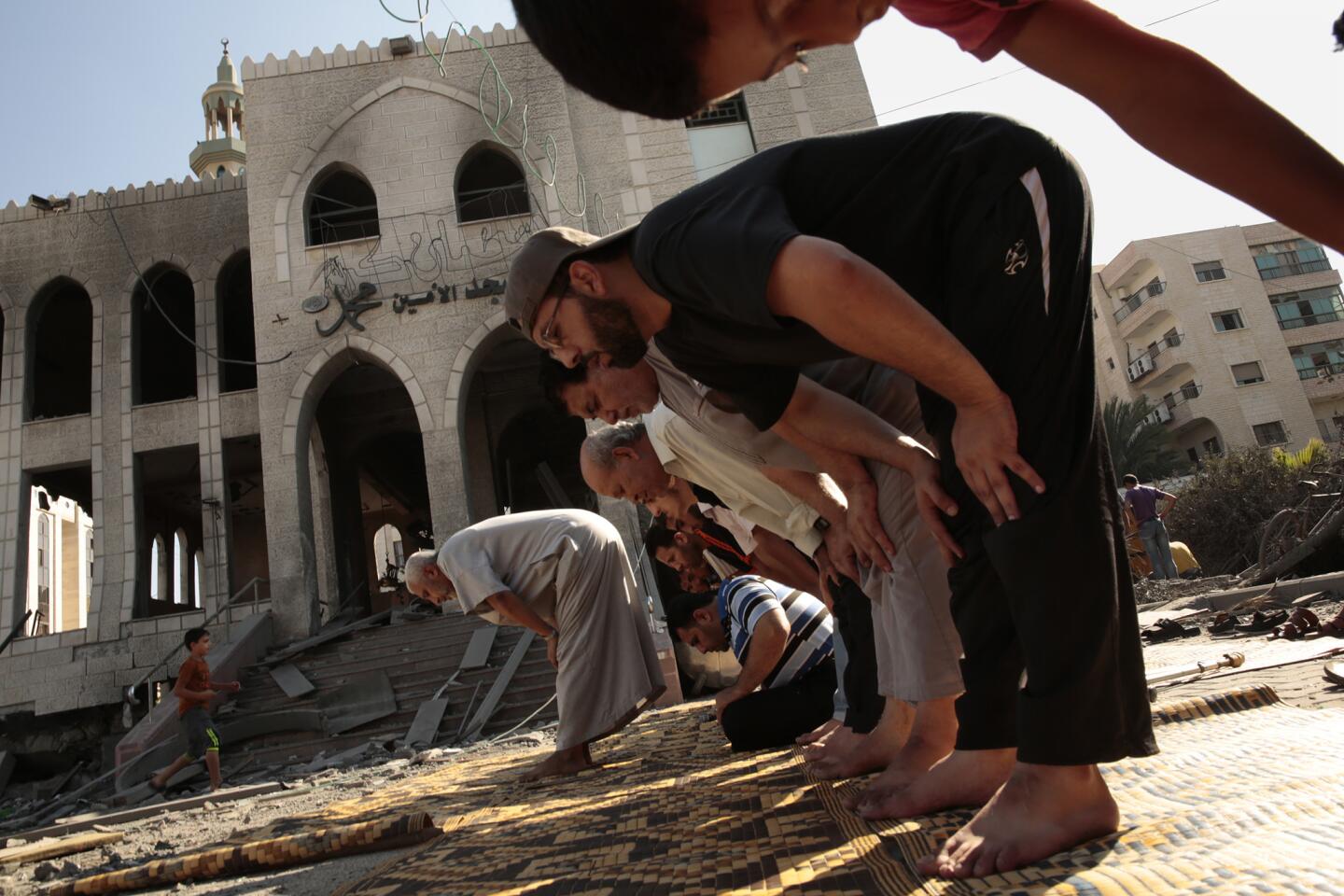
Men gather to pray outside the Ameen Mohammed mosque in Gaza City. The mosque was damaged during overnight bombing. (Carolyn Cole / Los Angeles Times)
Advertisement
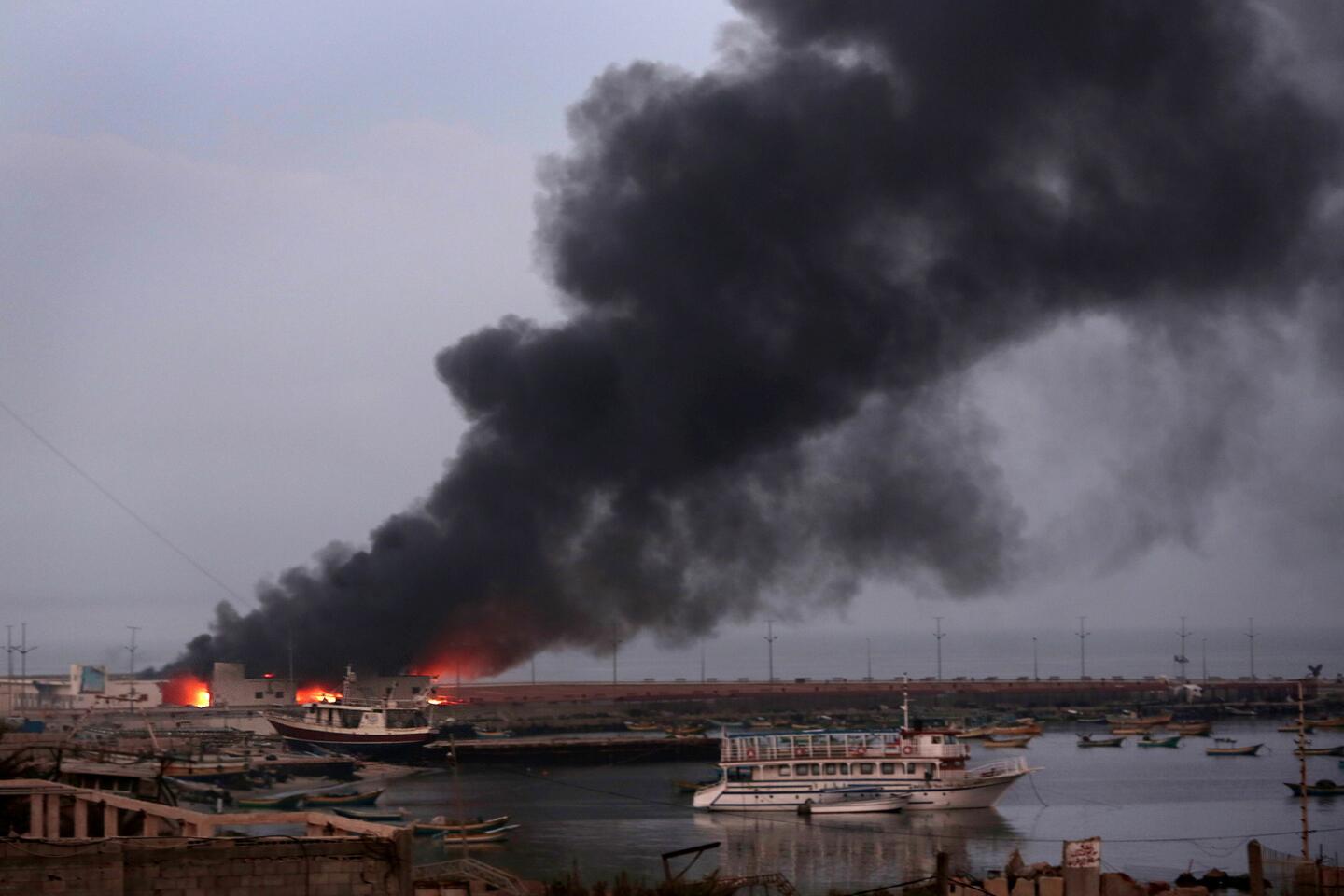
Smoke billows from the Gaza Strip. (Carolyn Cole / Los Angeles Times)
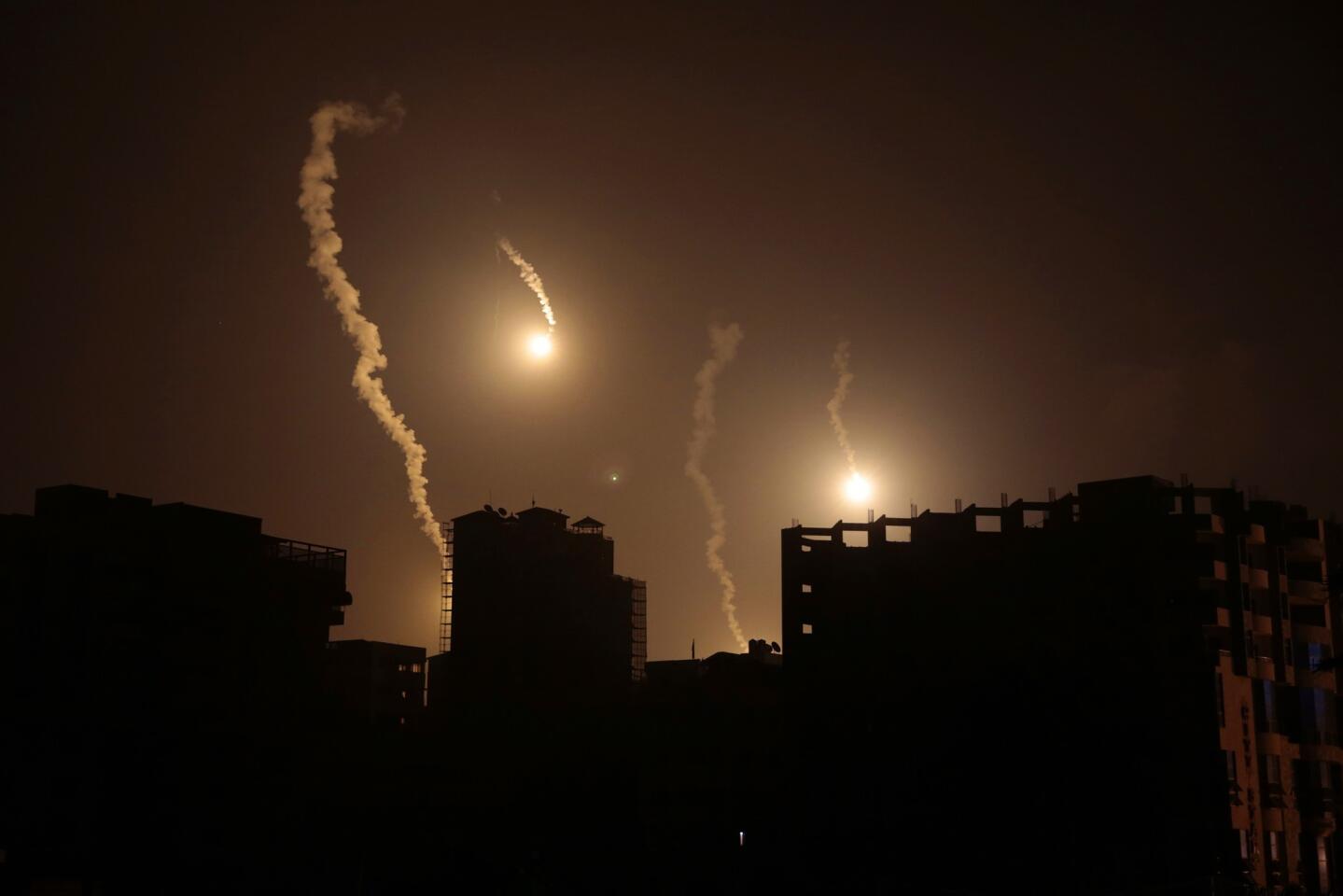
Flares light up the sky in downtown Gaza City during an all-night Israeli operation early Tuesday. (Carolyn Cole / Los Angeles Times)
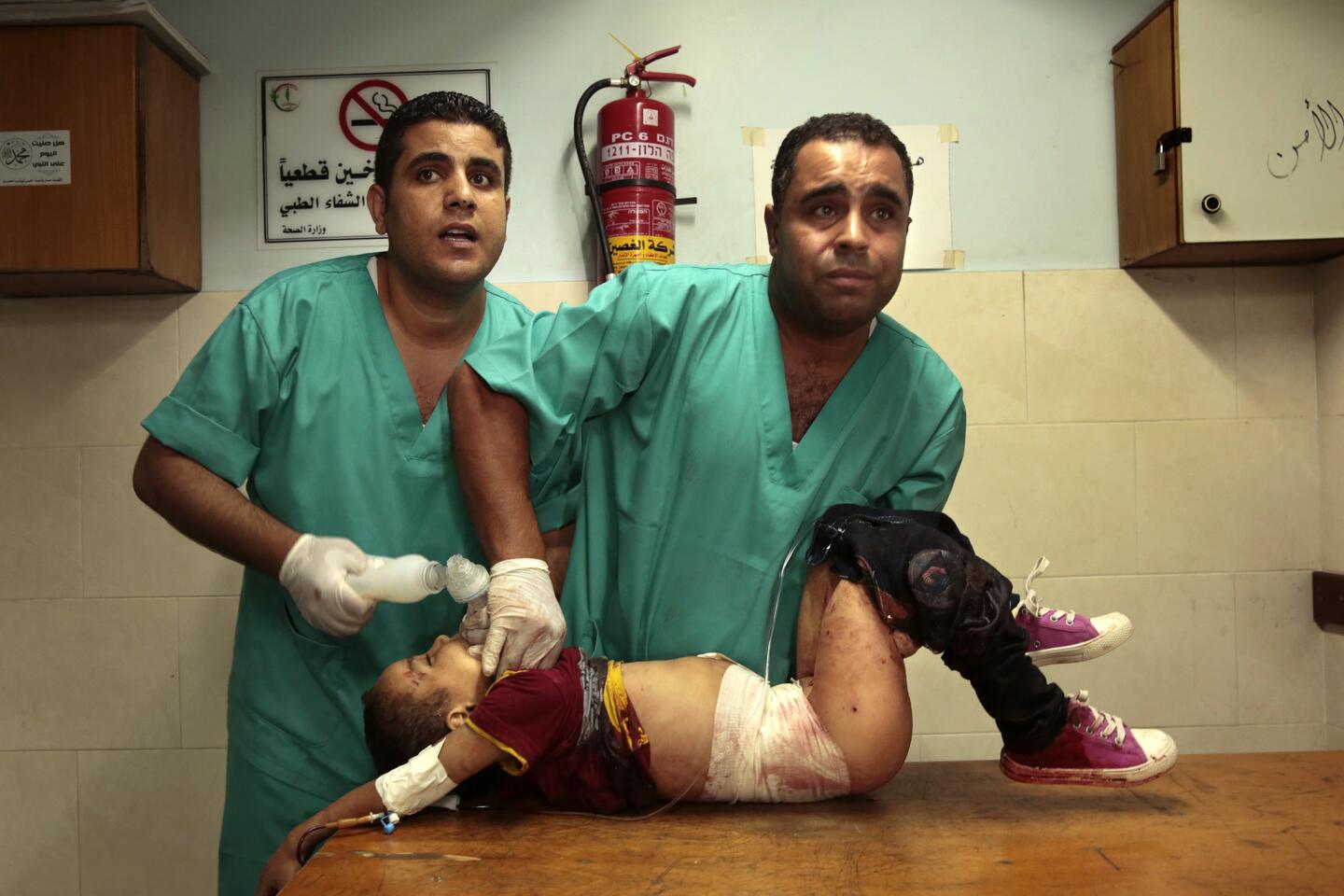
Doctors try to keep a girl breathing at Shifa Hospital after she was injured in an explosion in Gaza City. (Carolyn Cole / Los Angeles Times)
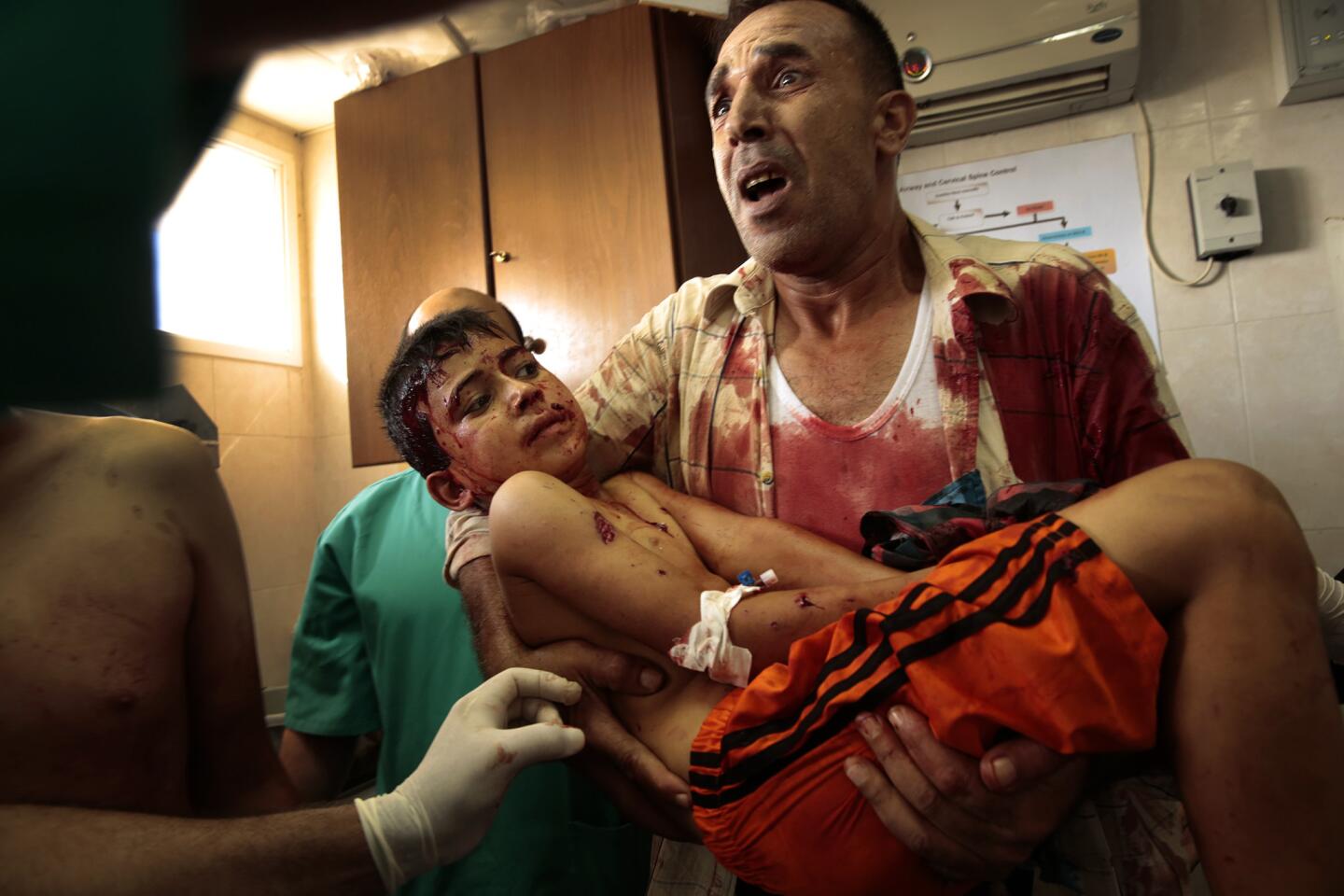
A number of children were killed after an explosion in downtown Gaza City. The wounded were rushed to Gaza City hospital. (Carolyn Cole / Los Angeles Times)
Advertisement
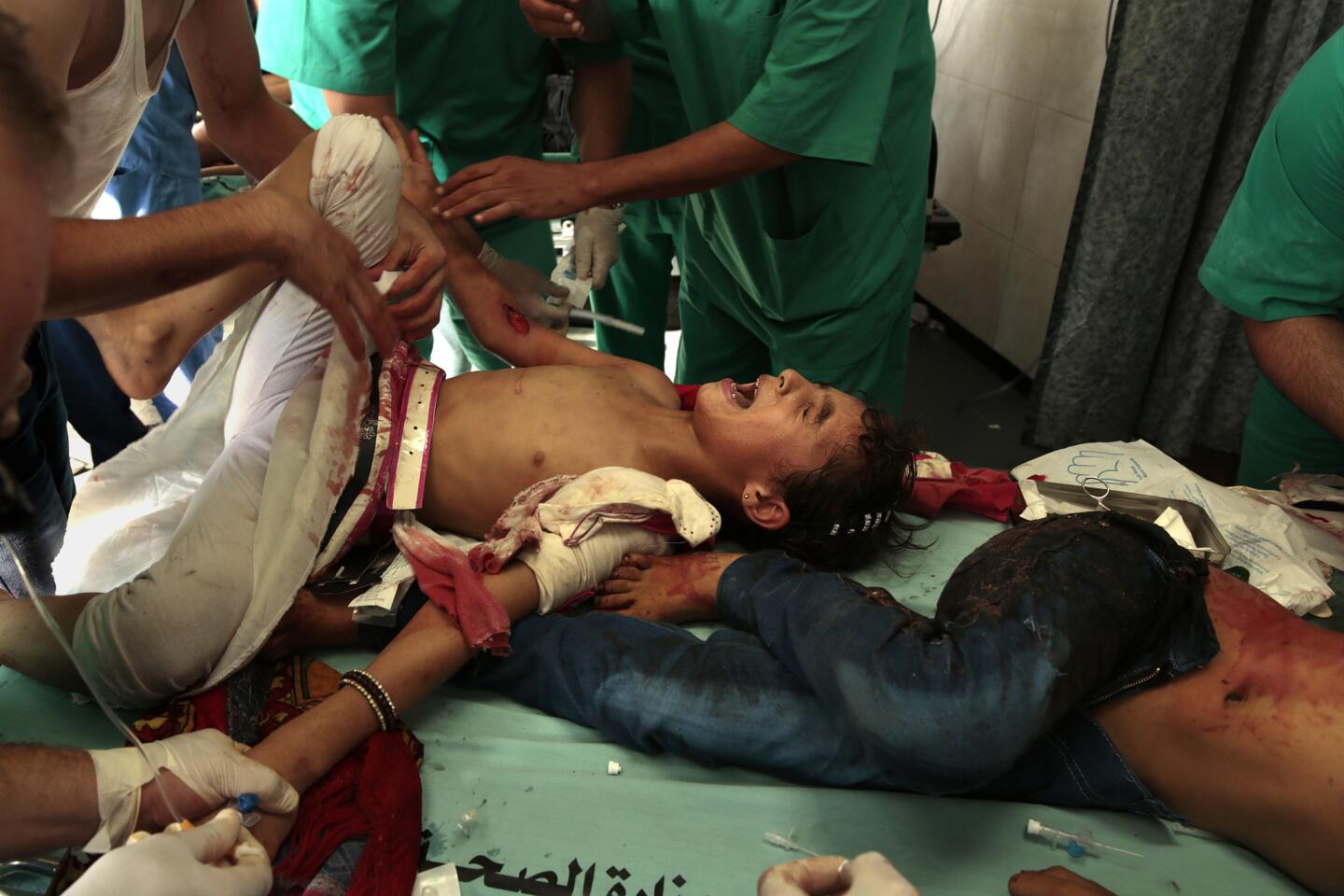
Medics work on two wounded children at Shifa Hospital after an explosion in downtown Gaza City Monday, July 28, 2014. (Carolyn Cole / Los Angeles Times)
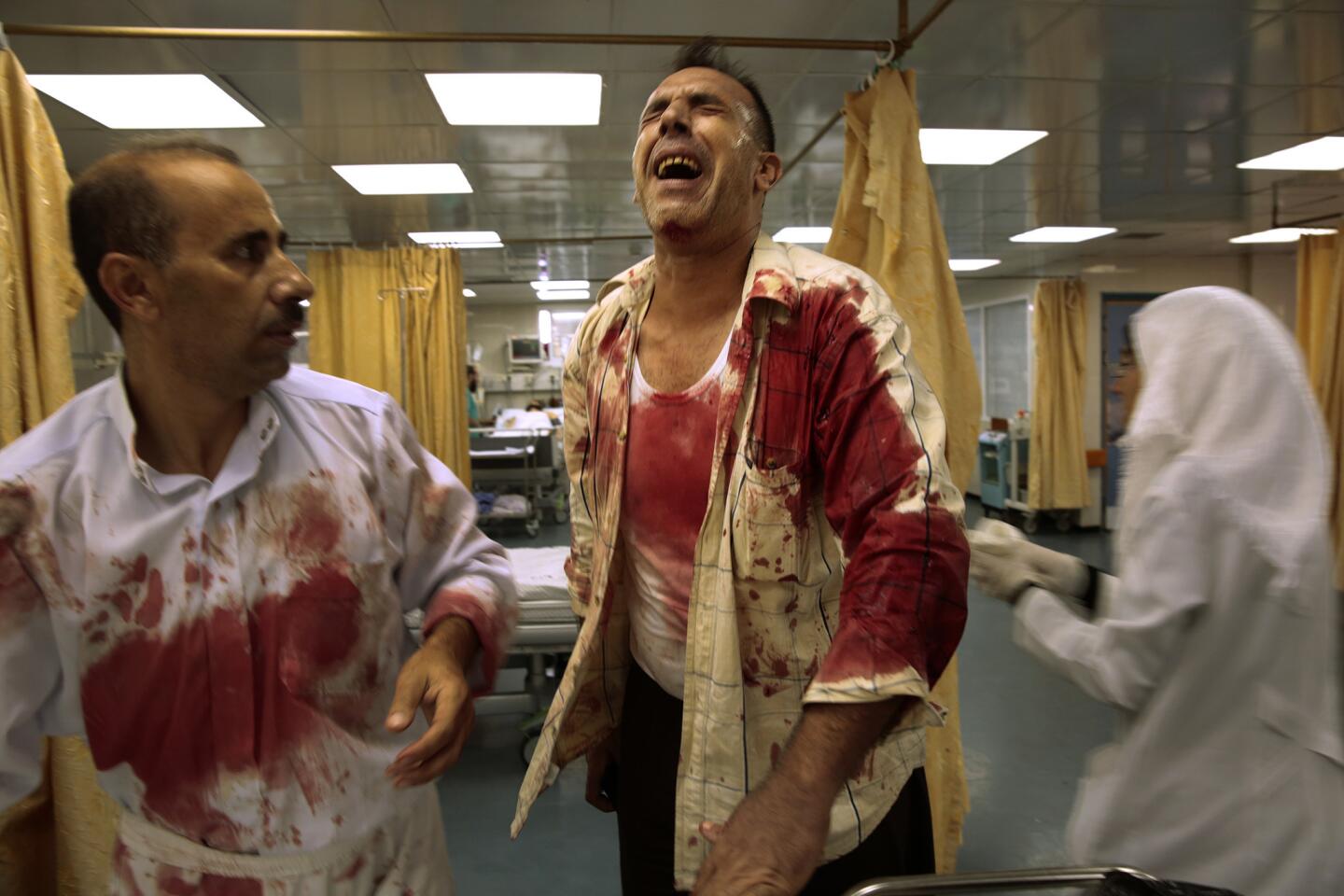
A man weeps after one son was killed and another was injured in a rocket explosion in Gaza City. (Carolyn Cole / Los Angeles Times)
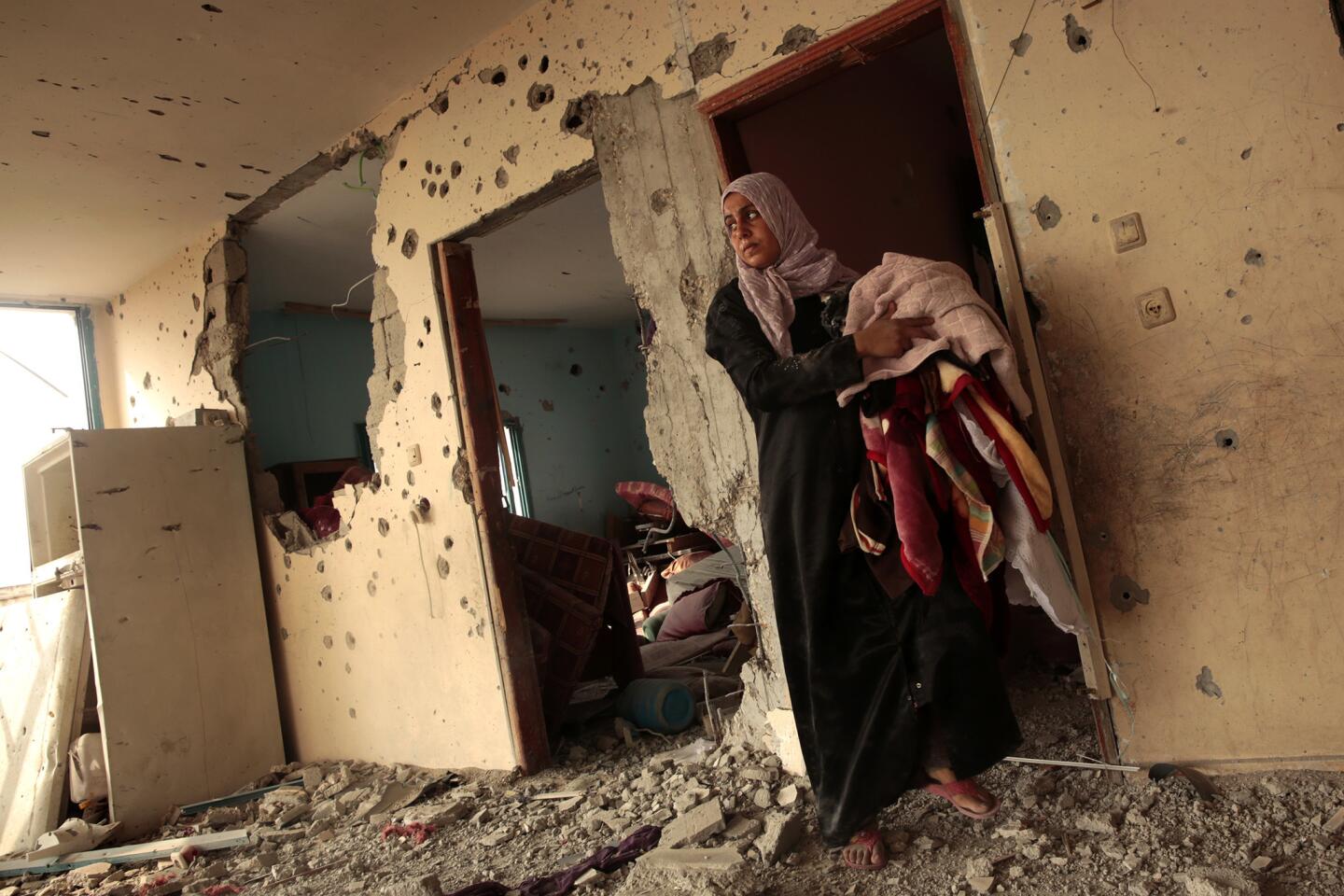
Despite a 24-hour-ceasefire for the Eid celebration, explosions could still be heard as women return to their destroyed homes in Beit Hanoun to recover what they can. (Carolyn Cole / Los Angeles Times)
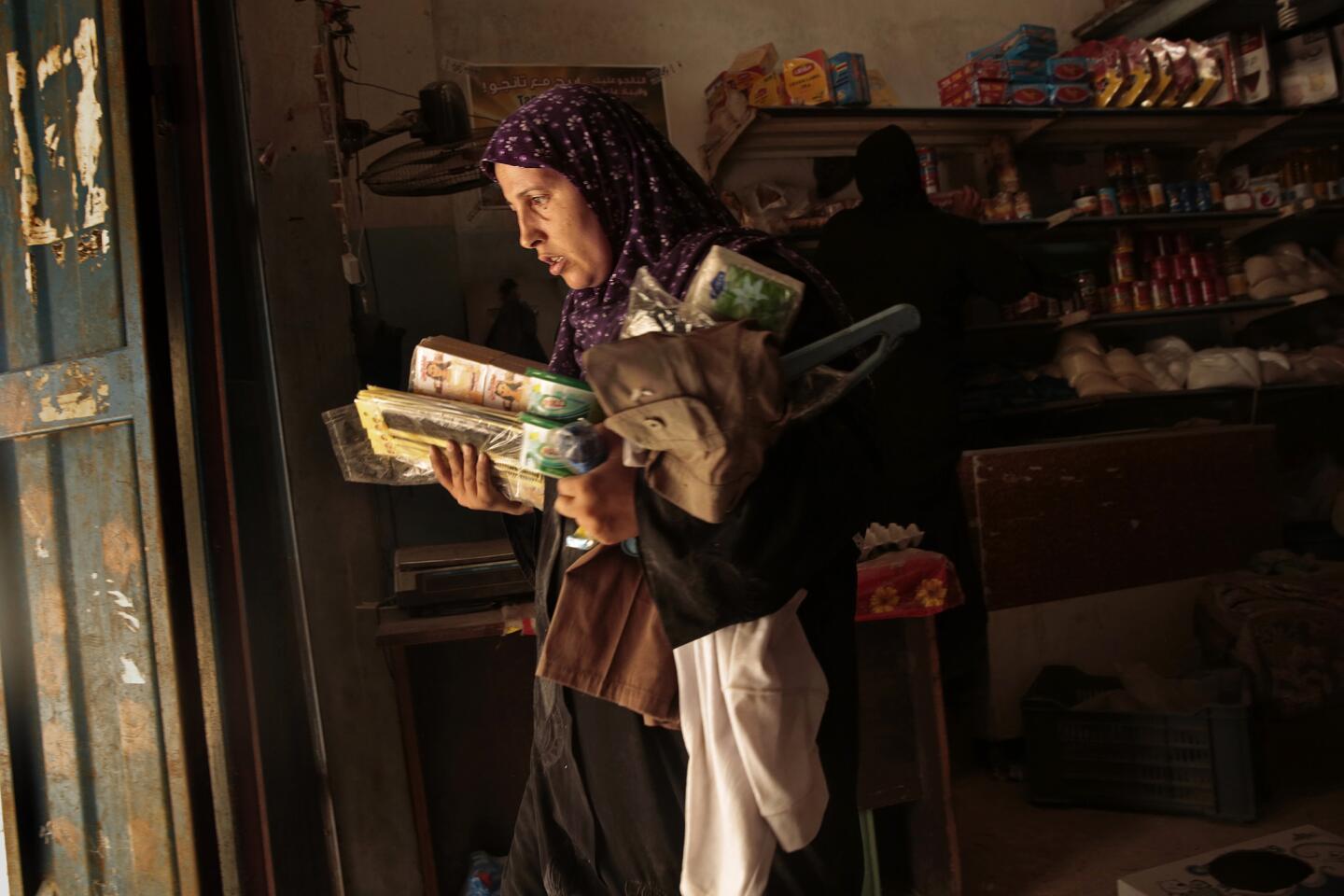
Having lost everything they owned in the Israeli bombing of their homes in Beit Hanoun, women loot from a store left open when the bombing began. (Carolyn Cole / Los Angeles Times)
Advertisement
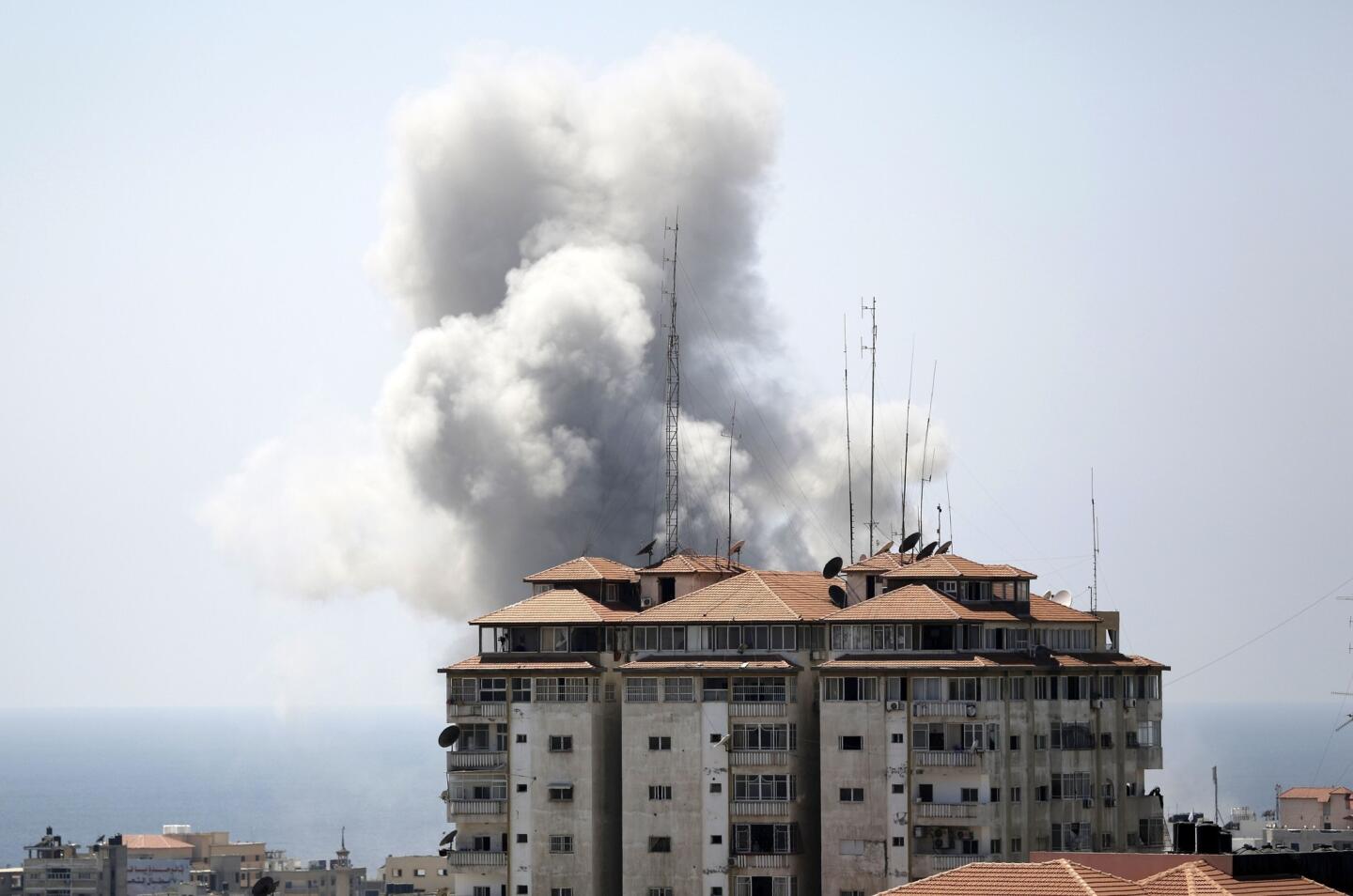
Smoke billows from a Gaza City building hit by an Israeli airstrike on July 27. (Mohammed Abed / AFP/Getty Images)
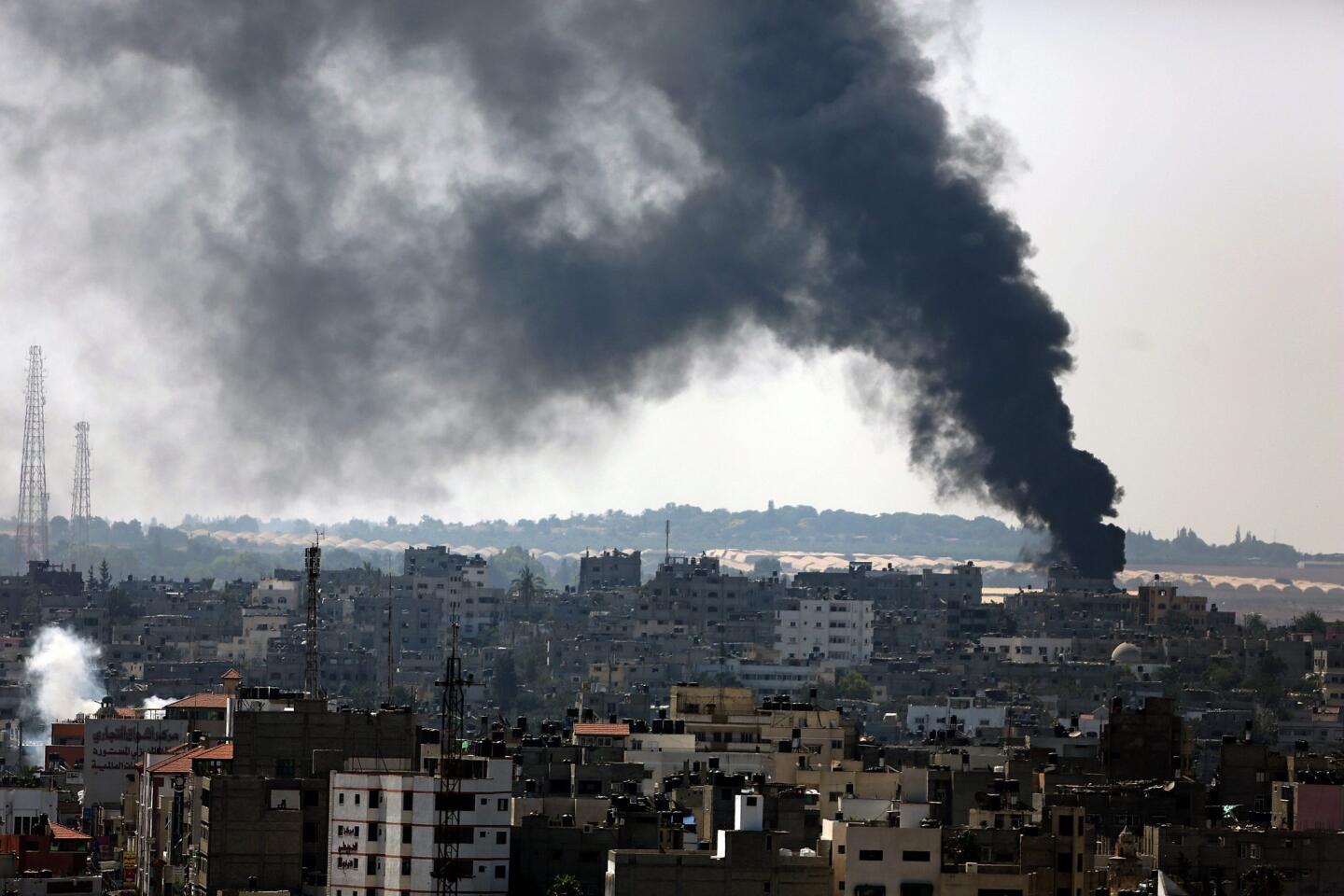
Smoke rises as Israeli tanks shell a neighborhood in eastern Gaza City on July 27. (Mohammed Saber / EPA)
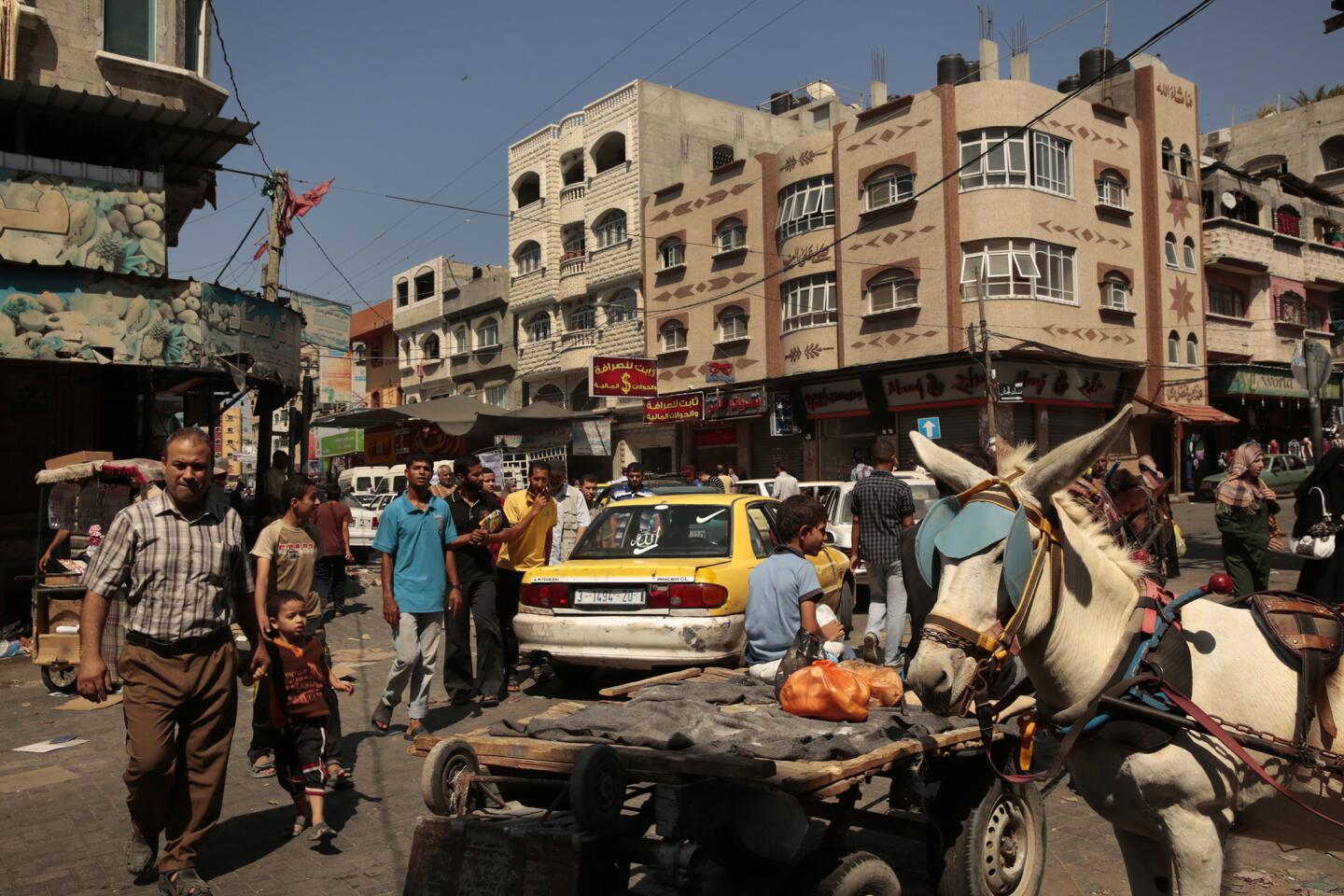
People go to the market in Jabalia area of Gaza on July 26 to prepare for the breaking of fast on the last night of Ramadan. (Carolyn Cole / Los Angeles Times)
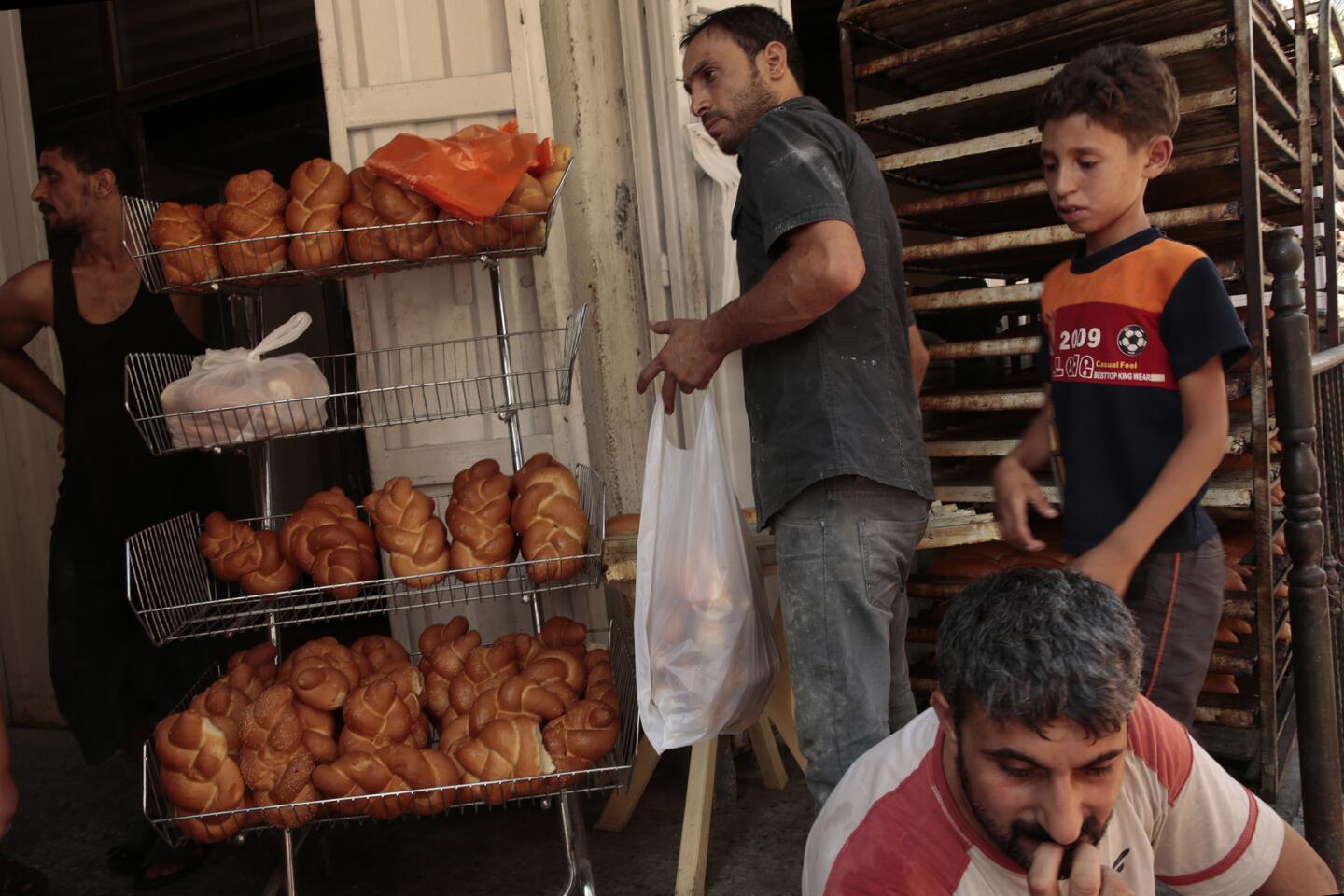
Bread is on sale in the Jabalia market in Gaza City on July 26 despite the uncertainty of a cease-fire. (Carolyn Cole / Los Angeles Times)
Advertisement
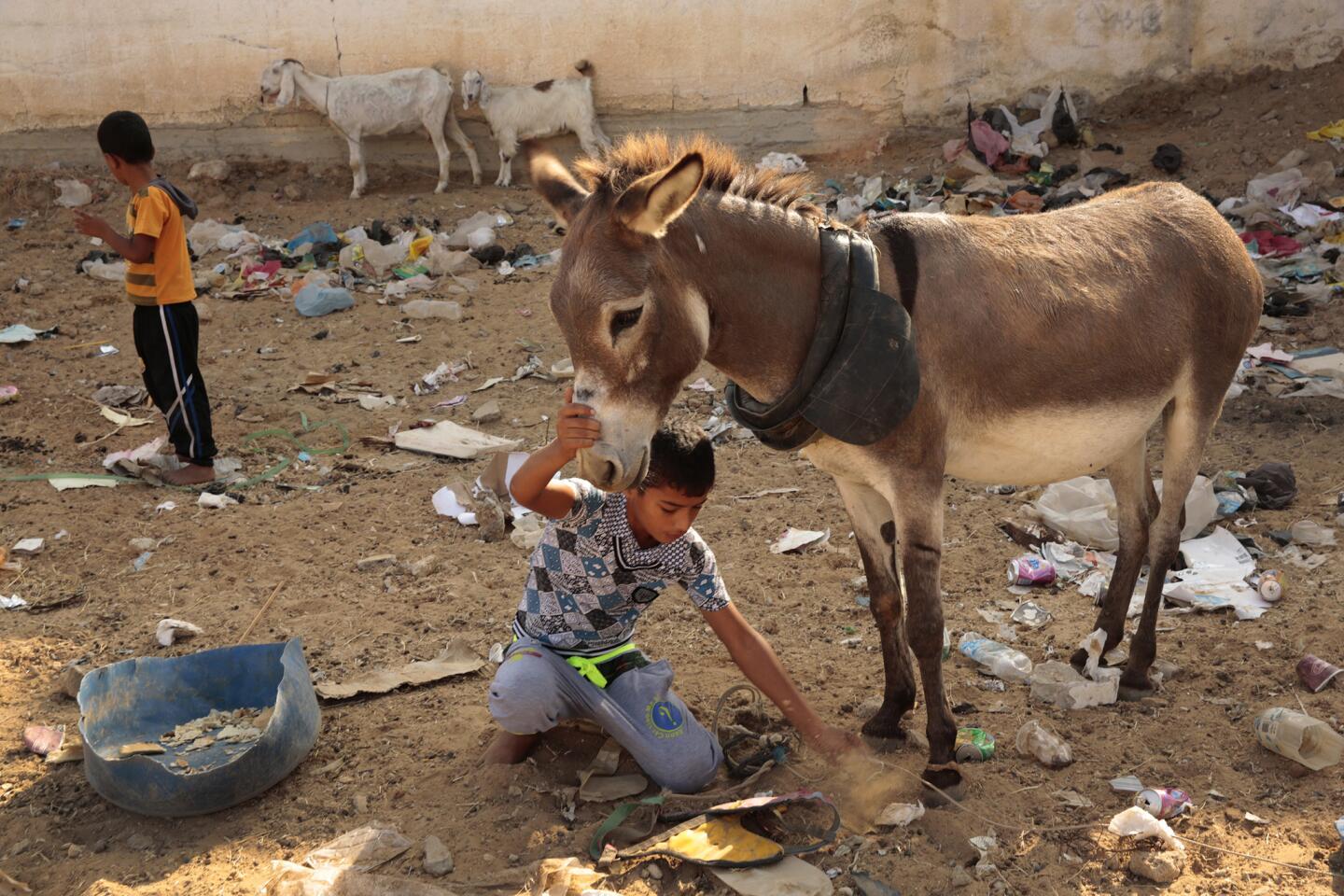
During a July 26 cease-fire in Gaza, a boy puts a harness on a donkey in a dirt yard, where animals feed on garbage. Food and water for the working animals of Gaza is not readily available. (Carolyn Cole / Los Angeles Times)
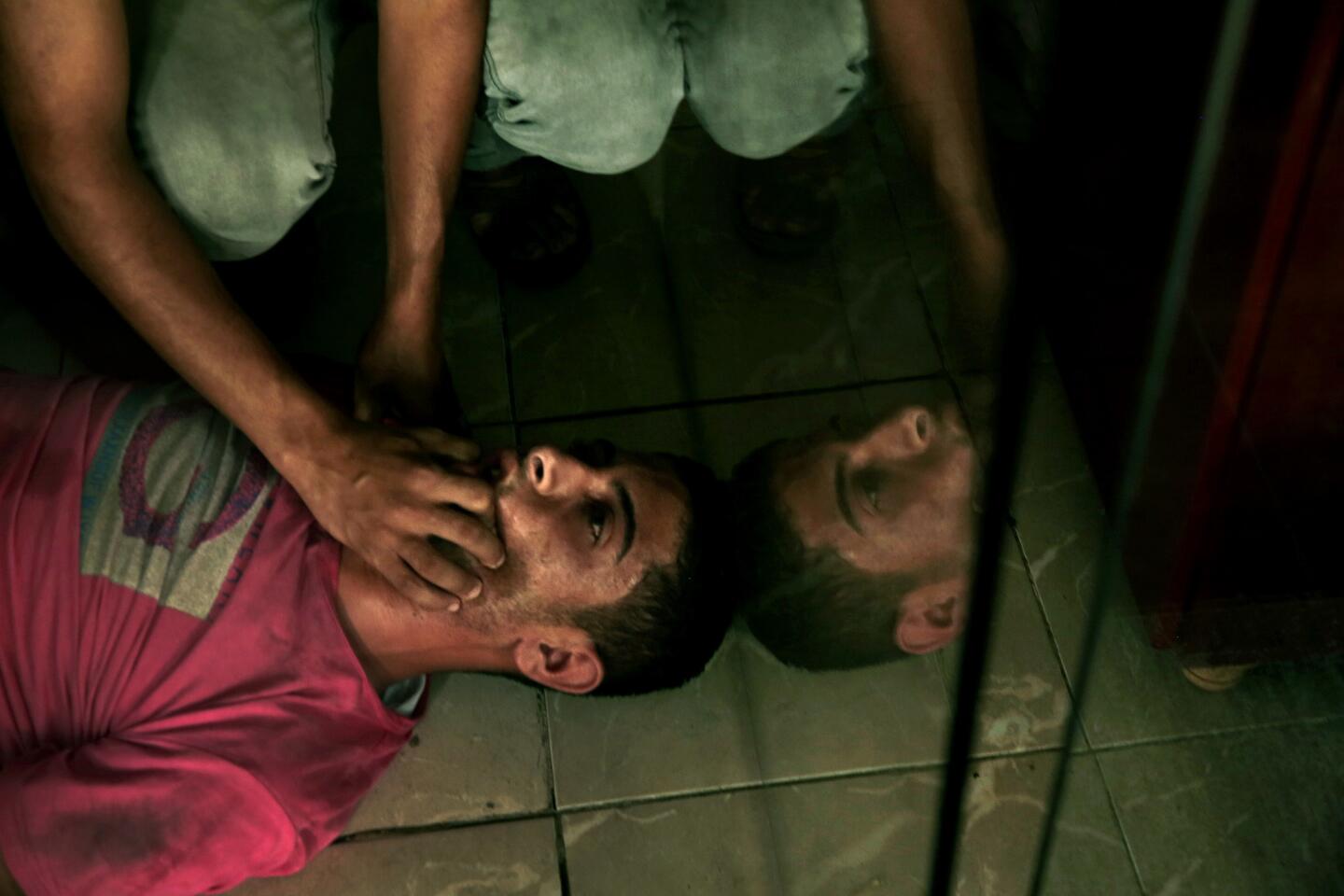
A man in Gaza City lies on the floor July 26 after passing out from heat exhaustion on the final day of Ramadan fasting. (Carolyn Cole / Los Angeles Times)
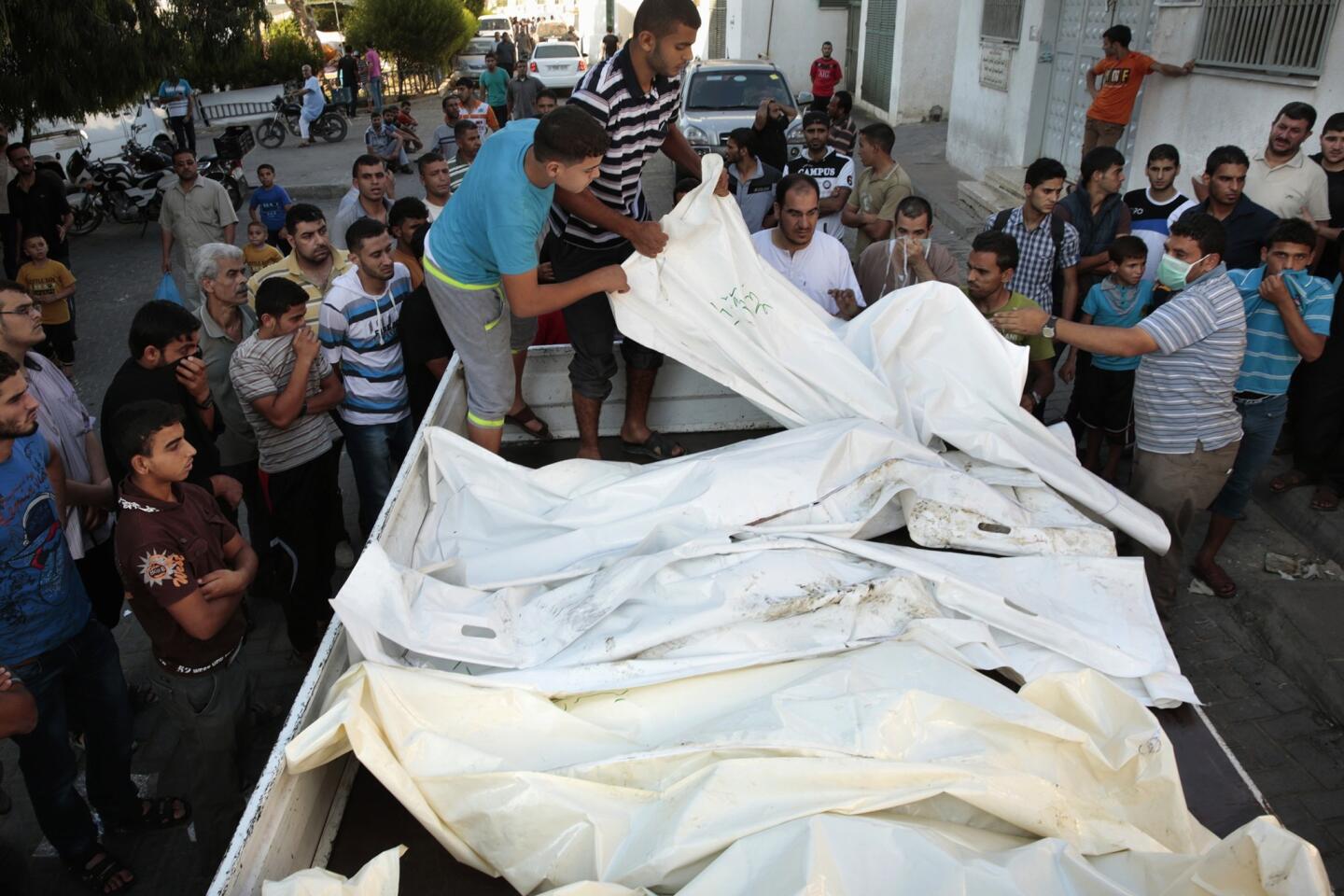
Eleven members of the Hilo family, who all died in the bombing of their Shajaiya home, are taken for burial in Gaza. (Carolyn Cole / Los Angeles Times)
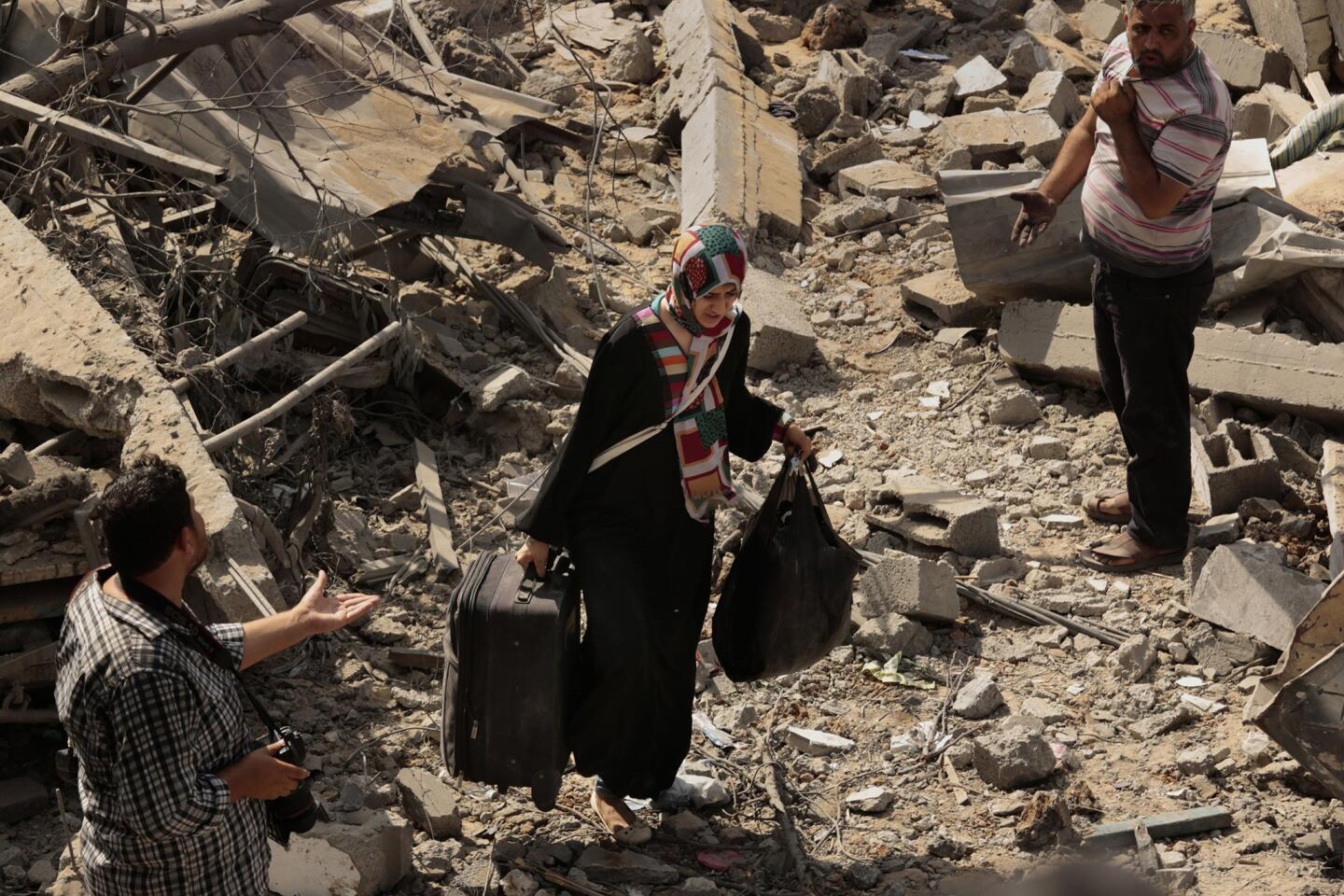
At the start of a 12-hour cease-fire, people scour the rubble of their homes in the Shajaiya neighborhood of Gaza City, looking for the dead and recovering what they can. (Carolyn Cole / Los Angeles Times)
Advertisement
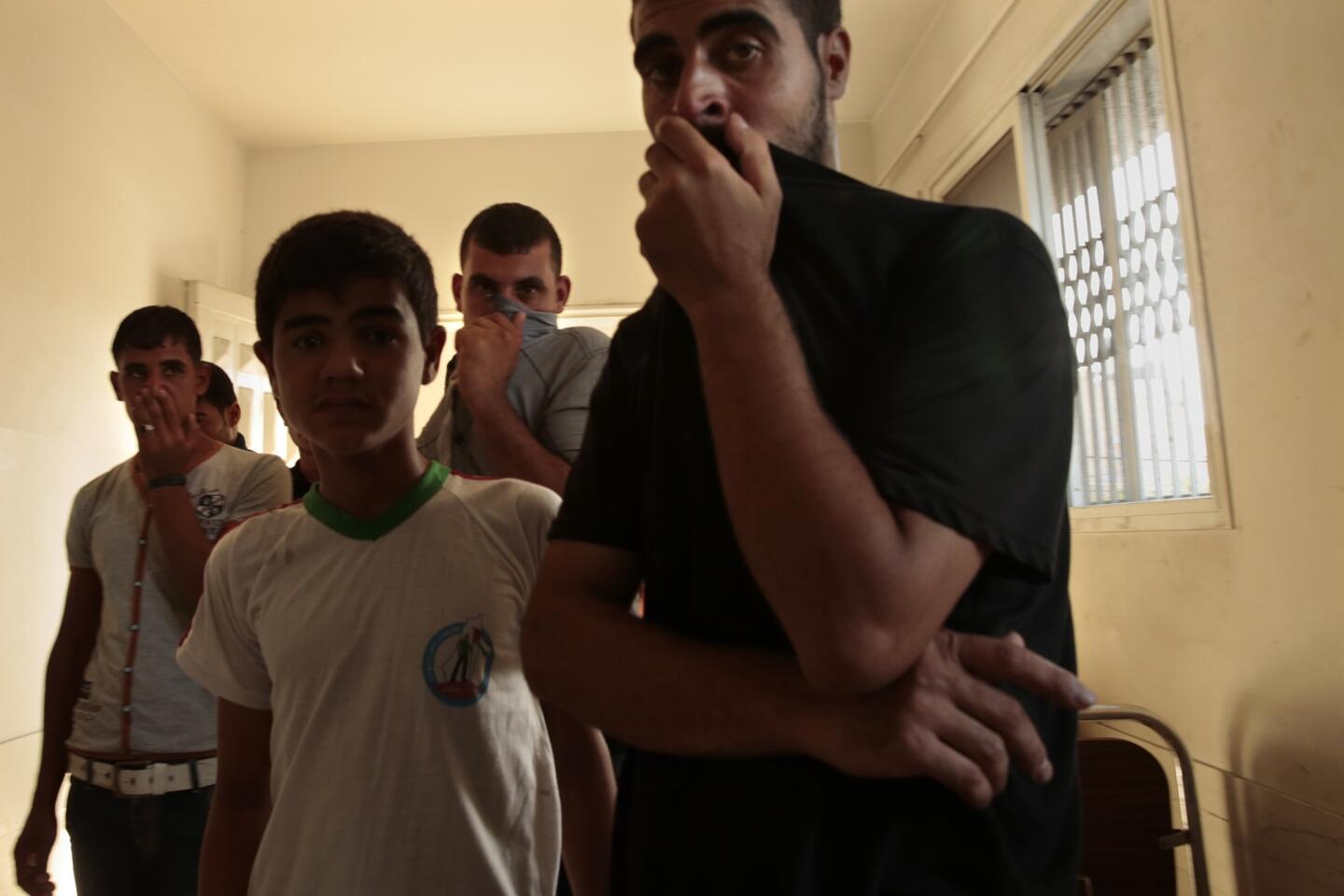
Men wait at a morgue in Gaza City to recover the bodies of 11 members of the Hilo family, who were killed about a week ago and whose bodies were just recovered during the cease-fire. (Carolyn Cole / Los Angeles Times)
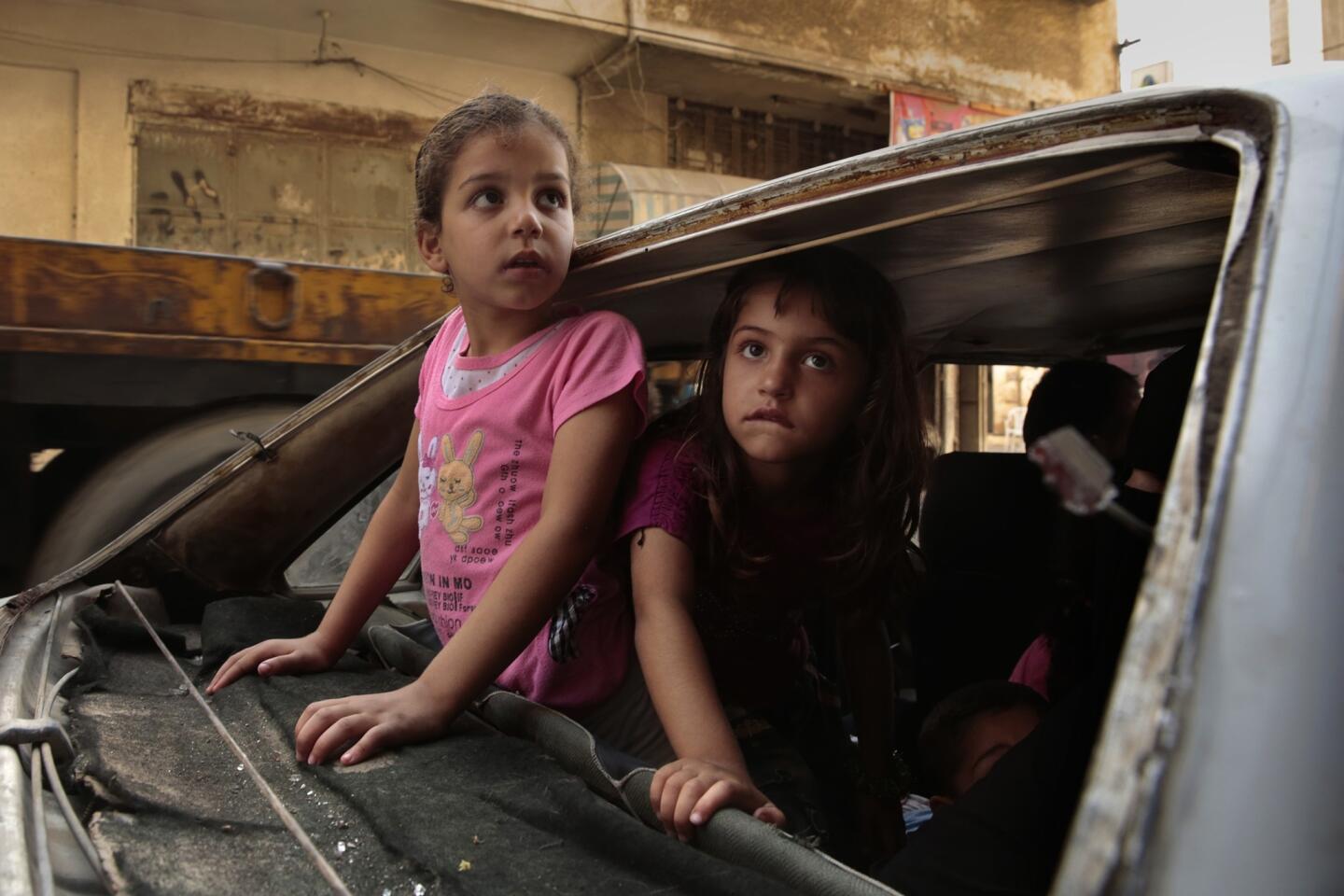
Girls look out from their father’s car, which was damaged in the Shajaiya area of Gaza City. (Carolyn Cole / Los Angeles Times)
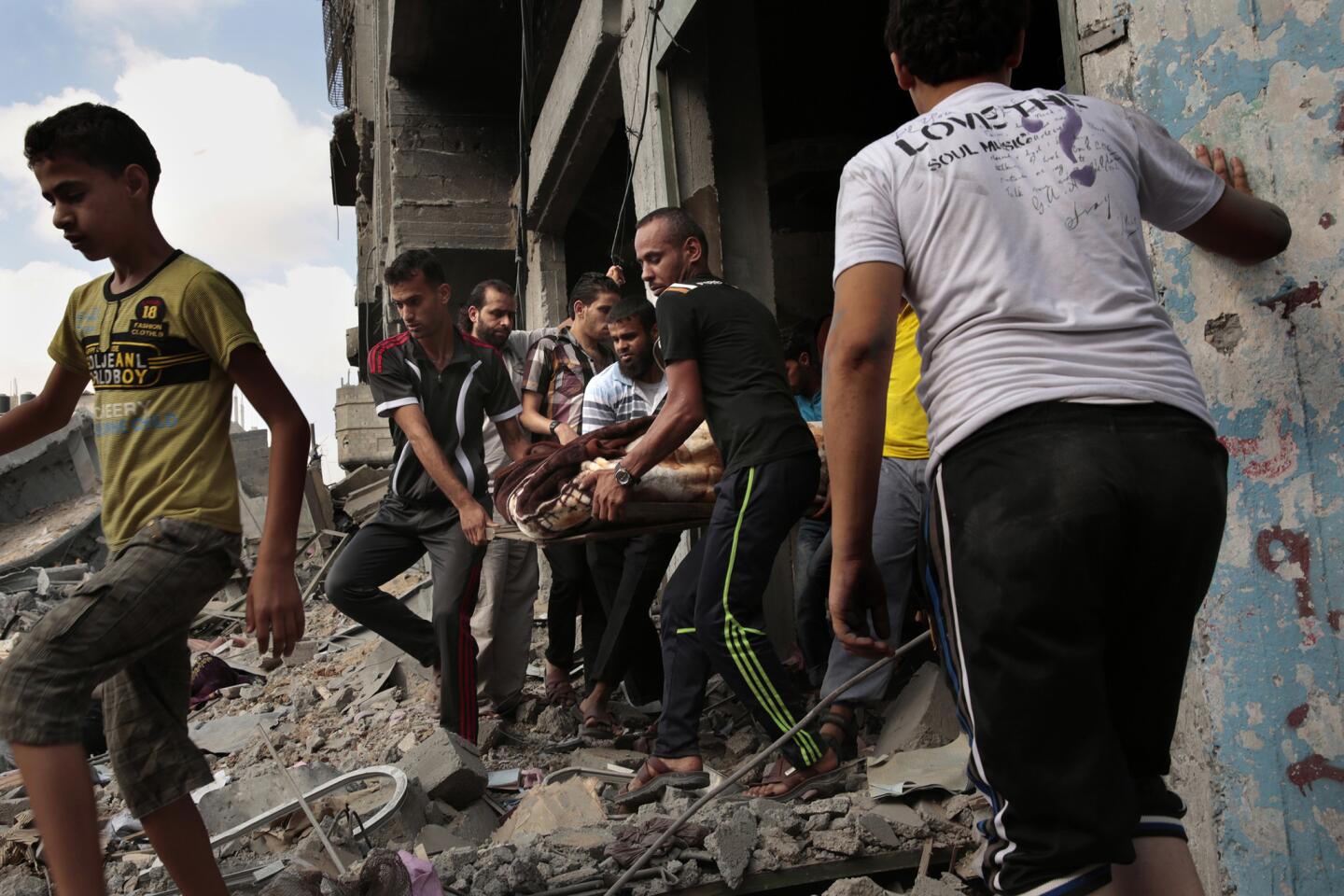
Men remove the body of a dead man from a building in the Shejaiya area of Gaza City. During a 12-hour cease-fire, people scoured the rubble of their homes in the neighborhood, looking for bodies and recovering belongings. (Carolyn Cole / Los Angeles Times)
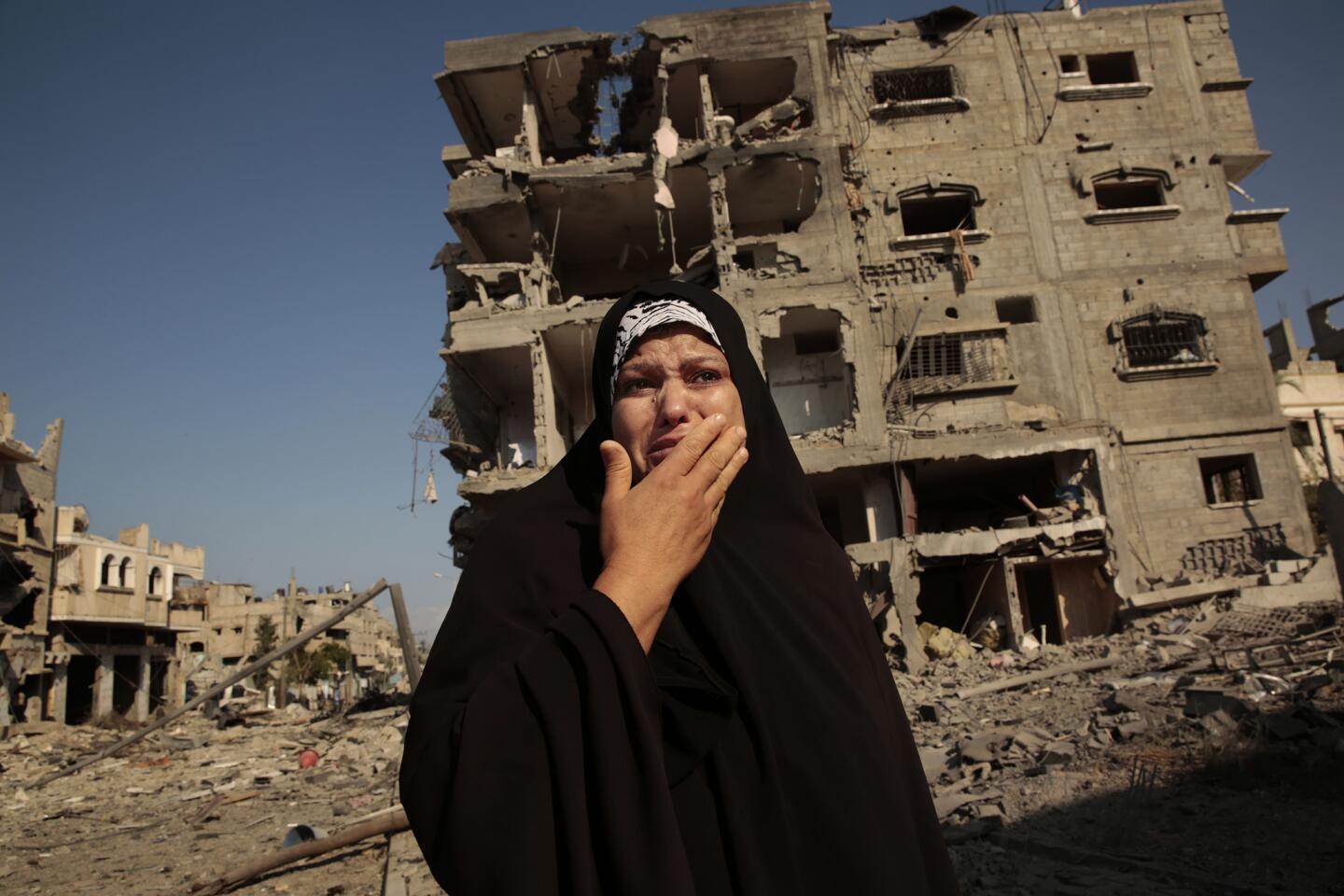
A woman cries as she tries to return to her home in the conflict-shattered Shejaiya neighborhood of Gaza City on July 26. (Carolyn Cole / Los Angeles Times)
Advertisement
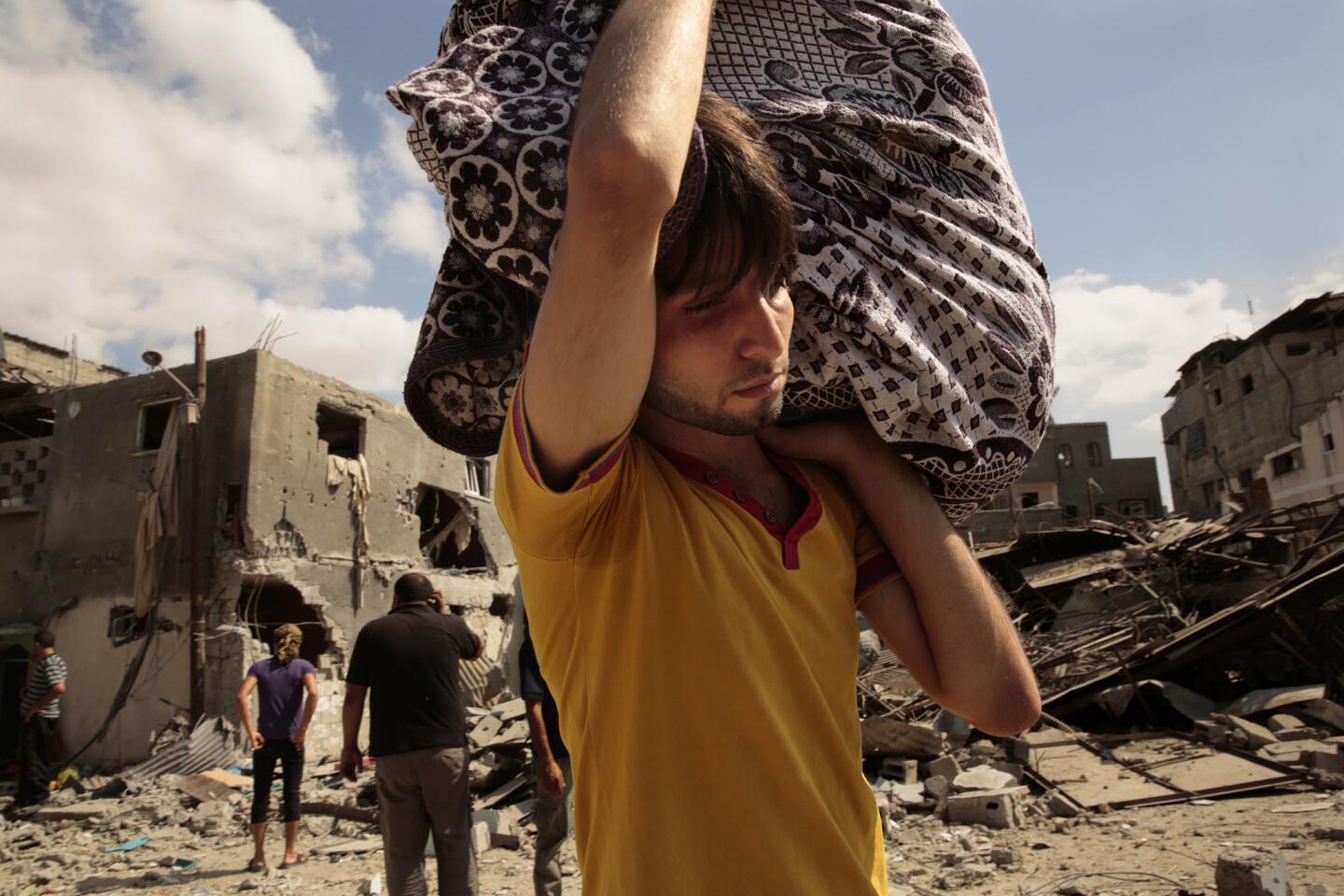
At the start of a 12-hour cease-fire in Gaza on July 26, people remove belongings from their damaged homes in the Shejaiya neighborhood of Gaza City. (Carolyn Cole / Los Angeles Times)
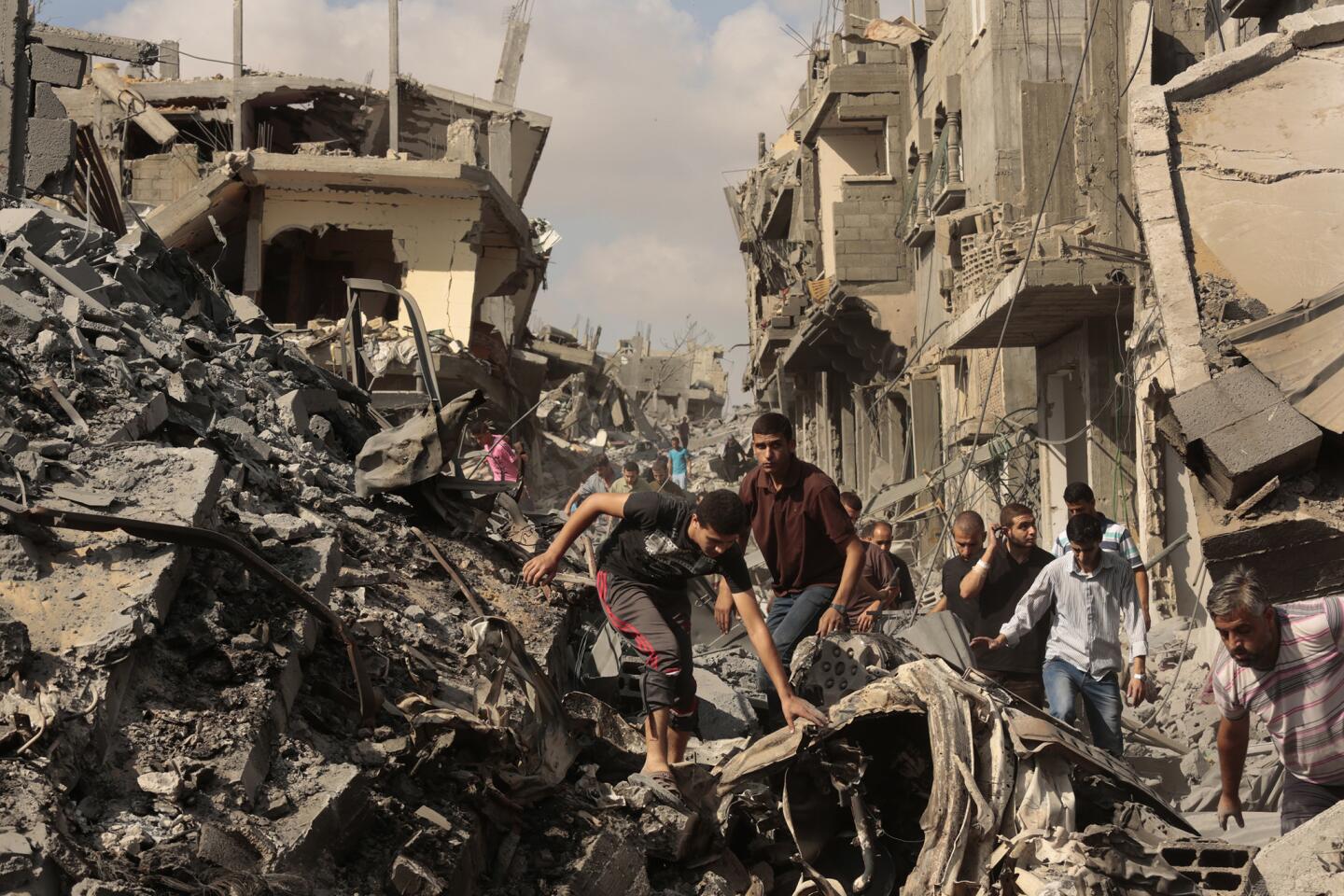
People step cautiously through the rubble of homes in Gaza City’s conflict-devastated Shejaiya neighborhood on July 26, looking for bodies and recovering their belongings. (Carolyn Cole / Los Angeles Times)
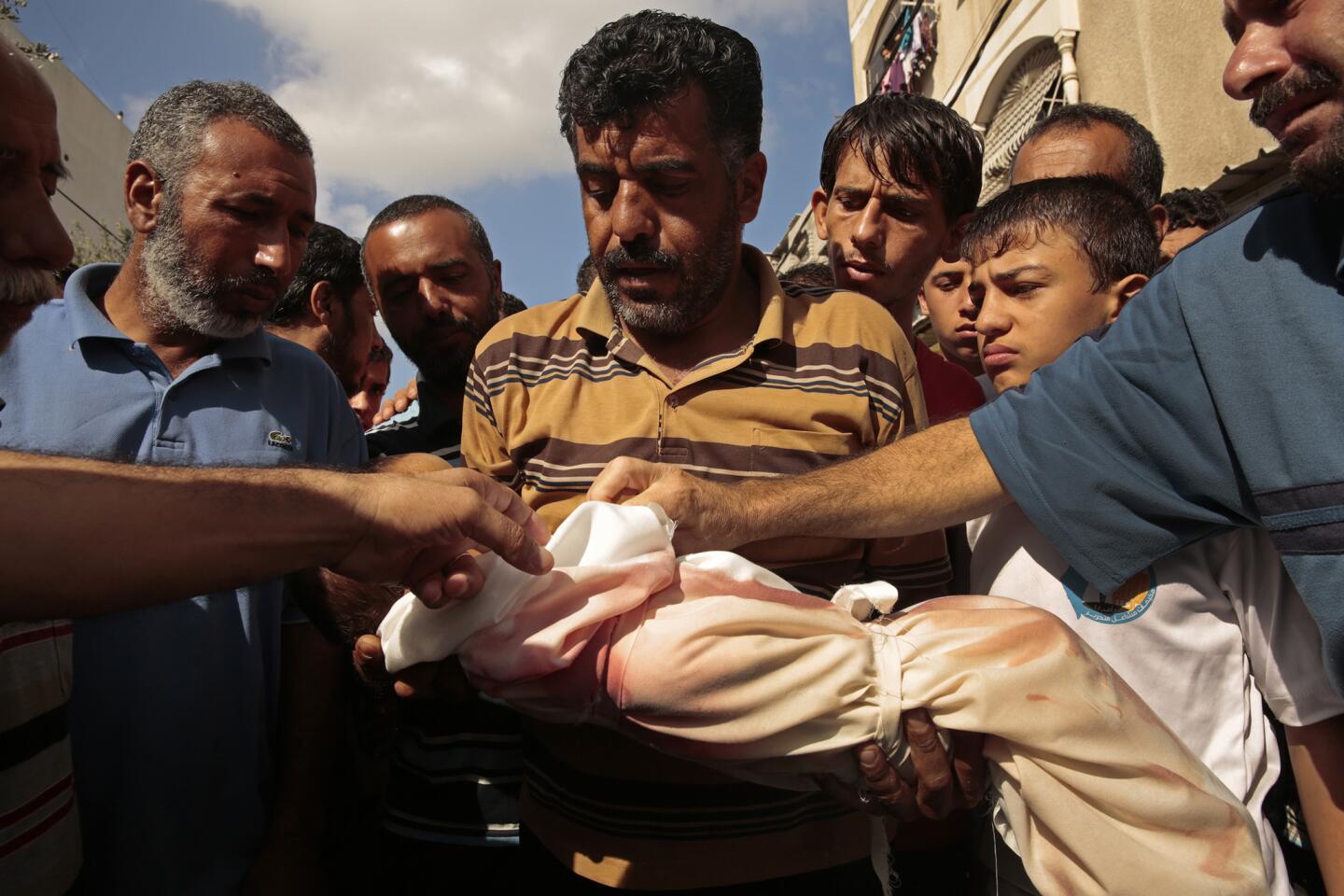
The body of 1-year-old Suha abu Misleh is prepared for burial along with nine others. All were killed in the attack on a United Nations shelter at a school in Beit Hanoun, in the Gaza Strip. (Carolyn Cole / Los Angeles Times)
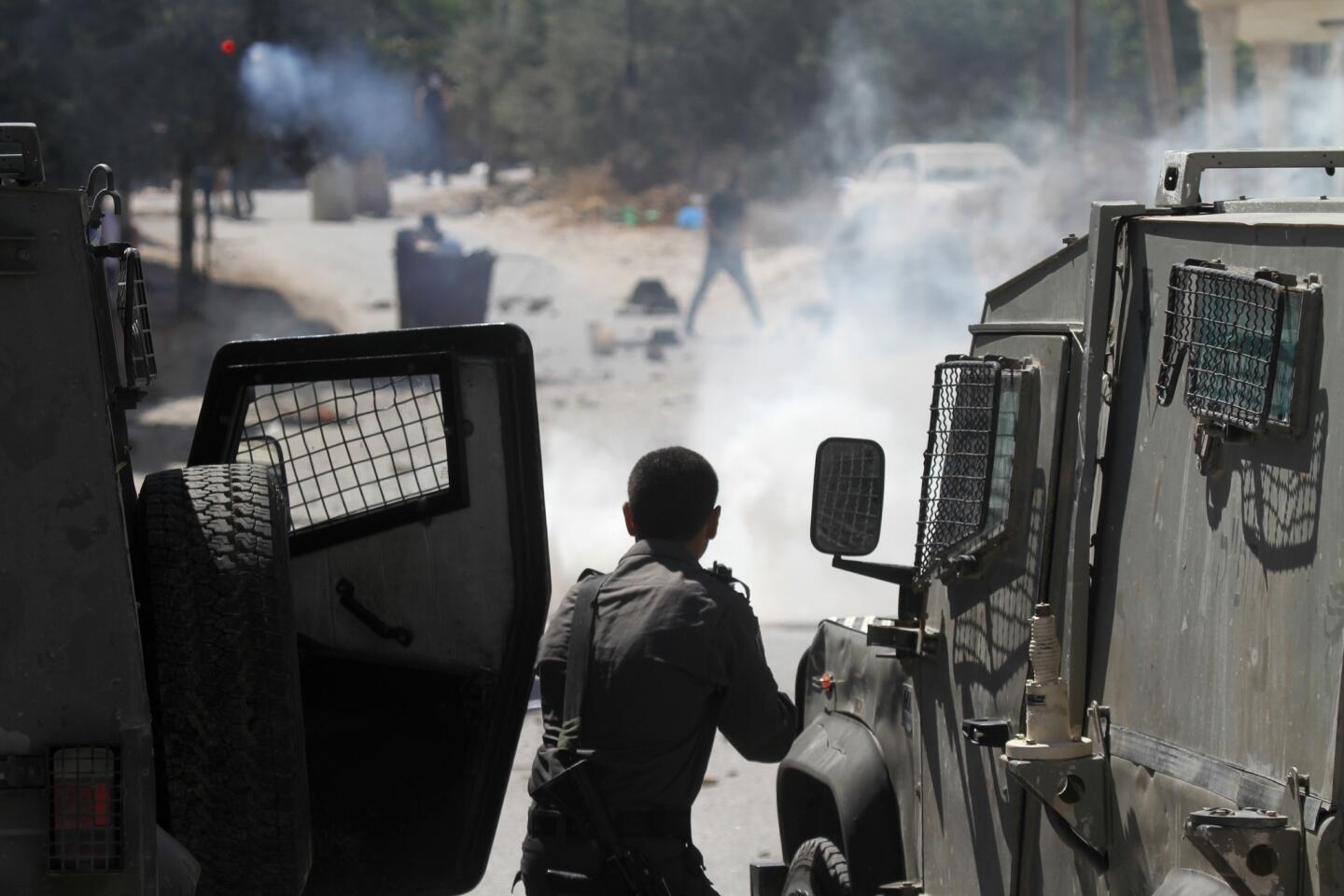
An Israeli soldier aims his weapon at a Palestinian during a clash in the village of Hawara, near the West Bank city of Nablus. Palestinians in the West Bank staged protests against Israel’s military operation in the Gaza Strip. (Nasser Ishtayeh / Associated Press )
Advertisement
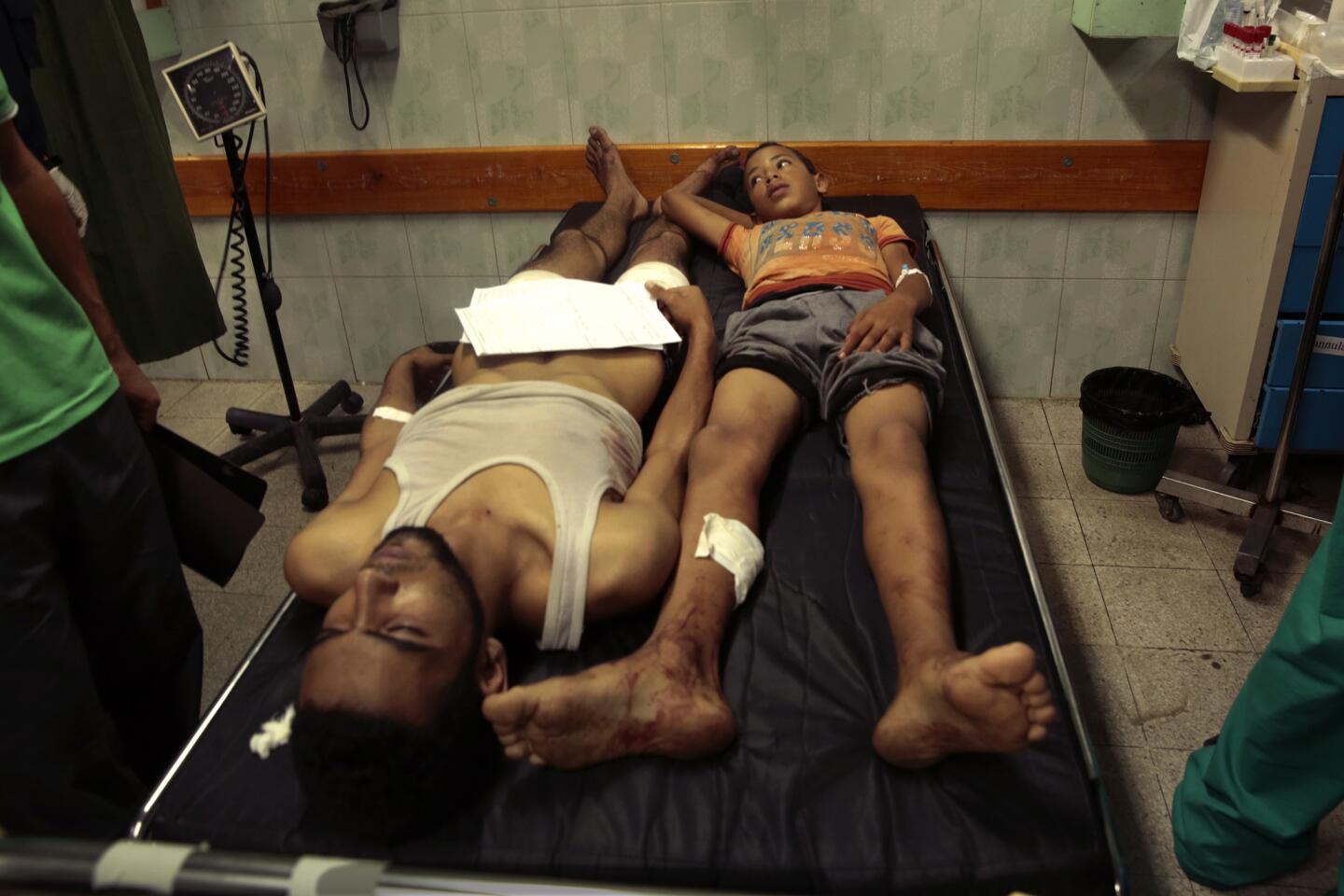
An injured boy and man share a gurney in the emergency room of the Jabaliya hospital after an attack on a U.N.-run school converted into a shelter in Beit Hanoun in the Gaza Strip. (Carolyn Cole / Los Angeles Times)
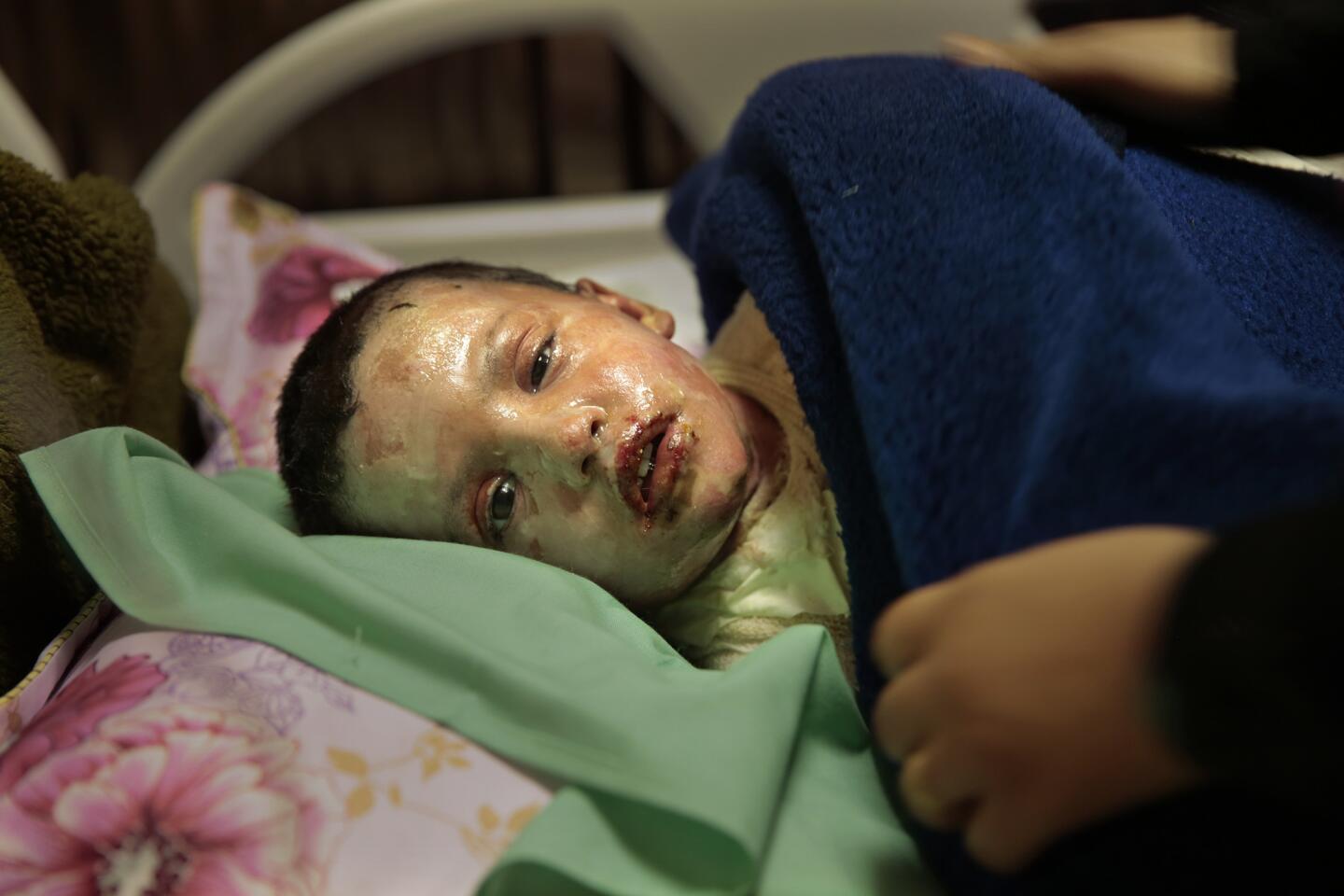
A girl who suffered serious burns when her family’s home was hit by an Israeli airstrike recuperates at a hospital in Khan Yunis in the Gaza Strip. (Carolyn Cole / Los Angeles Times)
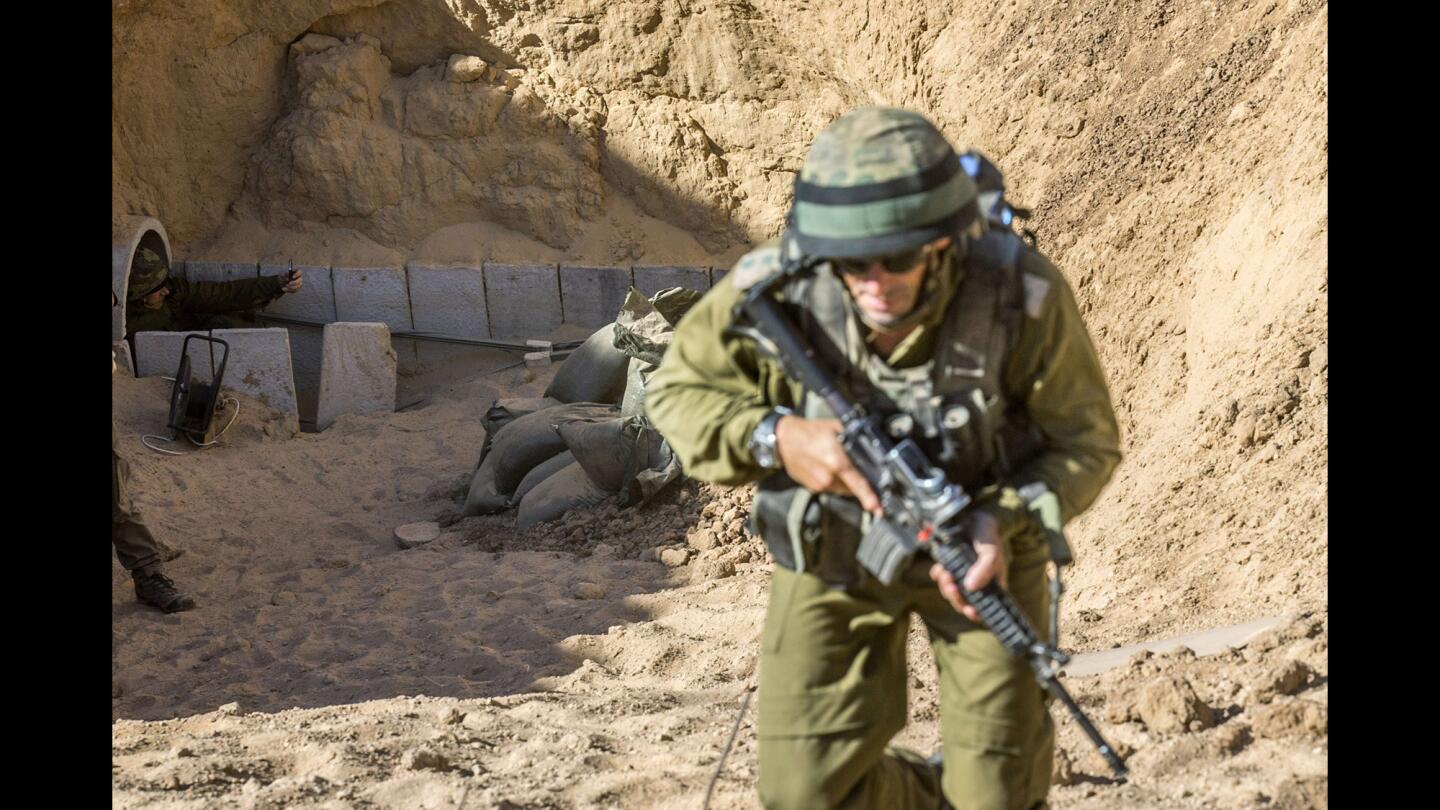
An Israeli soldier walks away from the entrance of a tunnel said to be used by Palestinian militants for cross-border attacks. (Jack Guez / AFP/Getty Images)
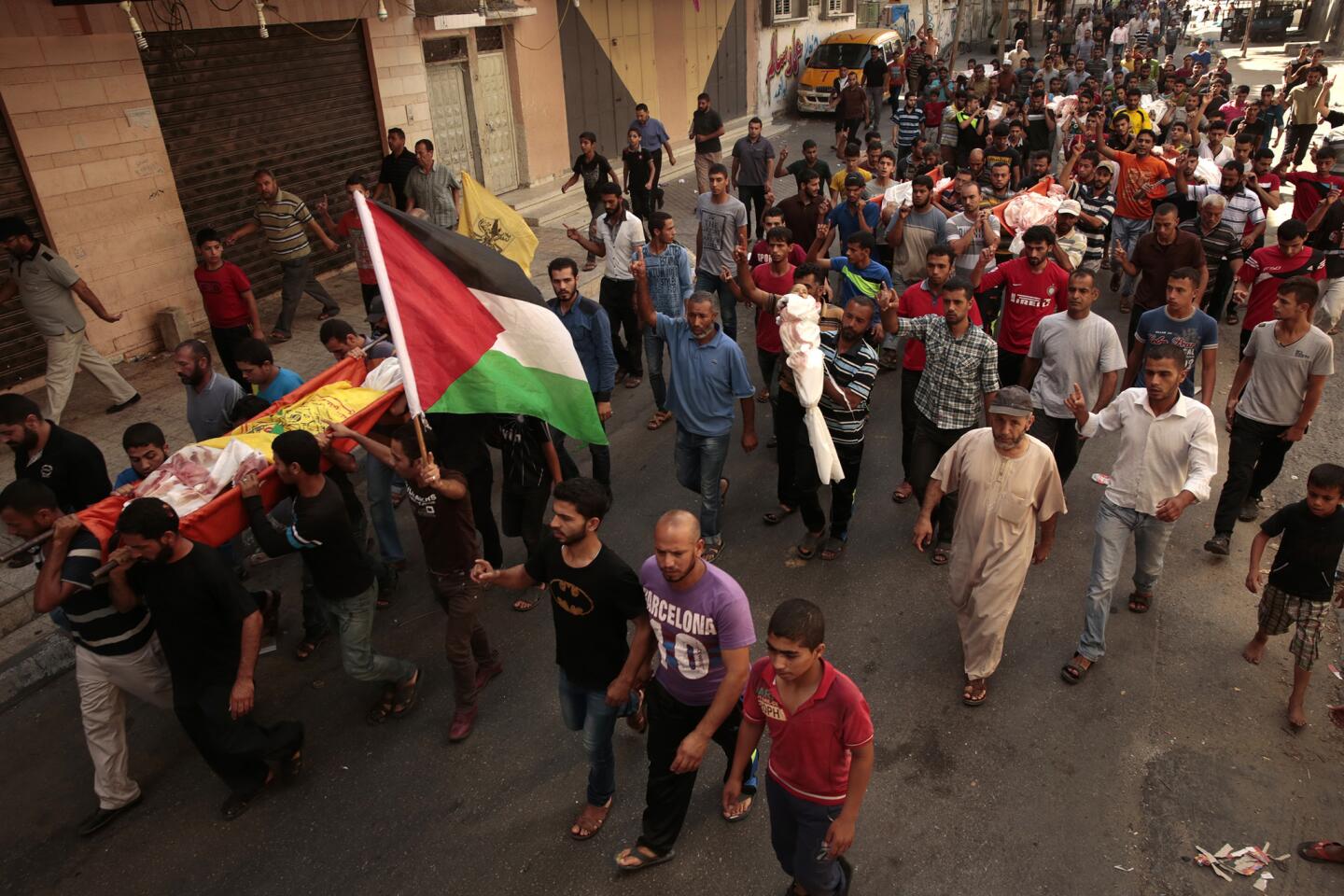
The 10 people who died in the shelling of the U.N. school shelter in Beit Hanoun are taken for burial. (For the Record: An earlier version of this caption, and those accompanying three additional photos, erred in assessing blame for the shelling, which is still being investigated.) (Carolyn Cole / Los Angeles Times)
Advertisement
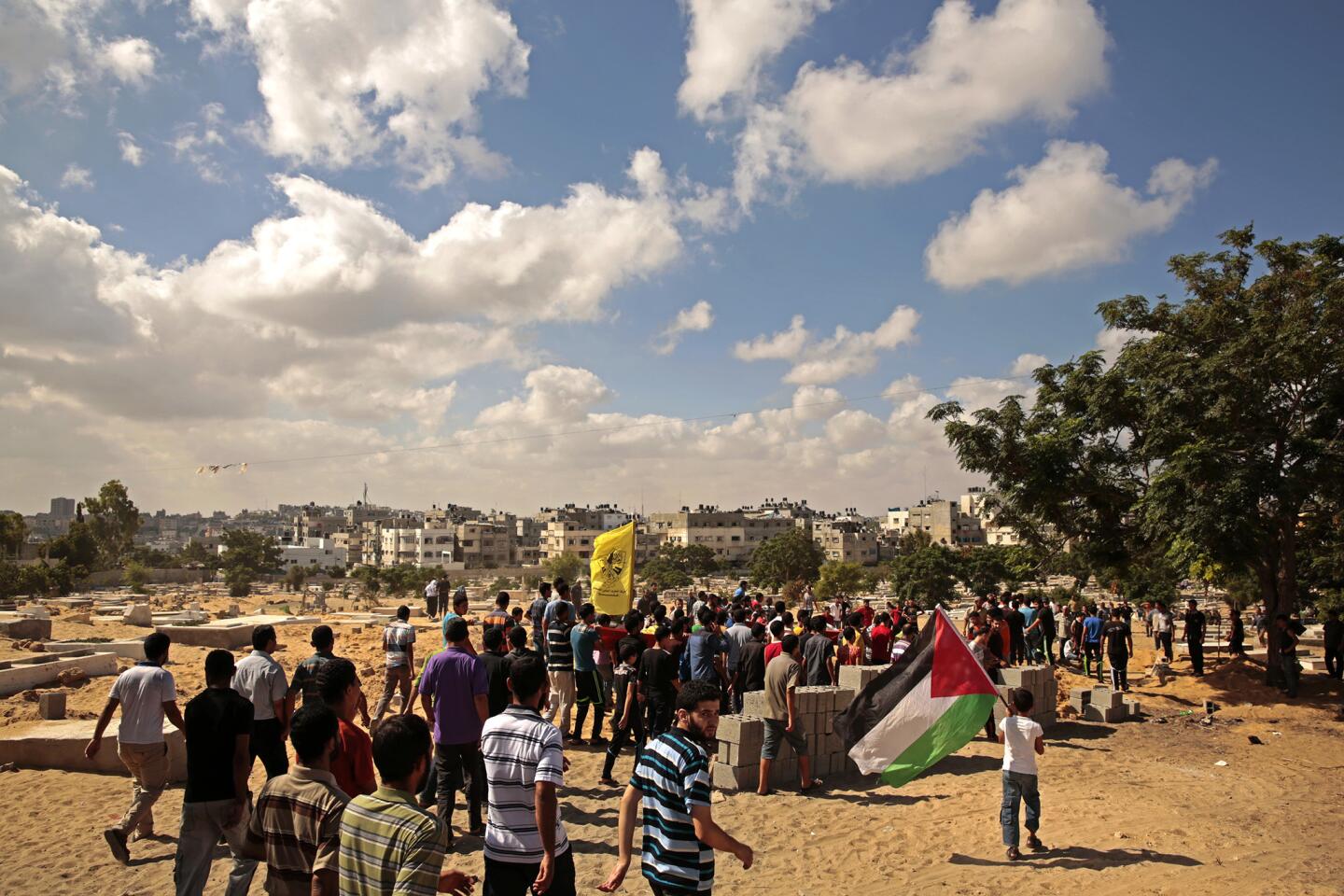
Ten people who died in the shelling of the U.N. school shelter in Beit Hanoun are taken for burial. (Carolyn Cole / Los Angeles Times)
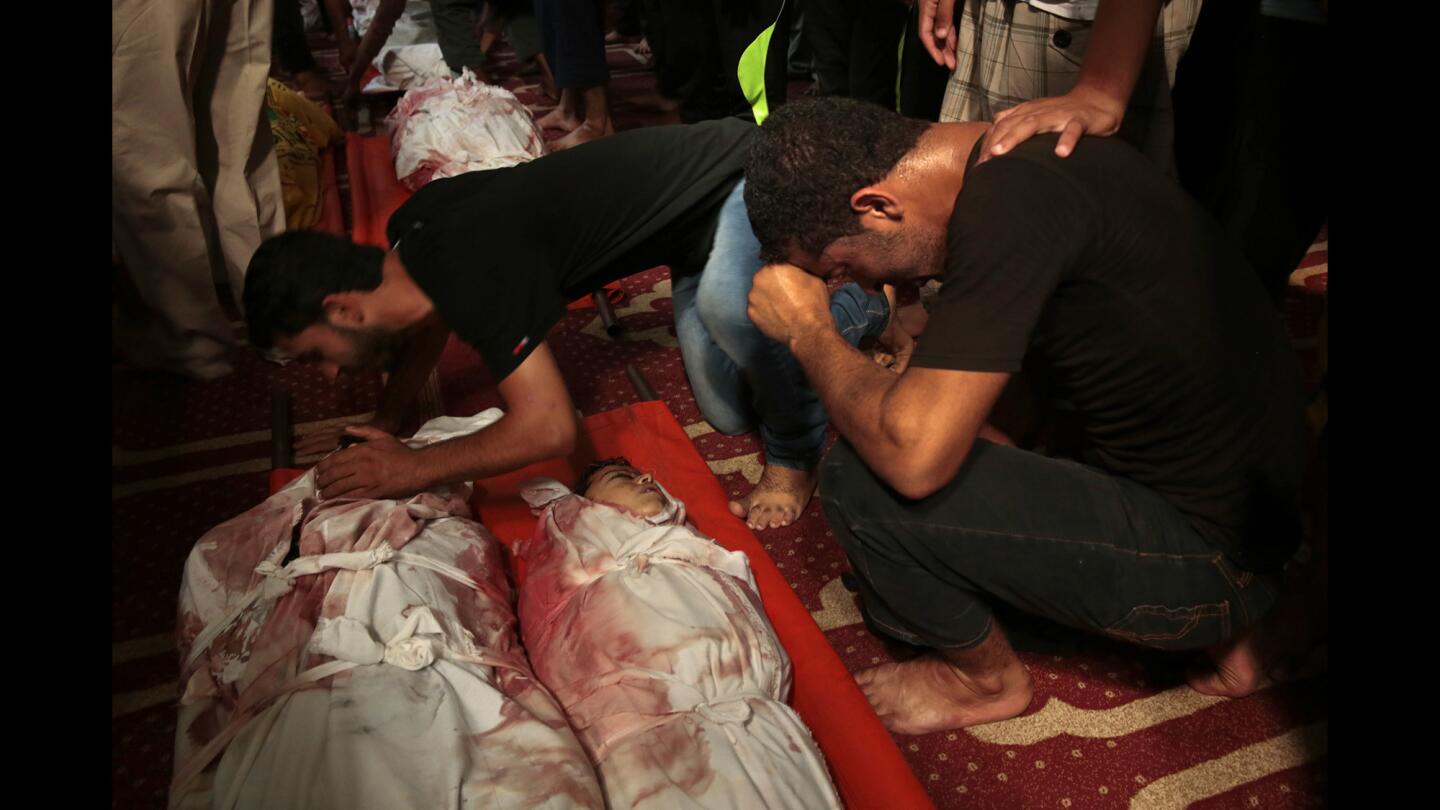
The people who died in the shelling of the U.N. school shelter in Beit Hanoun are taken for burial, including one baby, and two young boys. (Carolyn Cole / Los Angeles Times)
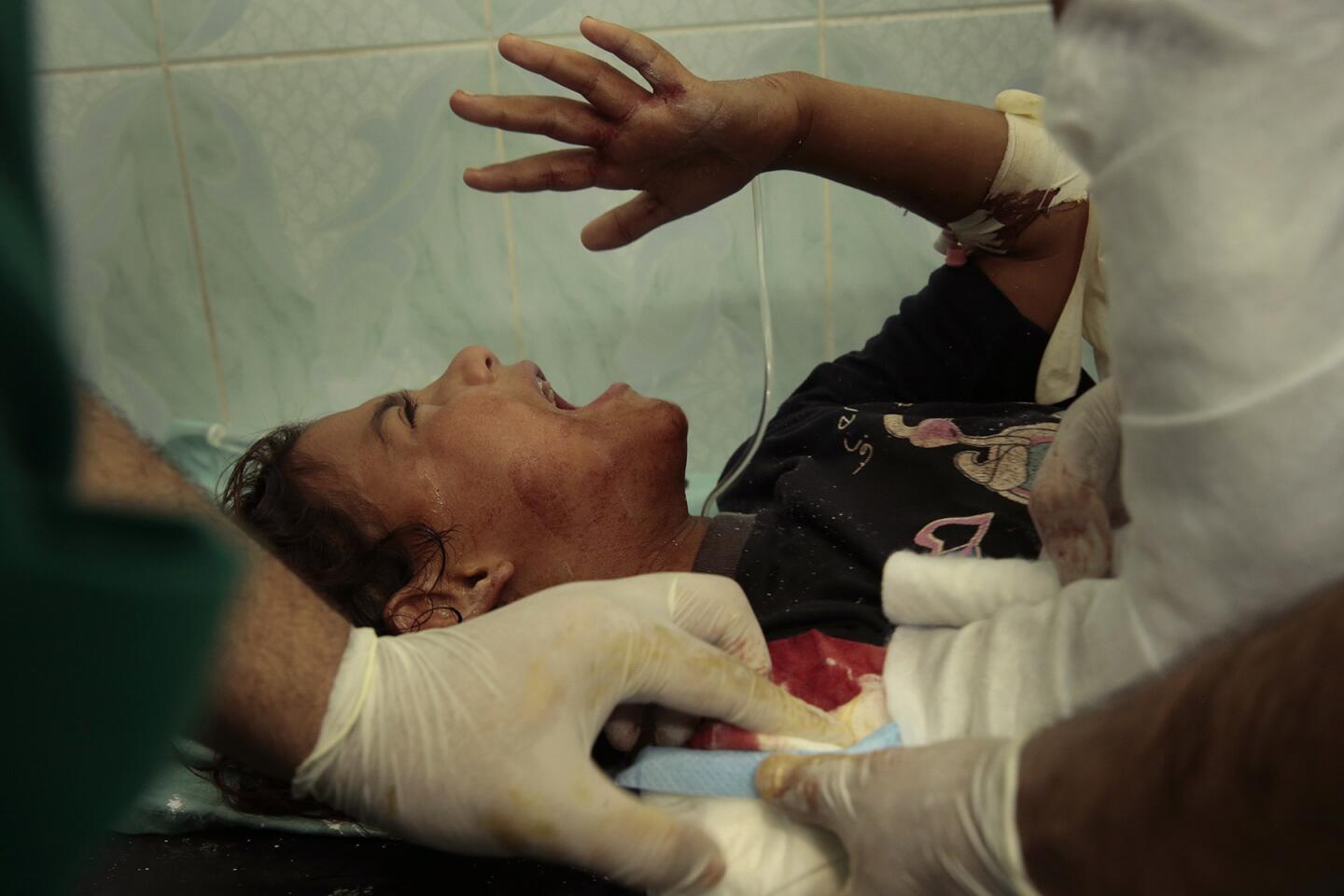
Eight-year-old Mahasen Mohammed El Shenbary screams in pain from a shrapnel wound in her arm at Jabalia hospital. She was one of more than 100 people injured at a U.N. shelter. (Carolyn Cole / Los Angeles Times)
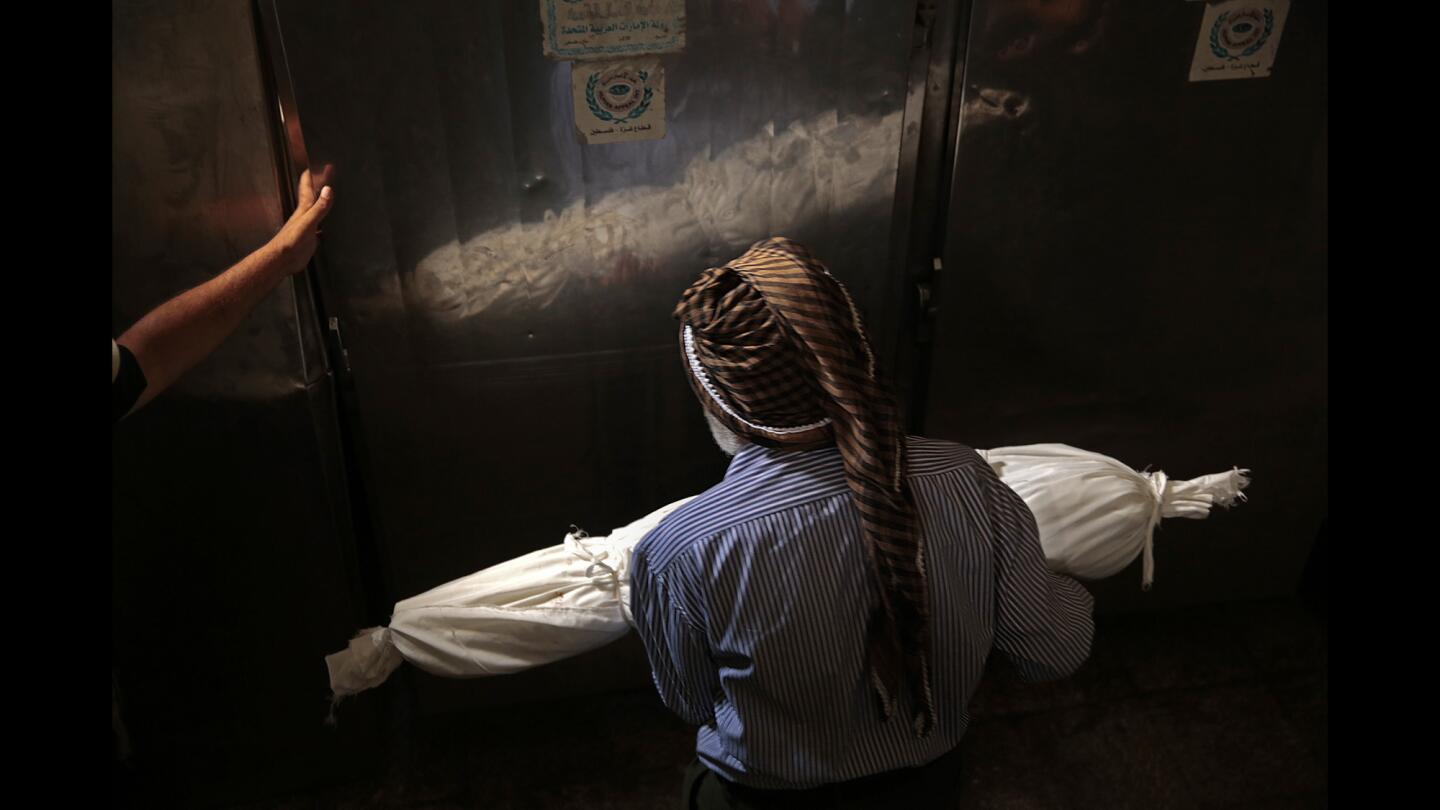
At least 12 people were killed and more than 100 injured when a U.N. shelter housing evacuees was shelled July 24. At the Jabalia hospital morgue, the body of a young child is placed in the cooler. (Carolyn Cole / Los Angeles Times)
Advertisement
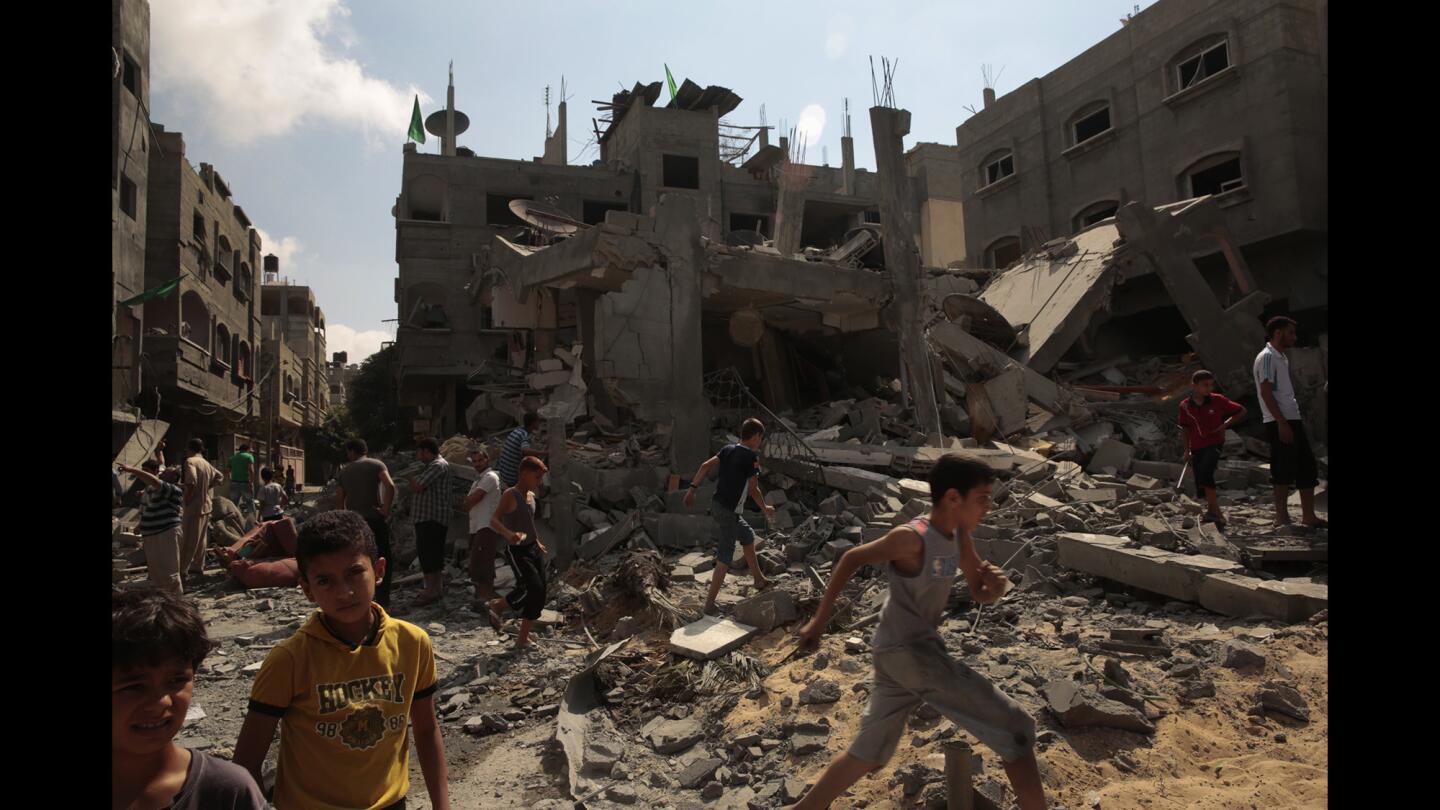
Children play at the site of a bombing in the town of Jabalia hit in an attack by Israeli’s. (Carolyn Cole / Los Angeles Times)
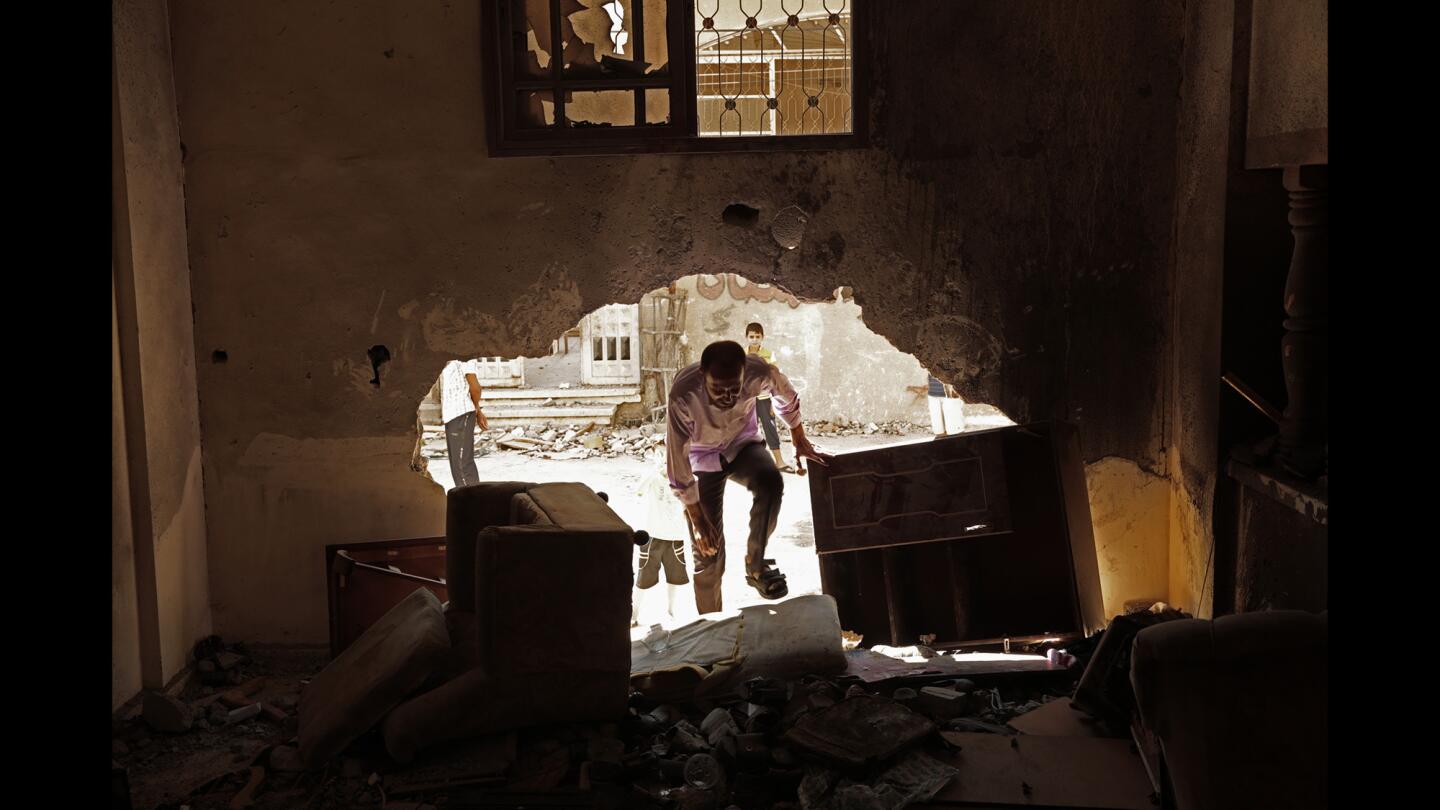
A man enters a building destroyed by overnight bombings in the town of Jabalia. (Carolyn Cole / Los Angeles Times)







